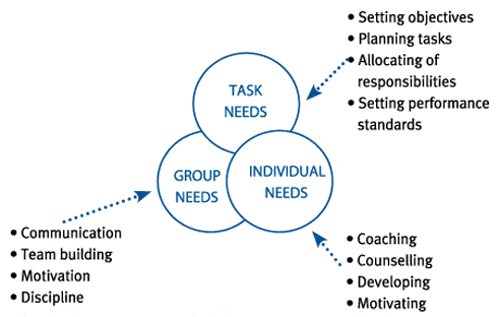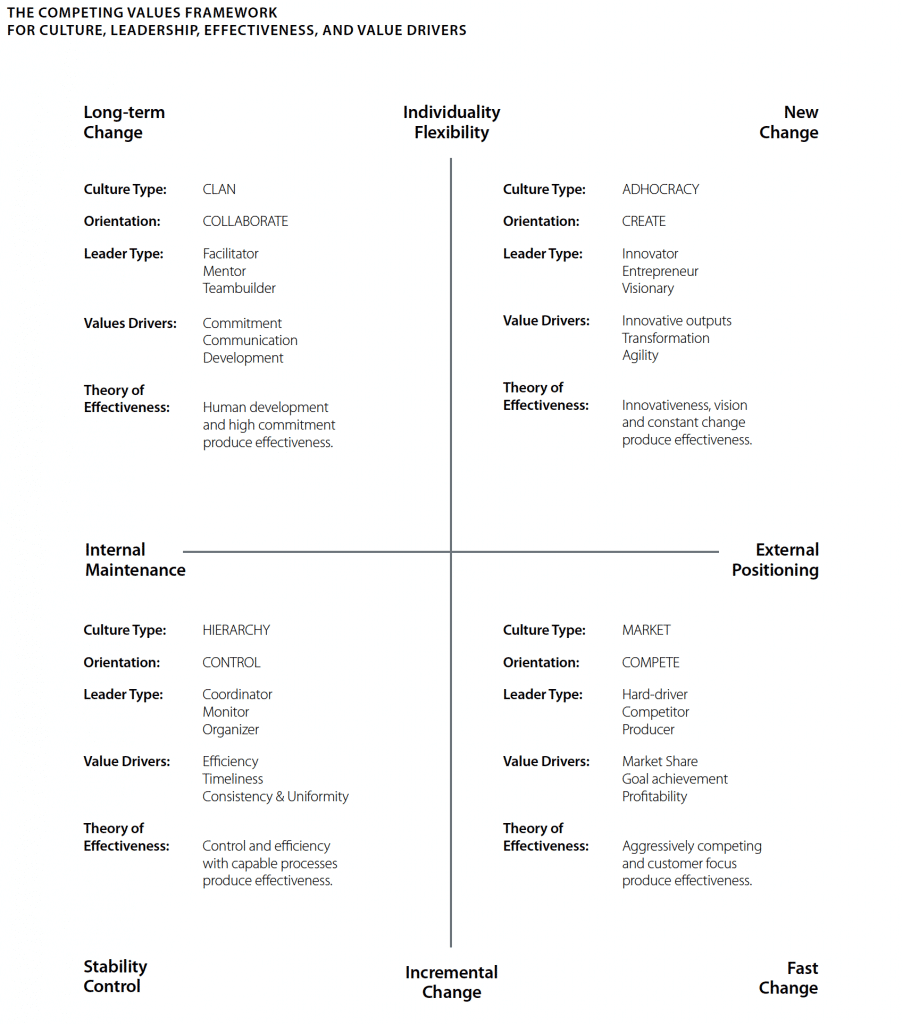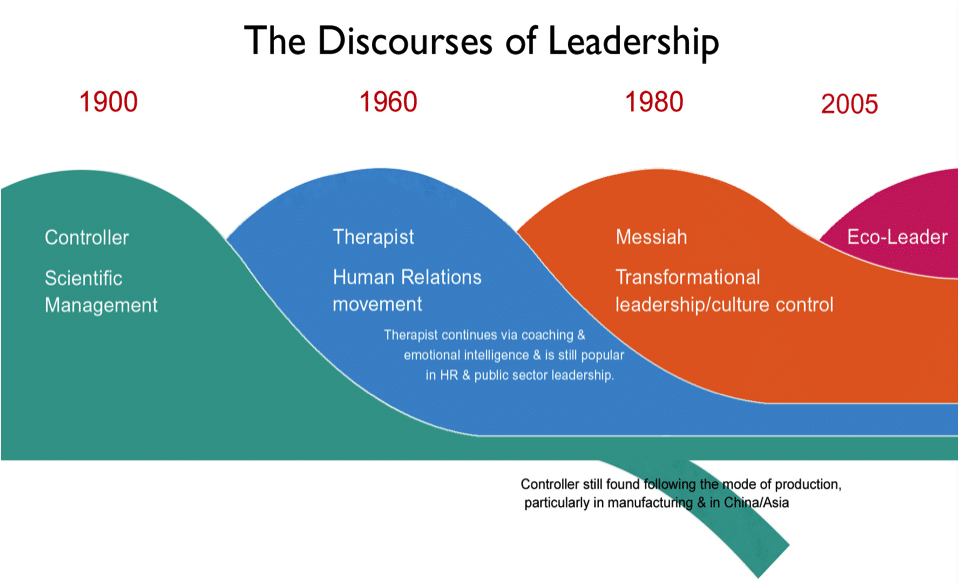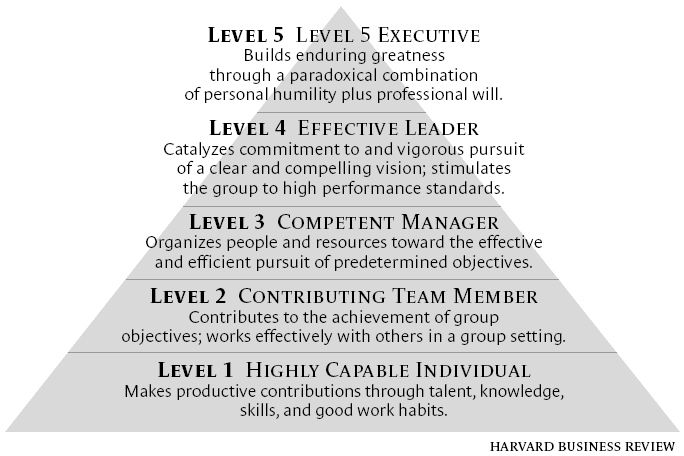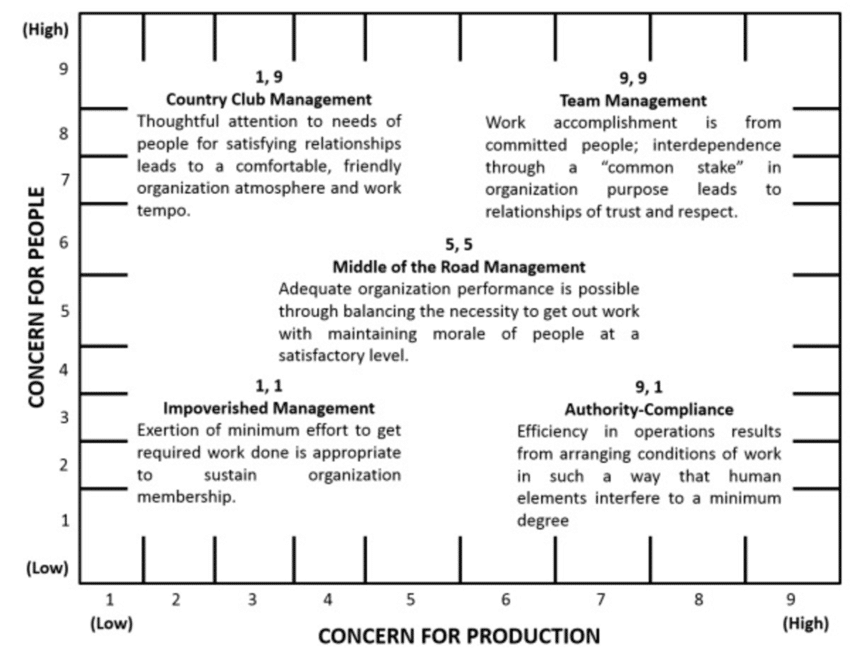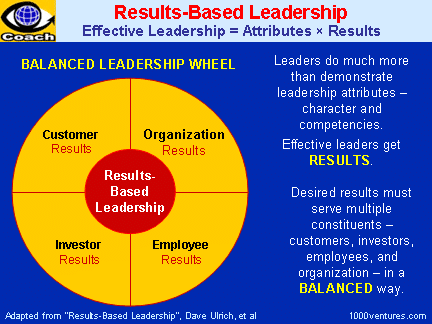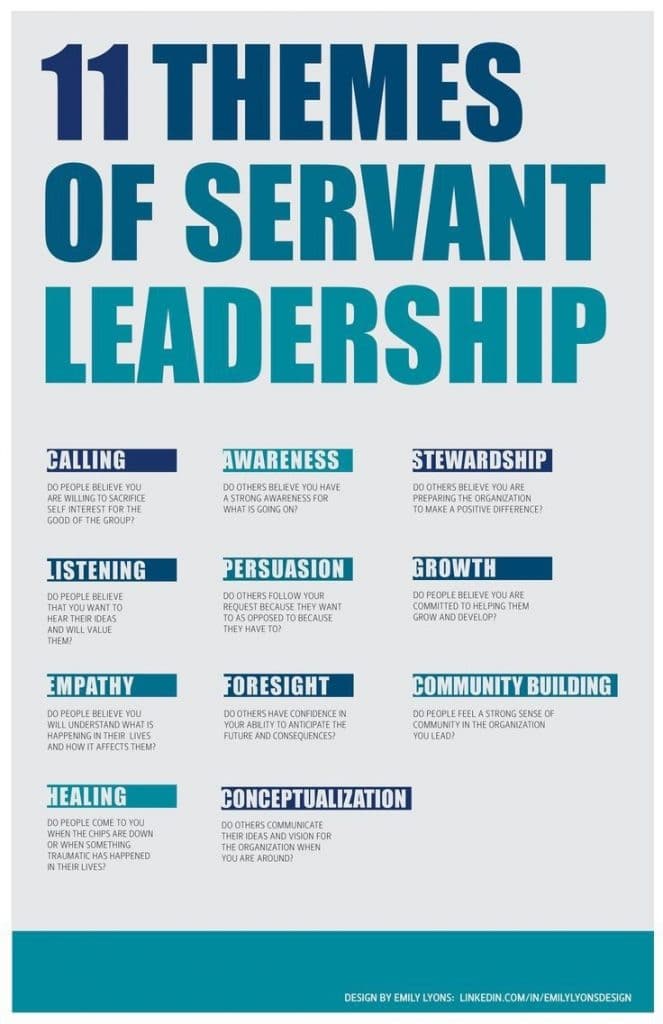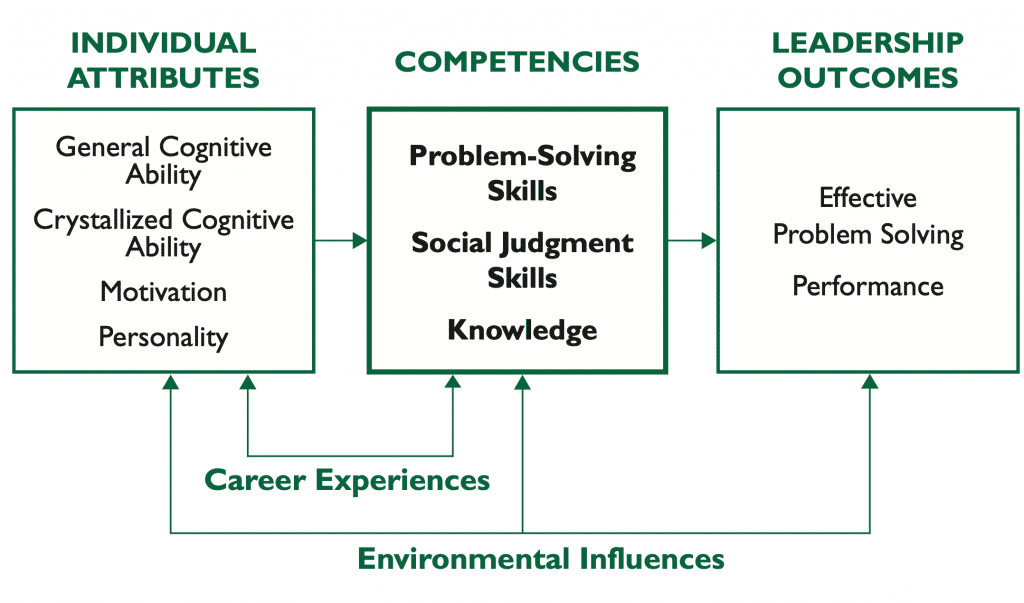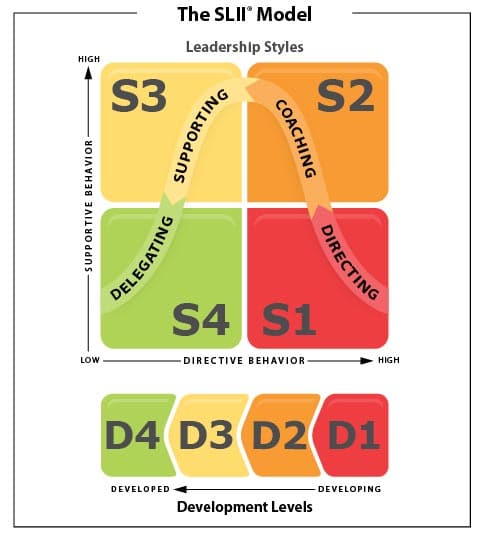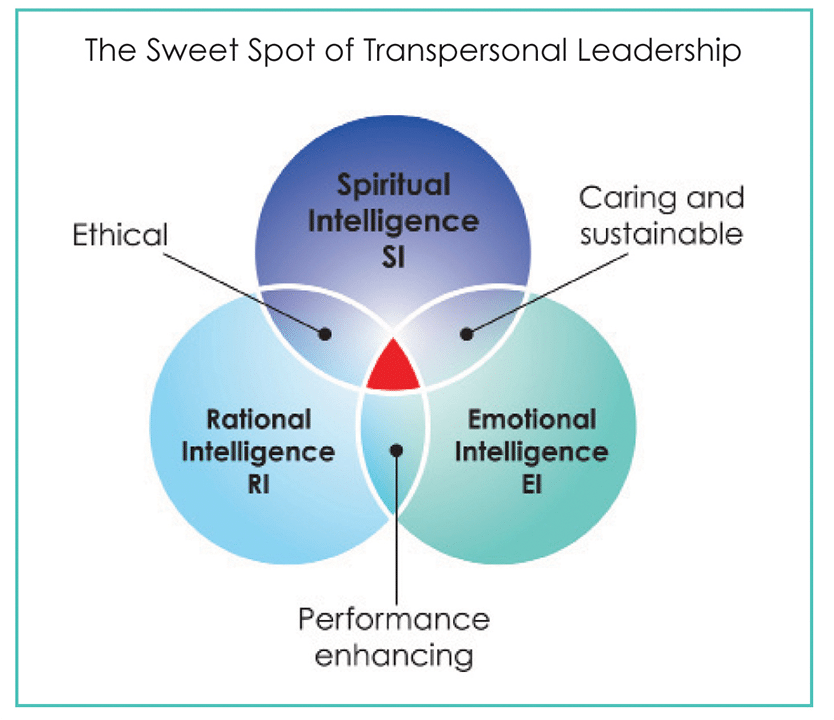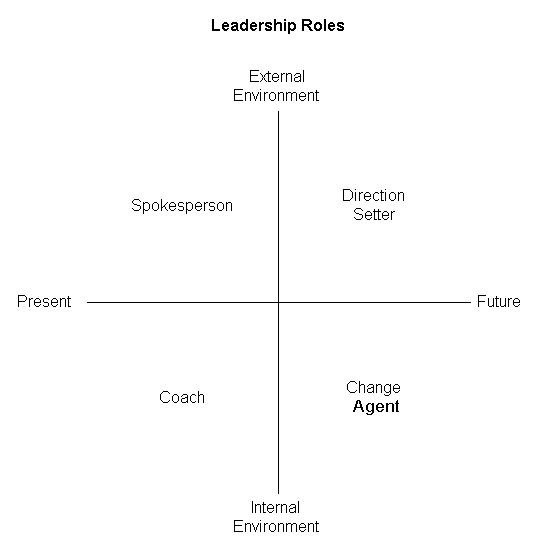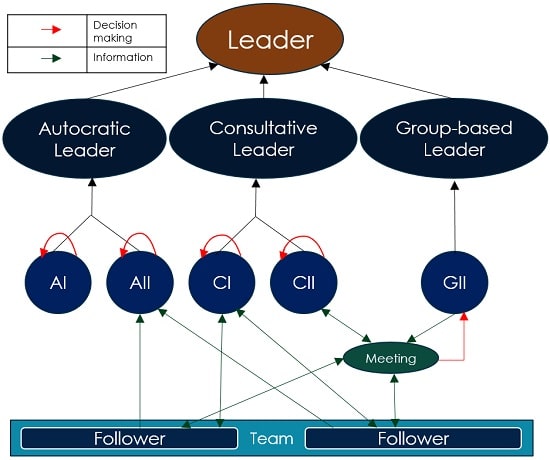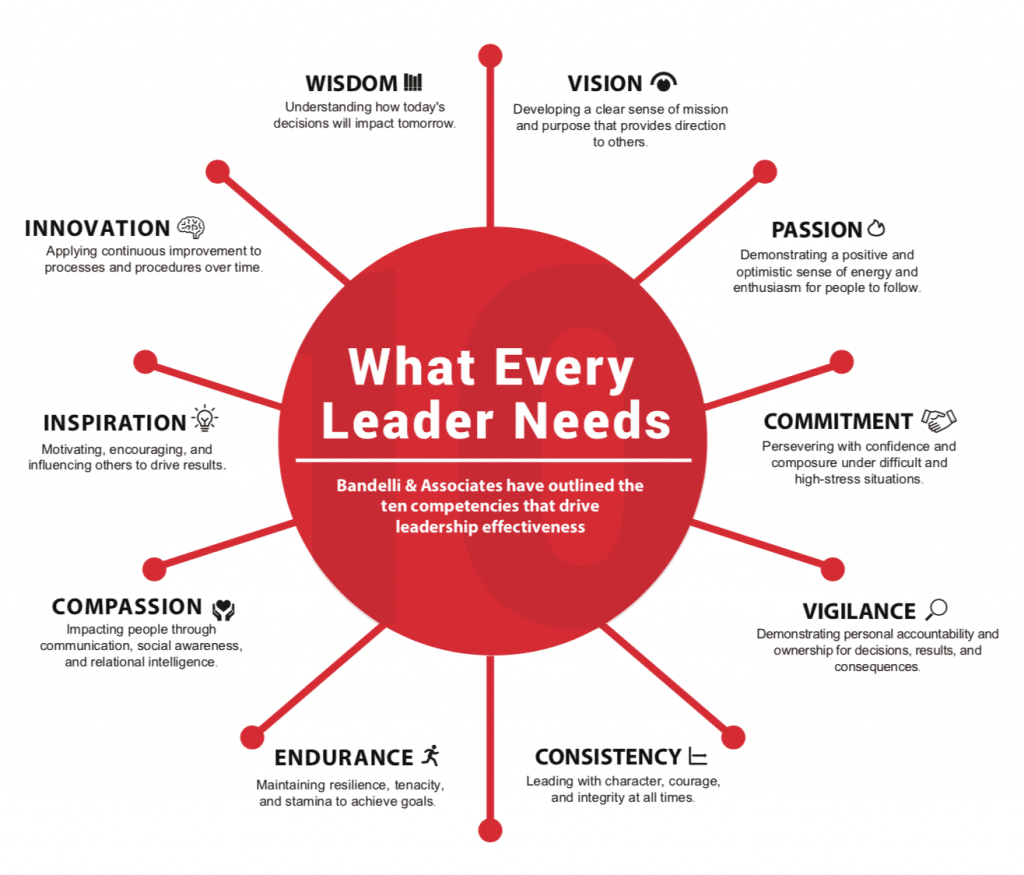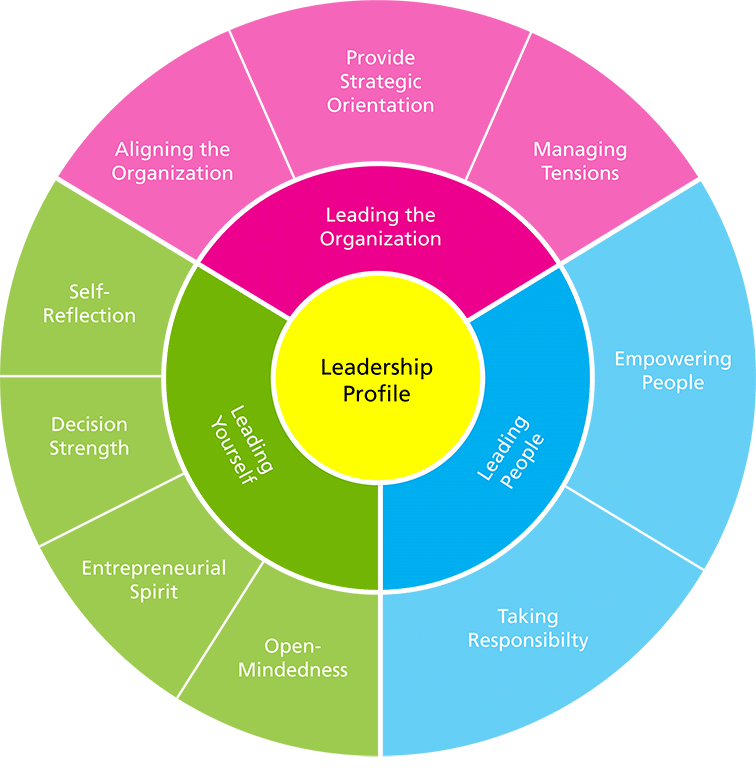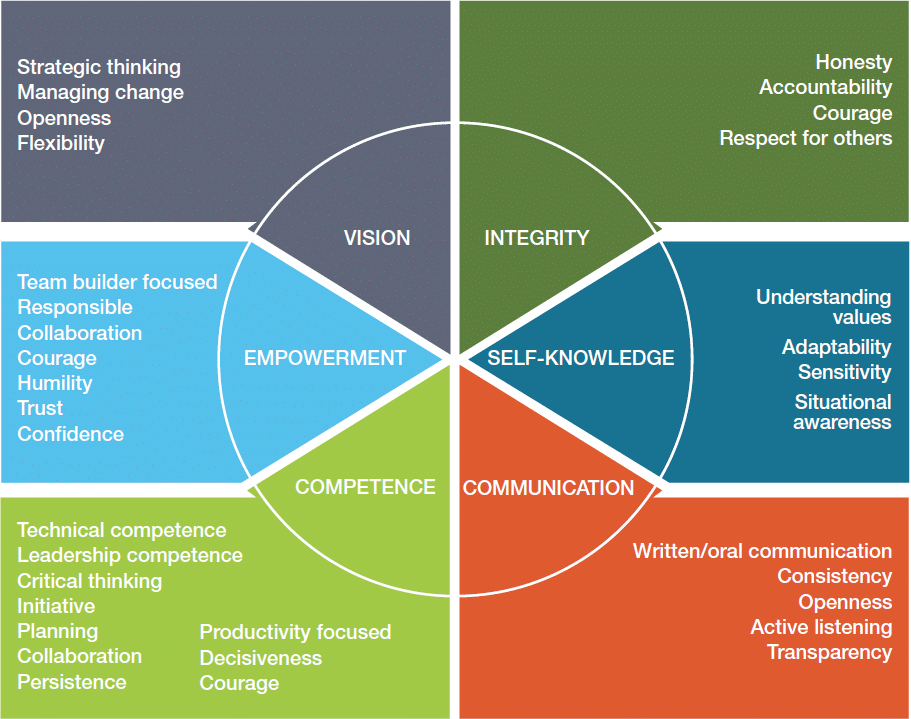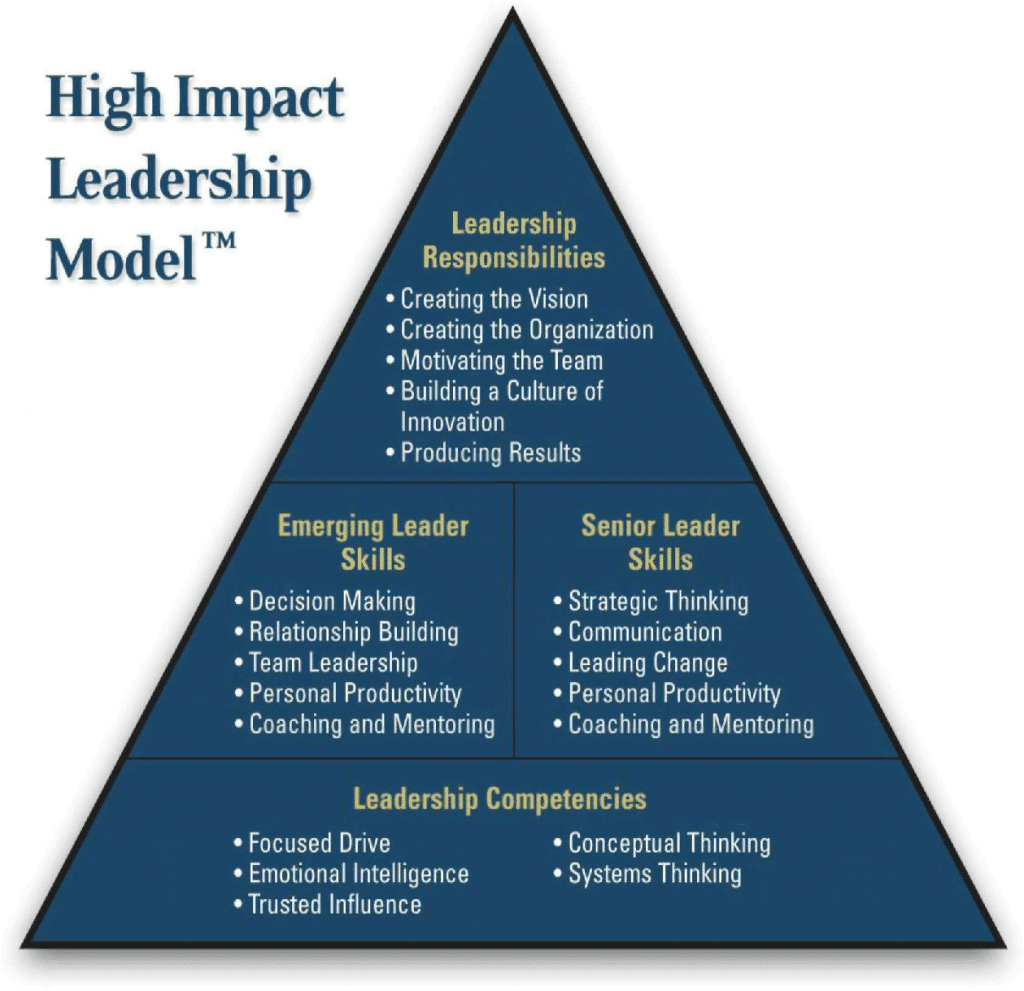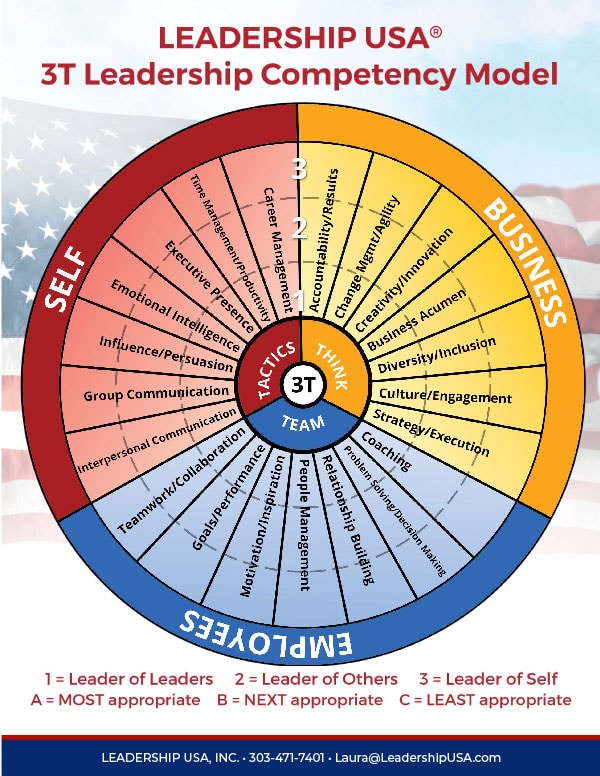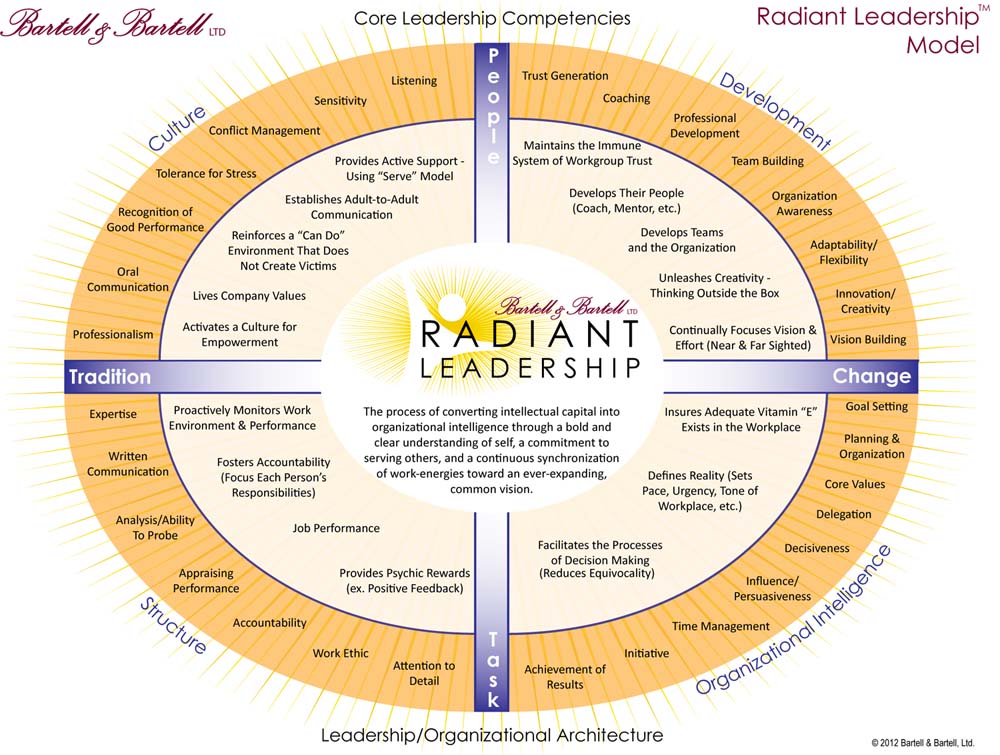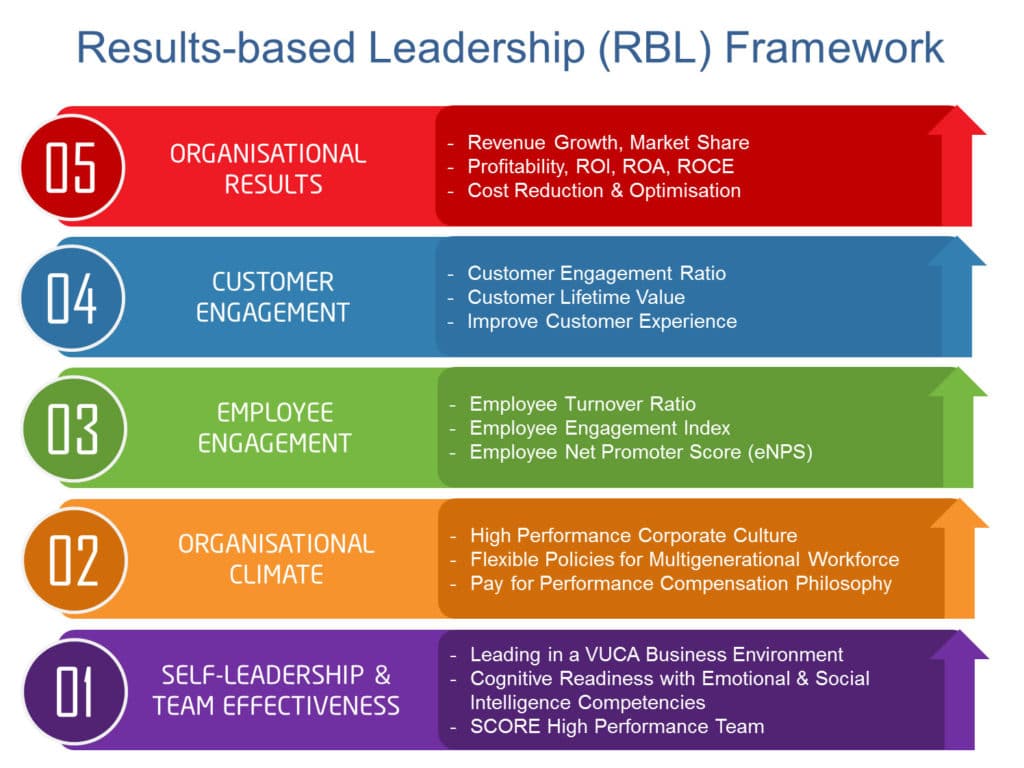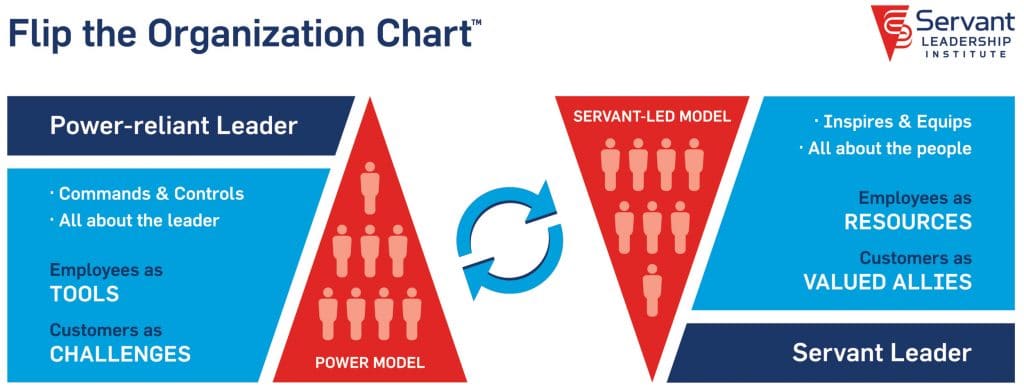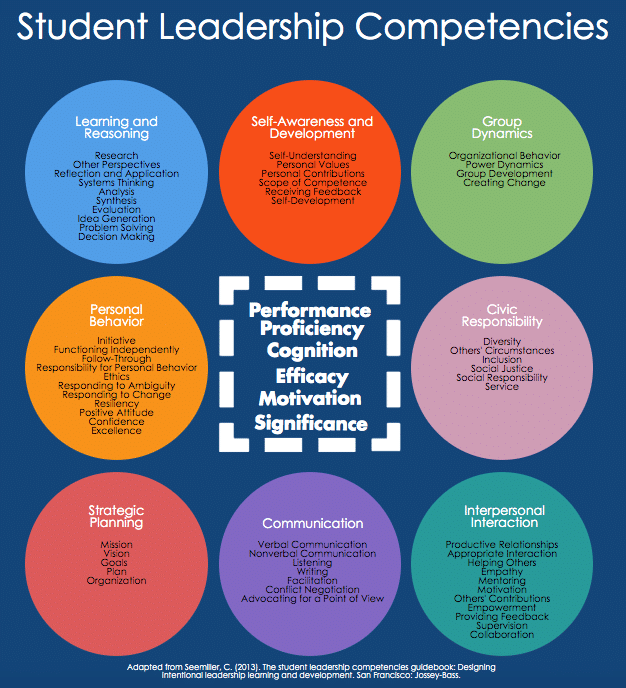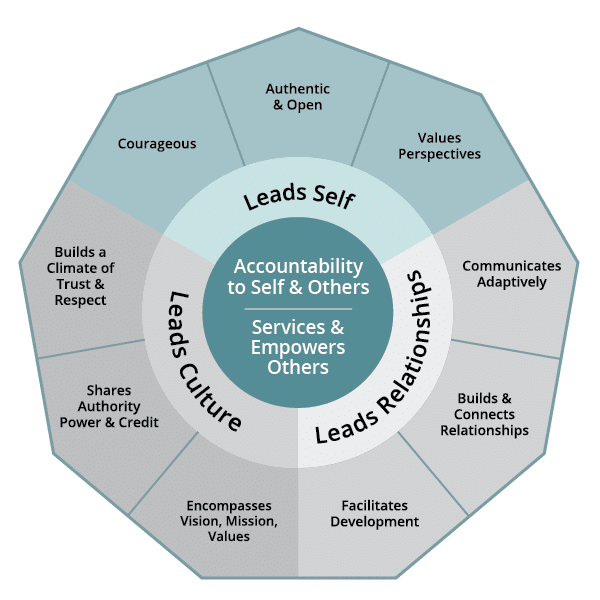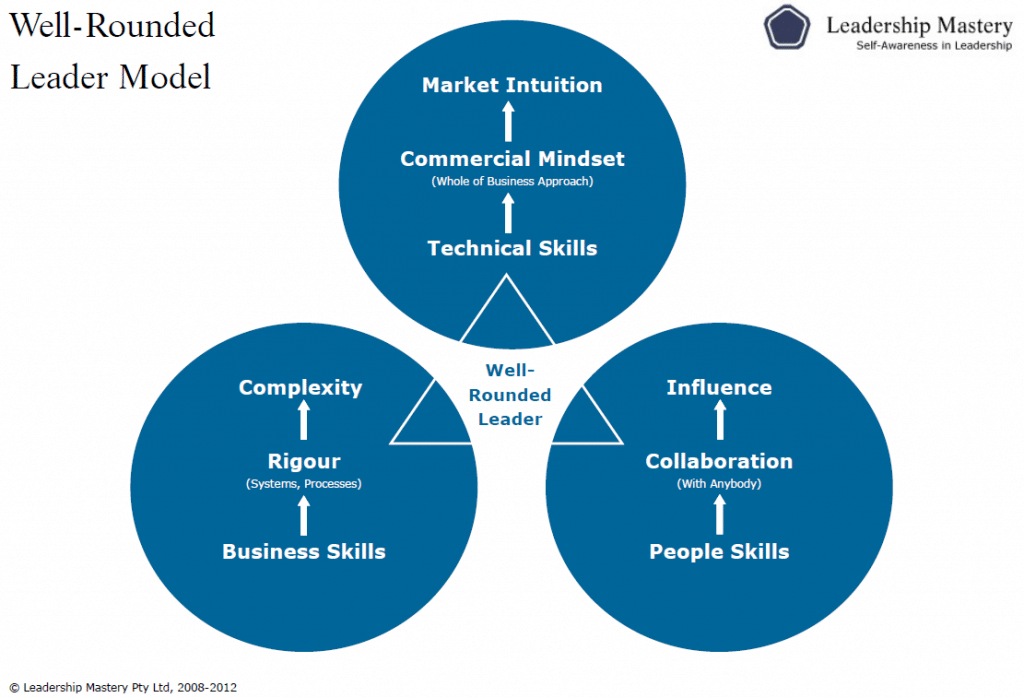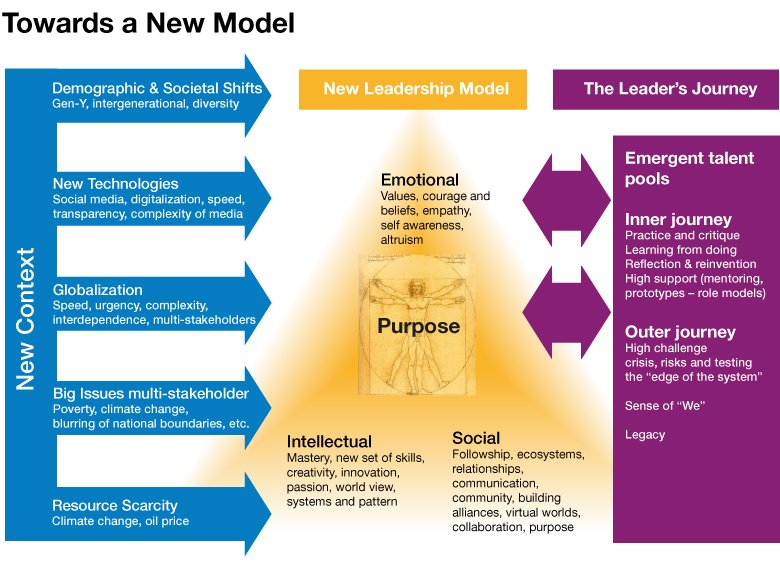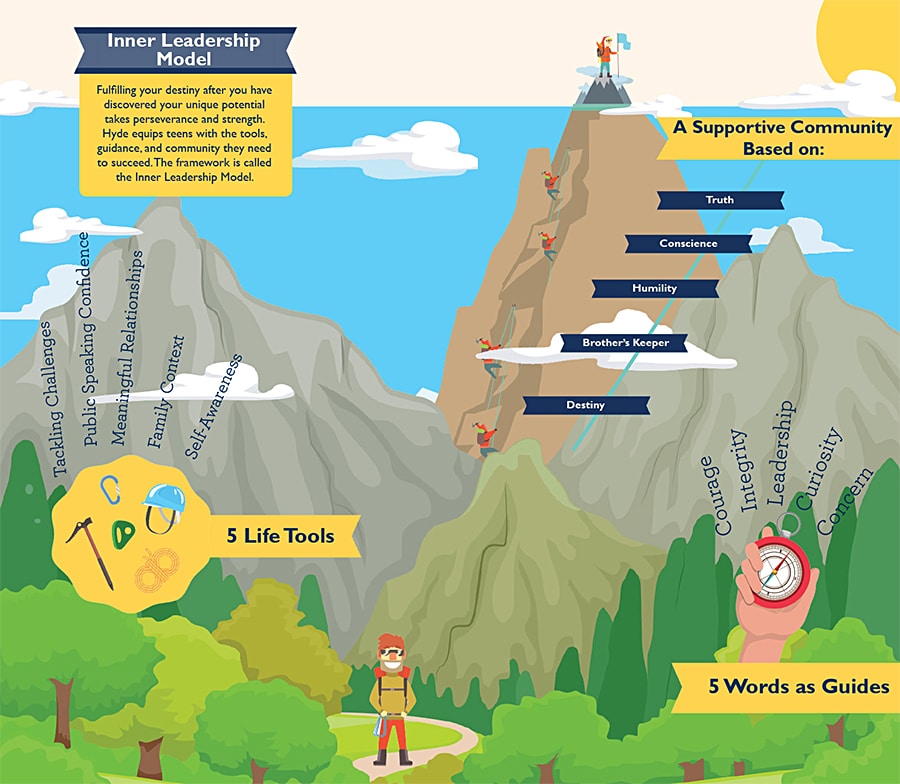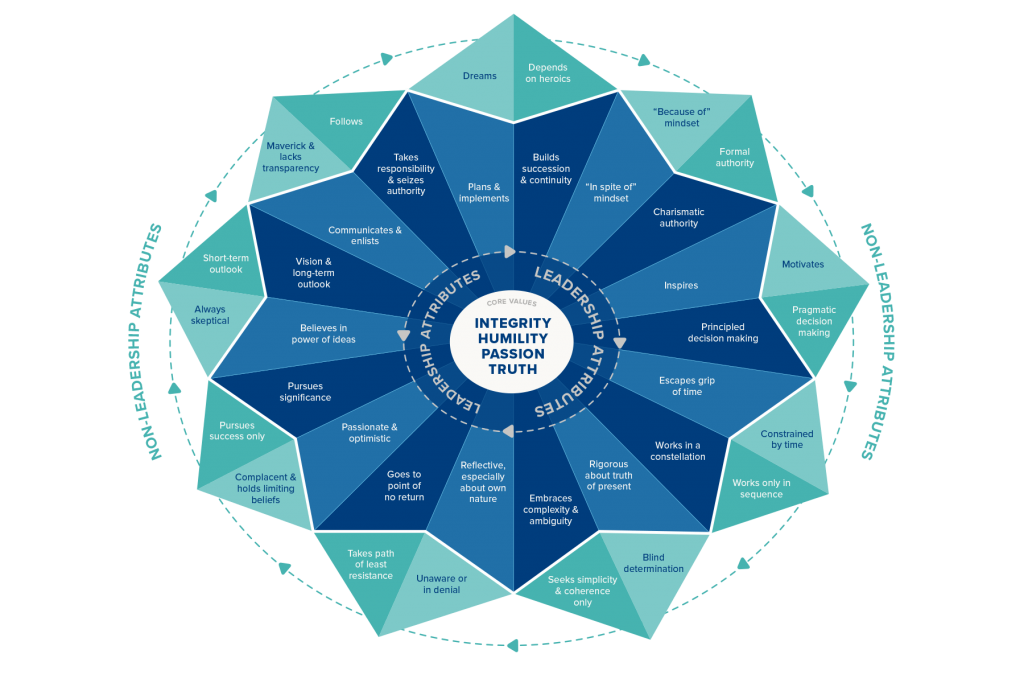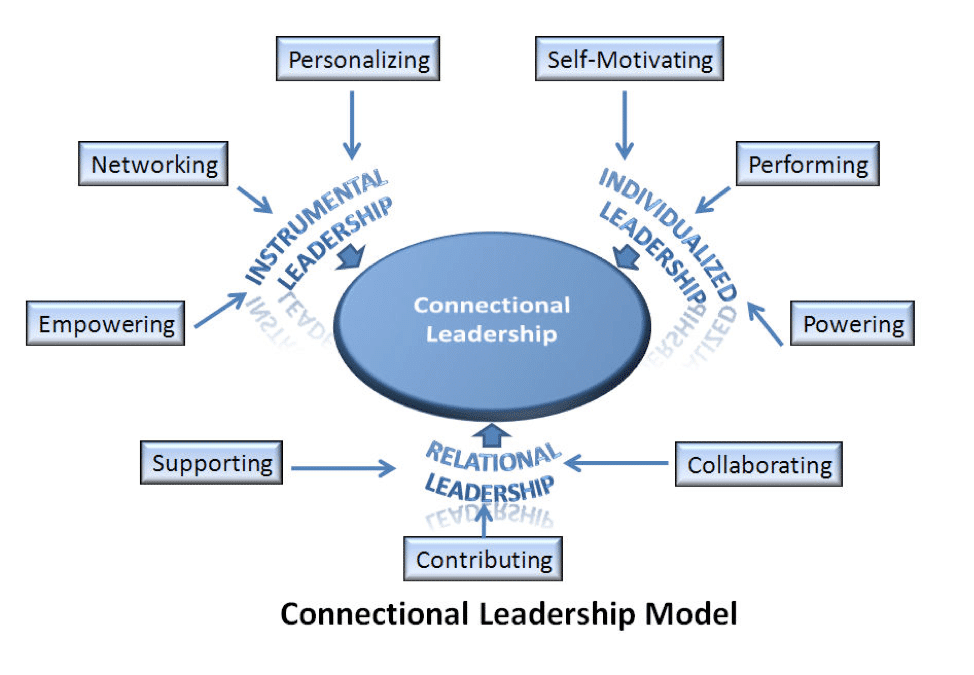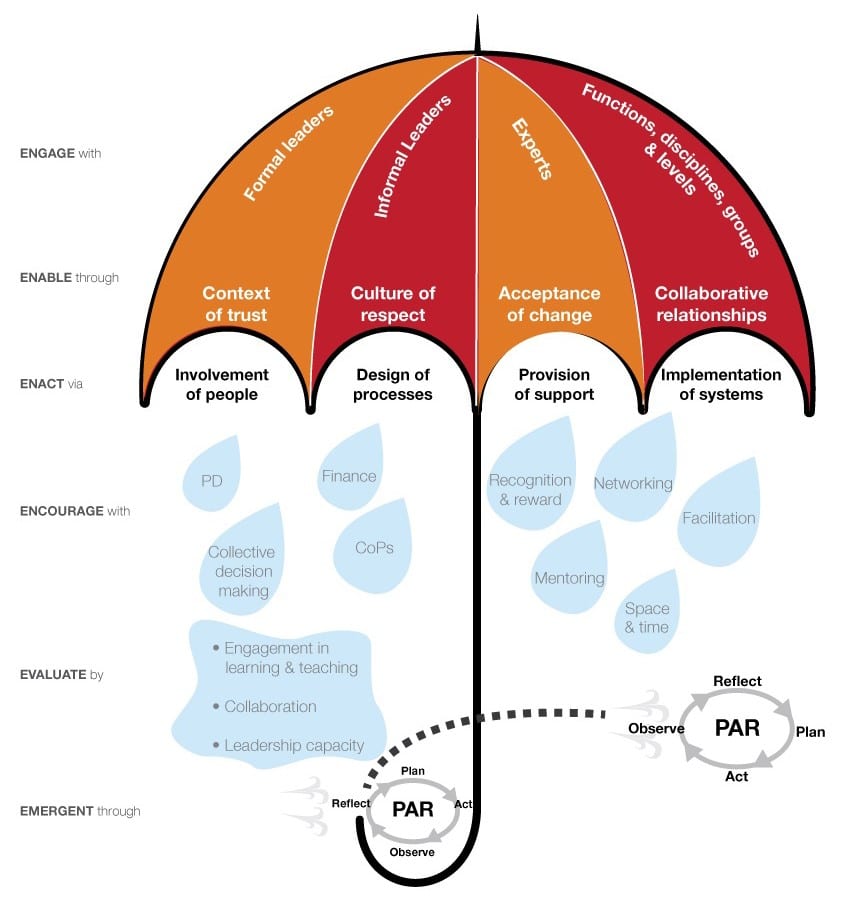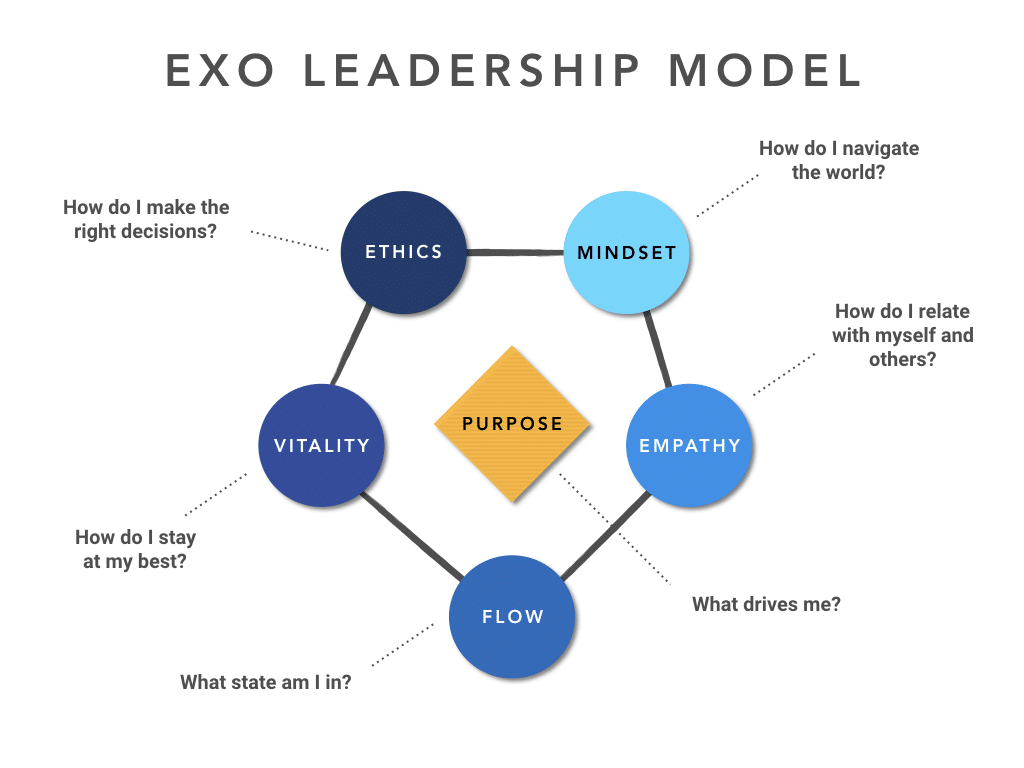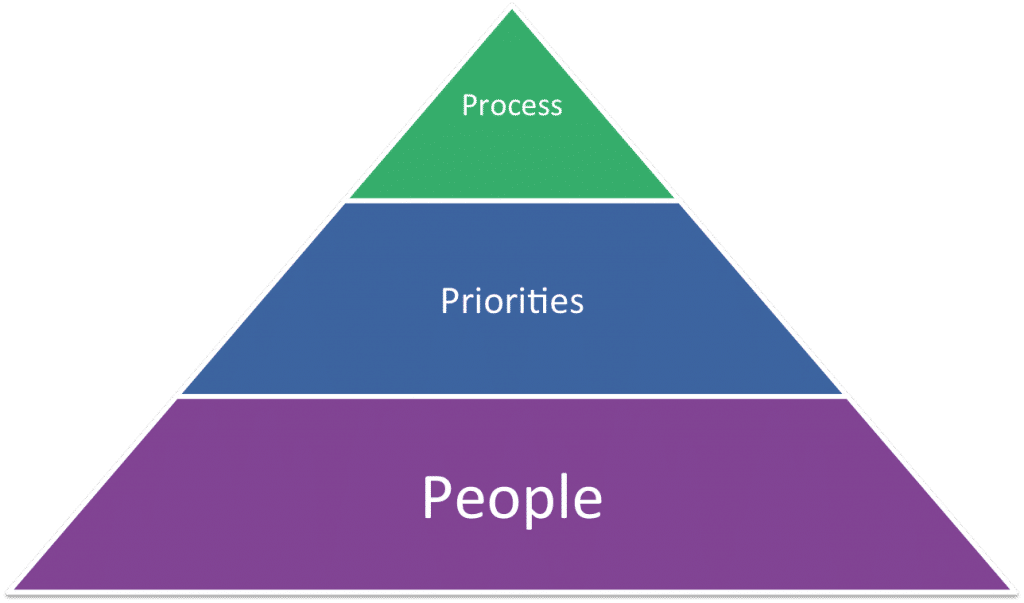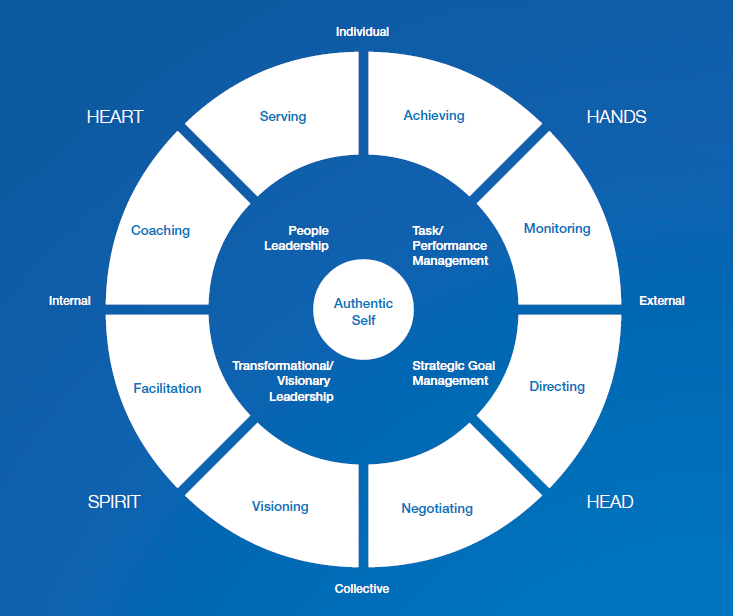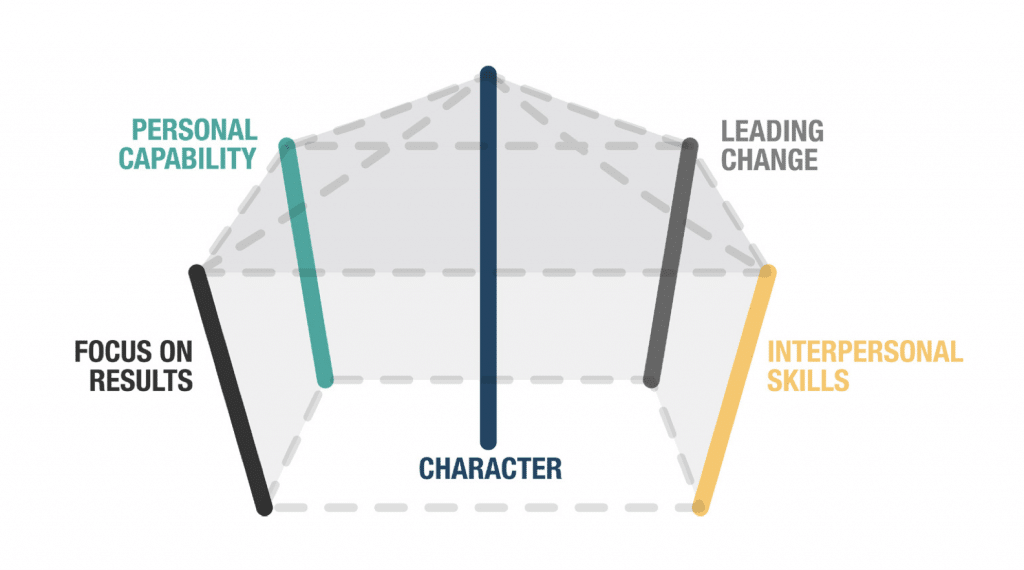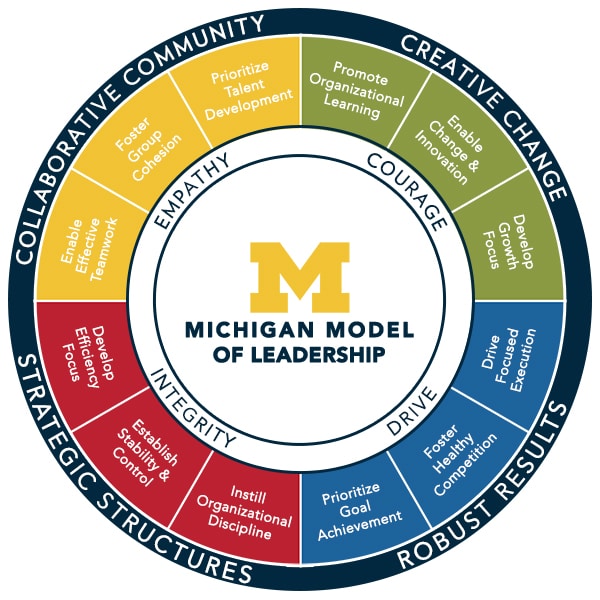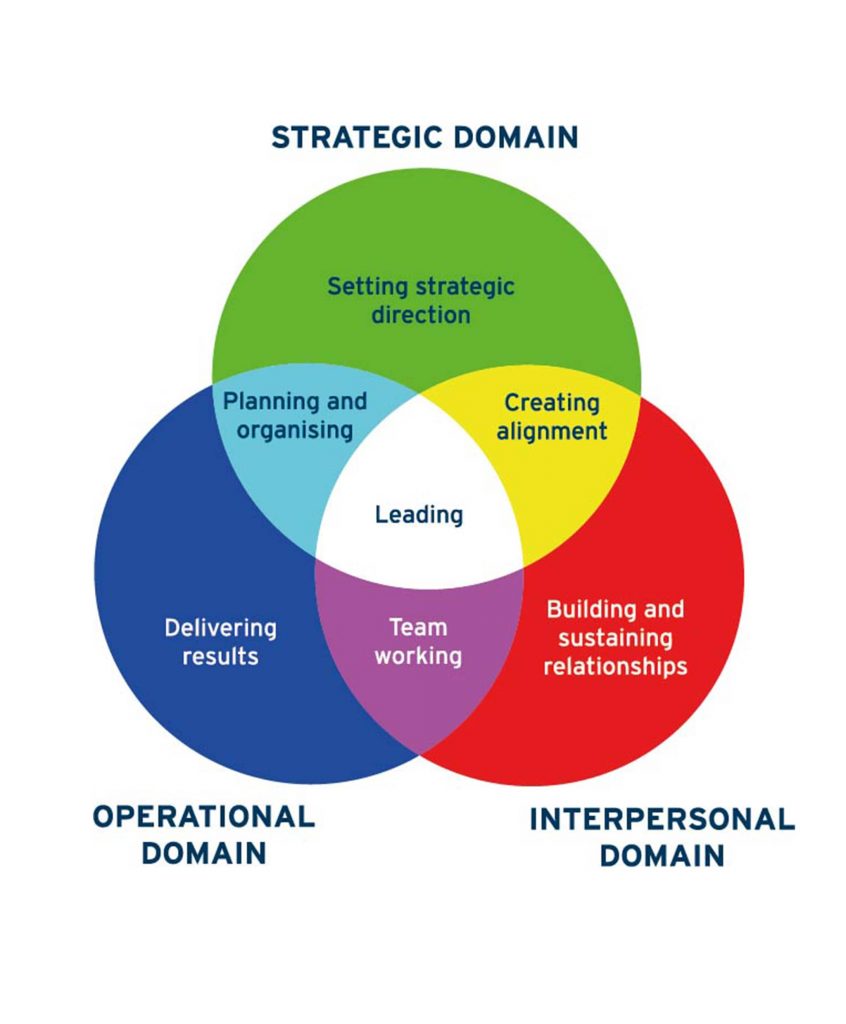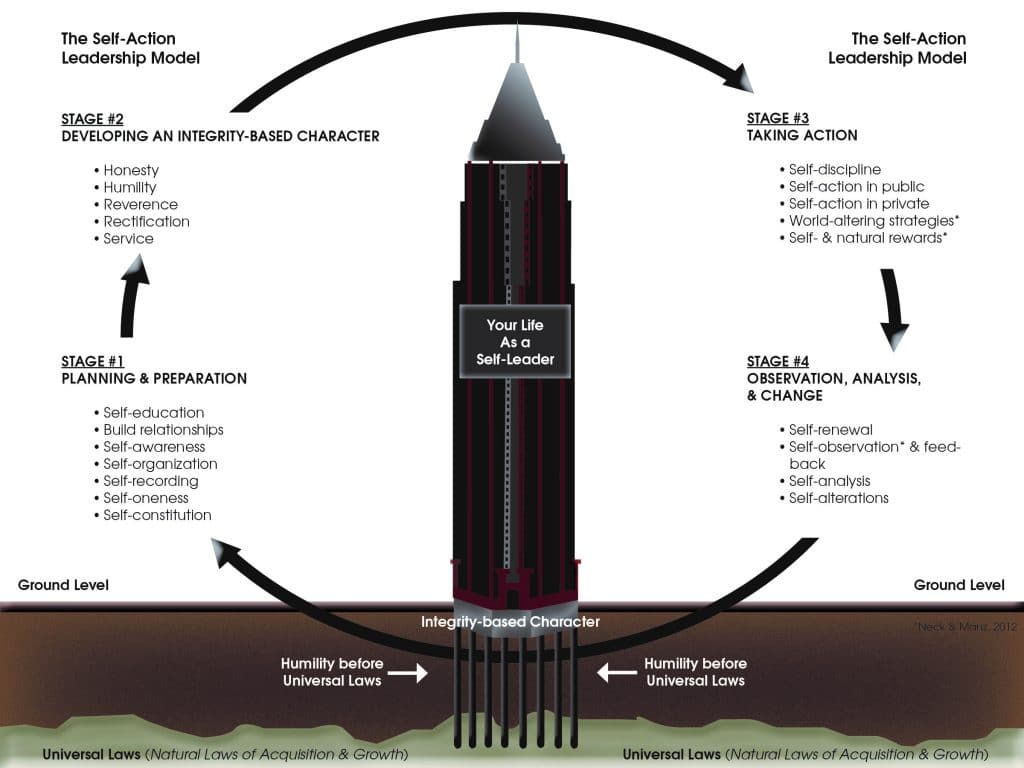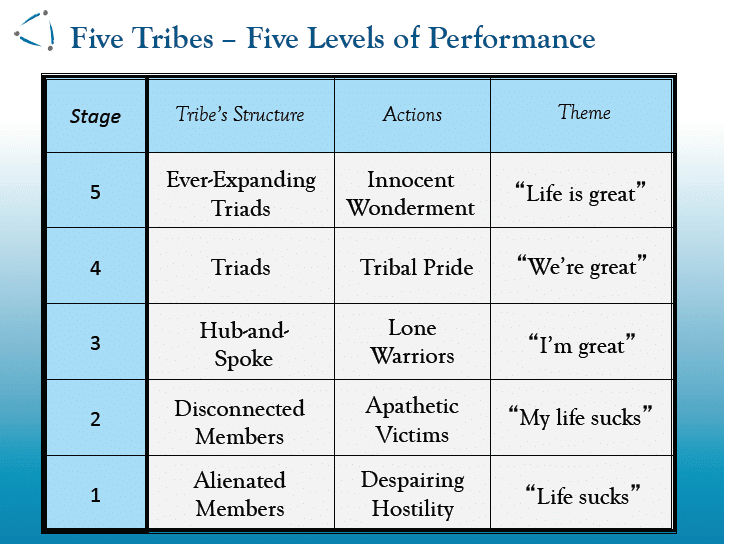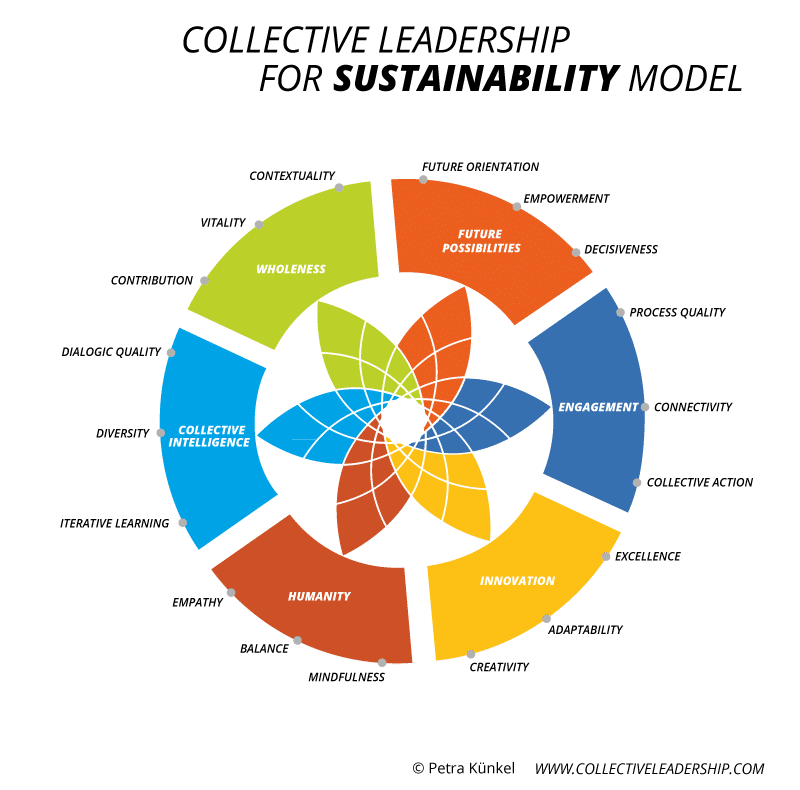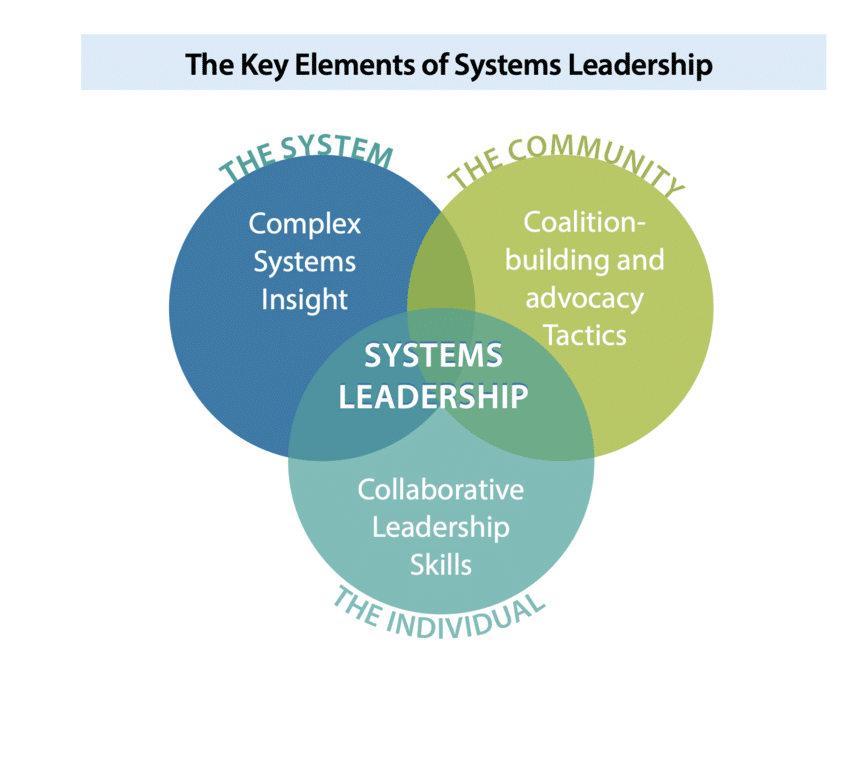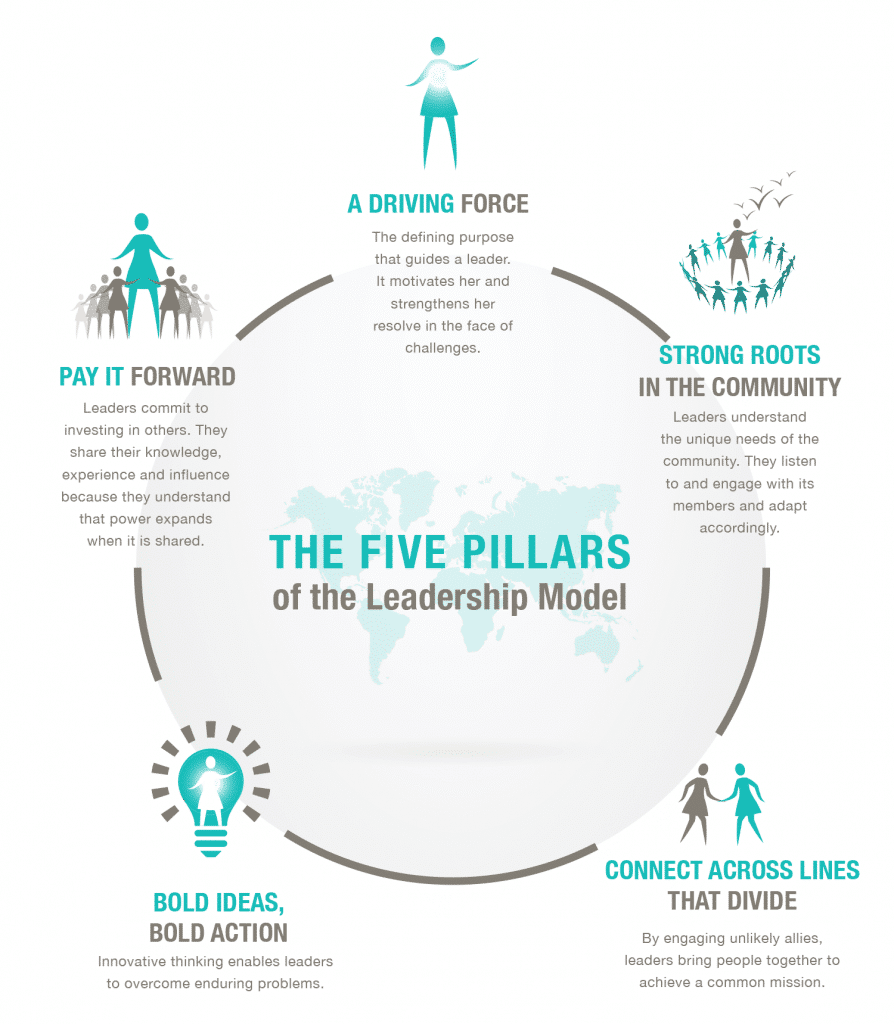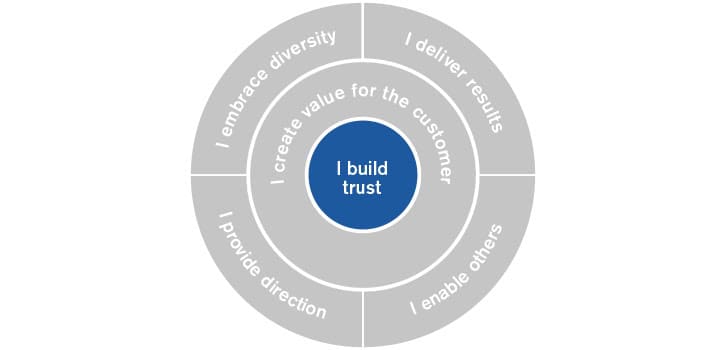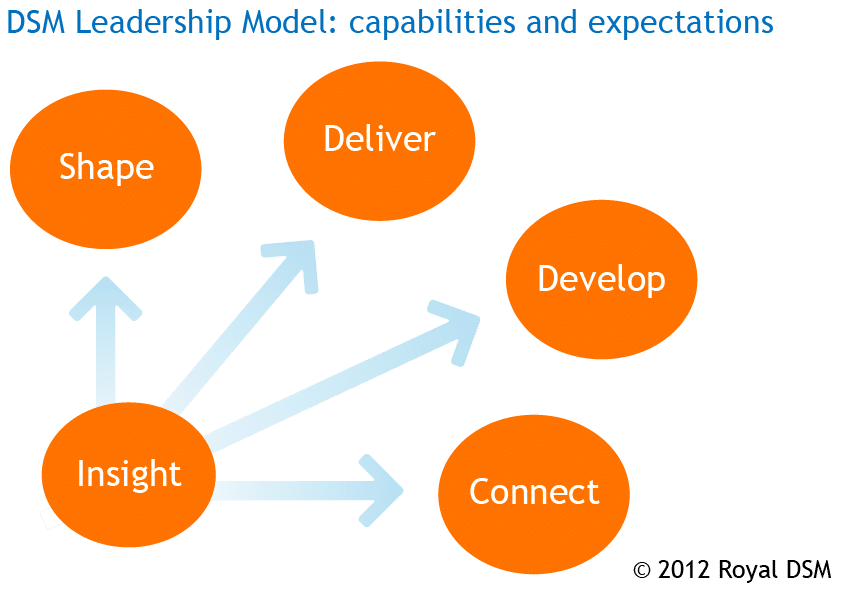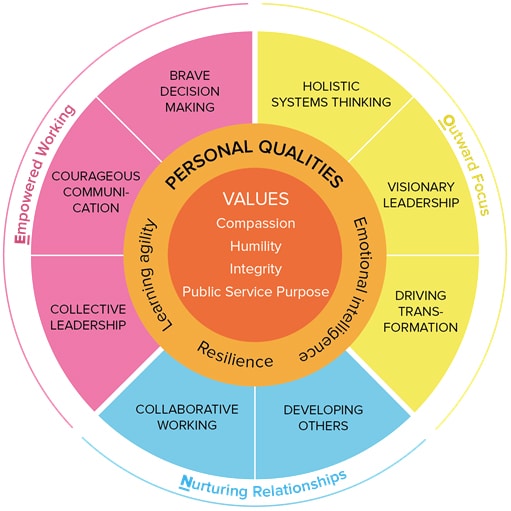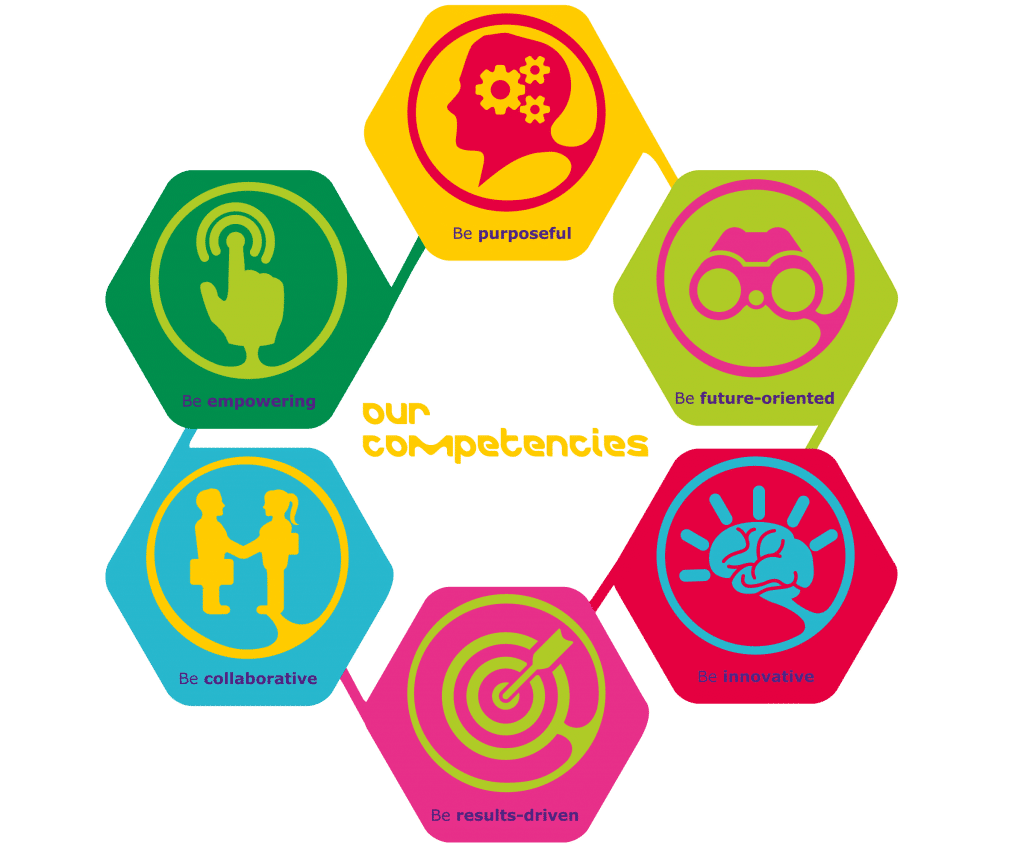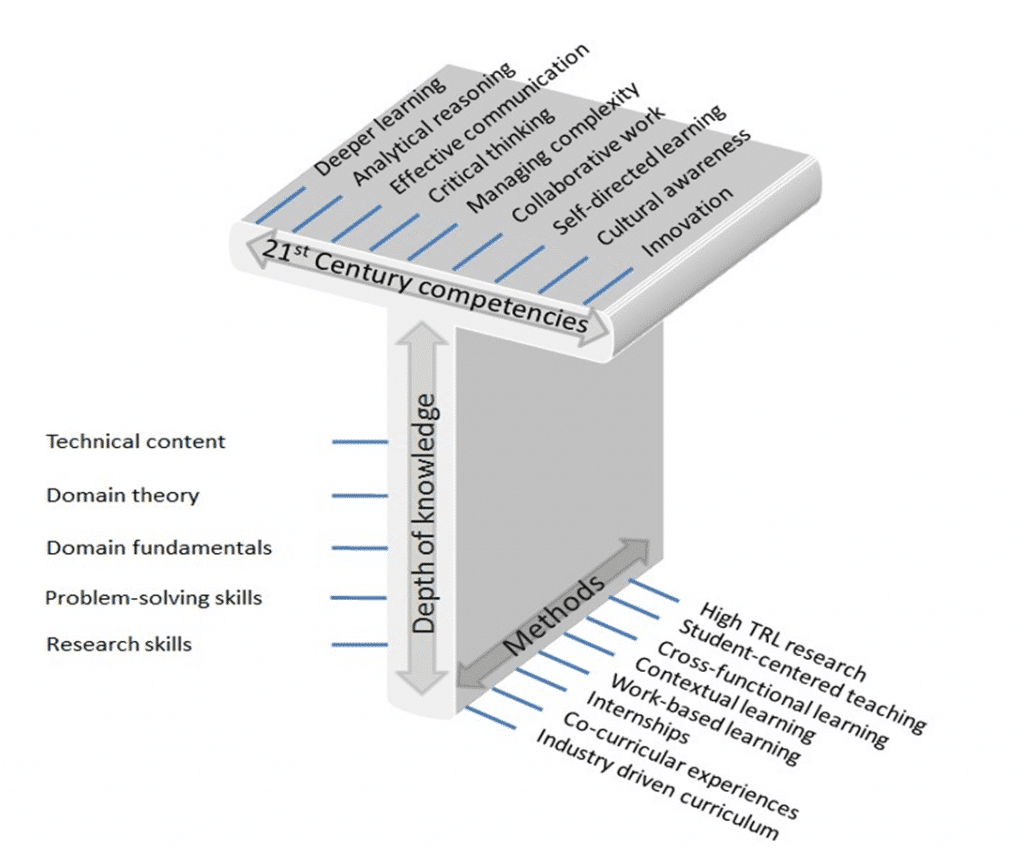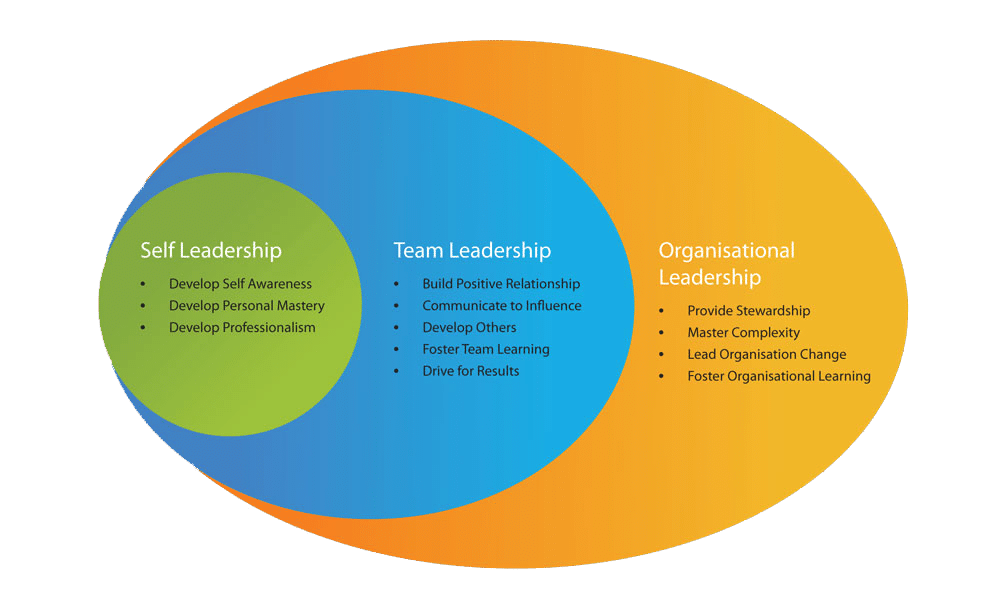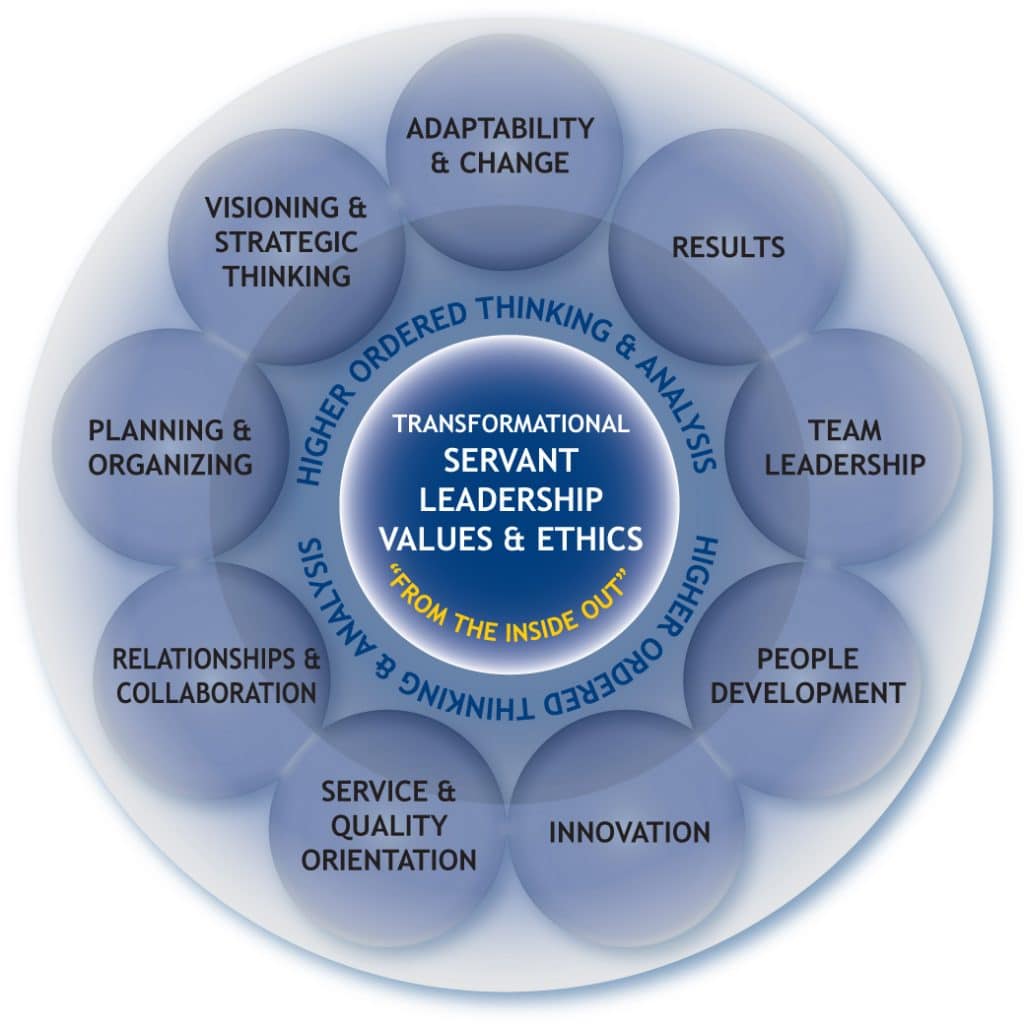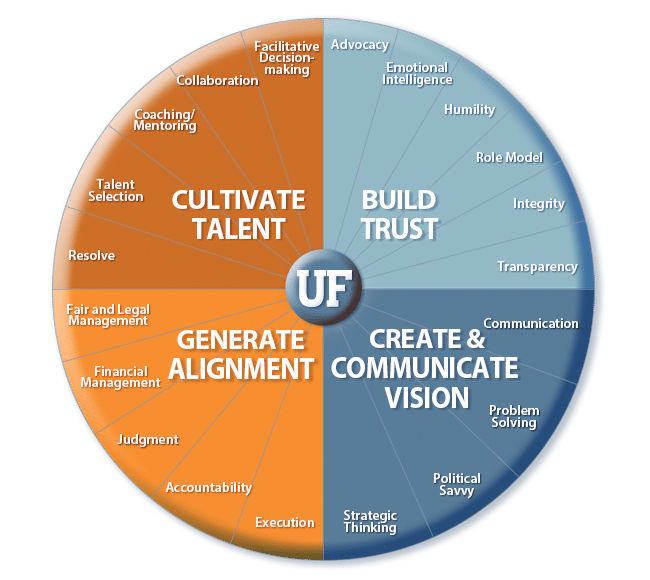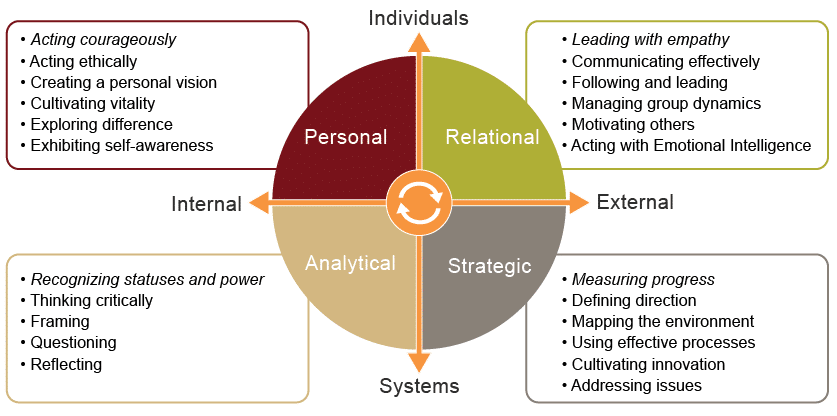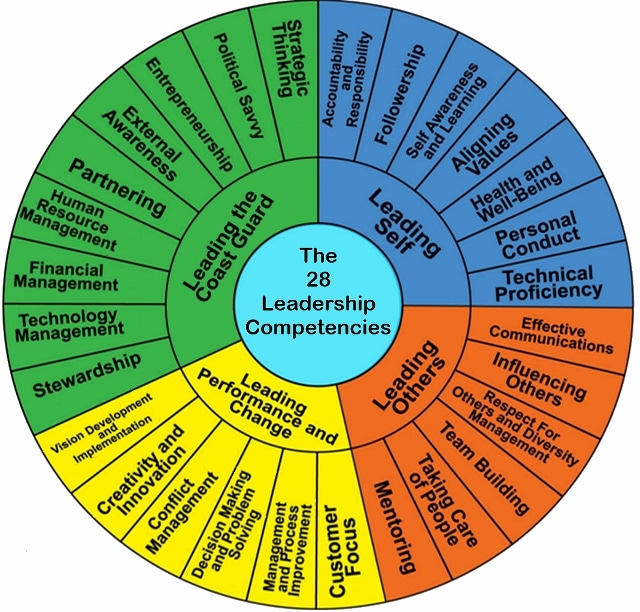- What is Organisation Design?
- Introducing the Organisation Evolution Framework
- Consistency and Intentional Design. Building the Organisation of the Future.
- Building the Intentional Organisation
- Business Models: the theory and practice
- Strategy Frameworks: The Theory and the Practice
- Organisation Models: a Reasoned List between Old and New
- Operating Models: the theory and the practice.
- Leadership Models: The Theory and the Practice
- Purpose: The Theory and the Practice
- Corporate Culture: The Theory and the Practice
- Organisation Ecosystem: The Theory and the Practice
After having analysed the four foundational pillars of the Organisation Evolution Framework, it’s time to investigate its fifth element: Leadership. I have been careful to provide, within the model, a purely opportunistic definition of leadership that “fits” the model, and the reason will be clear towards the end of this long article. Leadership is one of the topics most discussed (and probably most abused) in management literature. A number of points of view are constantly added from multiple disciplines: psychology, behavioural science, sociology, history etc.
Also defining the terms is difficult. For example, we keep being reminded that Leadership has nothing to do with hierarchy (Kruse, 2013), yet just access any consulting website, and the term “Leadership” in an organisational context will refer in most cases to the decision-makers or executives of a firm. We keep reading that Leadership is not Management (Kotter, 2013), yet managers keep being evaluated on their leadership skills. We hear that Leadership is not linked to attributes, yet most Leaders we can think of are charismatic, and definitely with robust personality features. The term Leader is even used today in file and rank job titles, (Customer Service Leader, Customer Success Lead, are just some example). All this shows the existence of many different points of view on this concept. Also just reviewing the NGRAM for the word Leadership, it is apparent how relevant the topic is in recent years.
I came to the conclusion that, probably, the term itself has been so abused, that we need to find a new and more precise vocabulary for the many meanings that we attribute to Leadership.
However, as with my previous articles on Organisation Models, Business Models, Strategy Frameworks and Operating Models, I want to try to give an account of the complexity of this territory. The excel that supports this article lists already more than 150 visual models, which I have shortlisted to 101 in the first version of this post over 120 models. The reason for exclusions of some of the models is due to cross-referencing sources, sometimes plain copying, and often issues accessing the source. All models are still referenced in their original webpage at the time of publication. However, the quest is not finished. As I started the revision of this article, I could find at least five new graphics on a simple google image search. This also means that your contribution will be fundamental. Please feel free to suggest new models (or give feedback to any of these) directly in the comment section of this post.
Article Updates
This article was originally published on August 21, 2020 and is subject to frequent updates. Here is a list of the latest ones:
- August 22, 2020: Minor spell-check edits.
- August 24, 2020: 110 Models in total. Added following models: Action Centered Leadership, AT&T, Great Man Theory, Fiedler’s Contingency Theory, Leipzig Leadership Model, Spiritual Leadership Model, Trait Theory, Visionary Leadership, Vroom-Yatton-Yago Decision-Making Model. Reference List updated.
- August 31, 2020. 120 Models in total. Few typos corrected. Added the following models: 3D Leadership Model, 3P Model, AIESEC Leadership Development Model, Dynamics of Leadership Development, Eco-Leadership, Leader-Member Exchange Theory (LMX), Seven Levels of Leadership Consciousness, Skills approach to Leadership, University of Minnesota Extension Leadership Model, Value-Based Leadership Algorithm
- April 18, 2022. Several typos were corrected, as well as a few bibliographic notes and links. I have also added the following models: 4R Model of Transformational Leadership, 5S Uncommon Leadership Model, ABC’s Of Cognitive Leadership Model, Apple Discretionary Leadership Model, Cognitive-Behavioral System of Leadership, IHI High-Impact Leadership Framework, Purposeful Leadership Model, Result Based Leadership (Ulrich), (SOMC) Cognitive Behavioral Leadership (CBL), Student Leadership Competencies, The 3 Pillars of Authentic Leadership.
Note: credits for the original version of this post go largely to Tom Haak and the HR Trends Institute, who created a list of Nearly 100 Leadership Models (Haak, 2020).
The Models Topology
As you all know, my partly German mind needs structure to understand information. For this reason, I have structured a classification into six groupings. I recognise this division is very personal and subjective, but it helped me navigate through the massive amount of information, and hopefully guide you as well in the search for meaning through all these models
- Theoretical Models. These are models derived from scholarly research, and that tends to propose an archetype of what a Leader is (or should be).
- Competency-Based Models. These are models built on a selection of underlying competencies and skills.
- Values-Based Models. In this case, the models are built on a selection of underlying values and behaviors.
- Effectiveness-based Models. These are frameworks that include multiple attributes (skills, competencies, practices, etc.) that allow delivering more effective leadership, often specific to a situation or context.
- Purpose-based Models. In this case, these models suggest an orientation towards a specific purpose.
- Applicative Models. These are models specific to an organisation, that tend to apply theoretical principles.
In many cases, the classification of a model under one of the clusters or the other is a difficult choice, as many of the models tend to be overlapping. Occasionally I have put a comment to explain my choice. However, I do not pretend this to be a scientifically valid system. Also, please note that within each cluster the criteria are purely alphabetical at the moment. Where the same label is used by two or more models, I have added the author or the institution that built the model in the title.
Again, feel free to challenge any of this through a comment.
A. Theoretical Models of Leadership
These models are based on the theory of researchers, authors and practitioners, and are not necessarily applied in specific organisations. They are somewhat more theoretical, often academic in nature, and supported by research. Where possible, I have indicated the sources in terms of books or critical authors.
3D Leadership Model
Bill Reddin was a British professor and management behaviouralist, who developed some key theories relating to situational leadership styles and the managerial impact on organisational effectiveness. He developed this, which was later named the 3D Leadership Model, as part of his PhD Thesis, which focused on Managerial Effectiveness and Style. Through his research he identified several different leadership styles and measures their effectiveness in a number of typical situations, essentially amplifying the Management Grid by adding a new dimension of analysis. And essentially adding a fundamental contribution to the concept of Situational leadership, by stating that there is no best leadership style that can be applied to all situations.
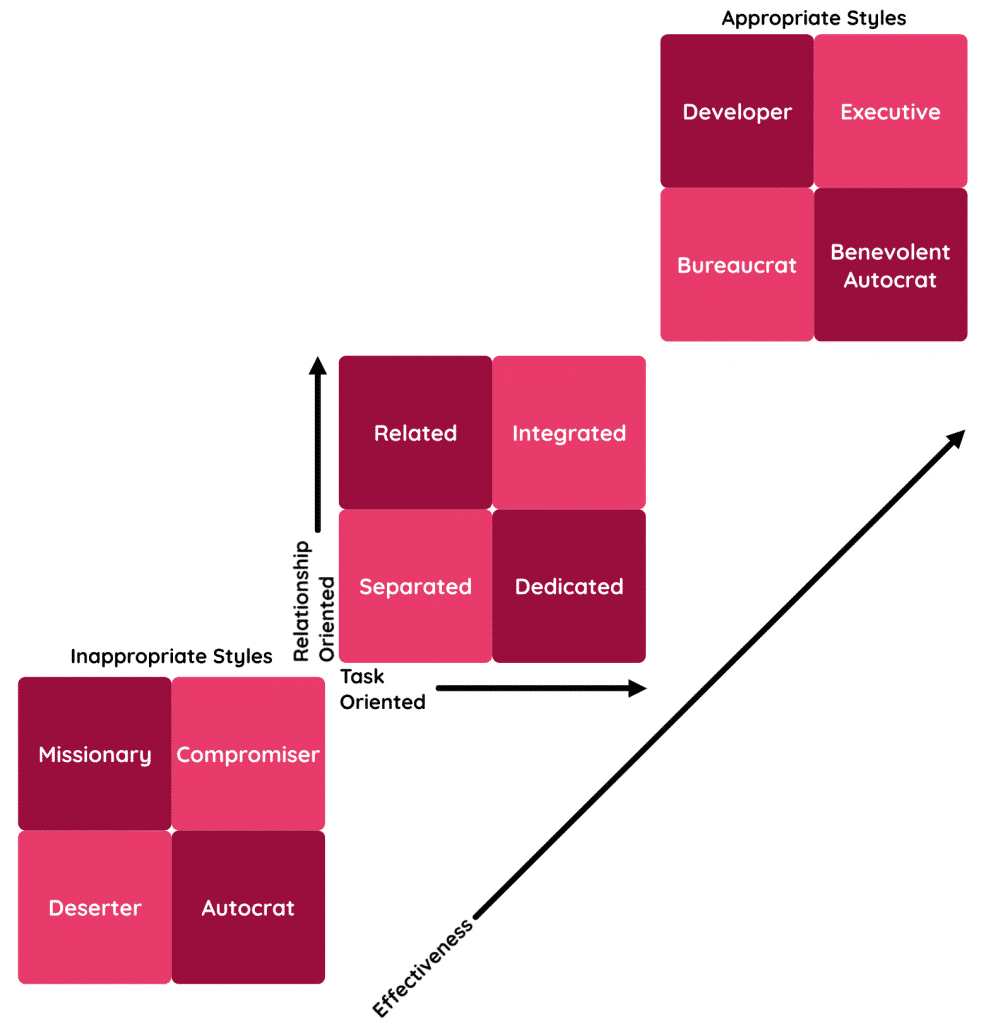
The concept of Effectiveness was defined by the appropriateness of the particular leadership style in any given situation and he argued that this should be the main focus of any manager’s efforts. The image above illustrates how each style can be applied (and interpreted) appropriately or inappropriately to a specific situation.
Reddin also identified two further dimensions of analysis at the individual level, noting the Flexibility and Rigidity of each individual style.
5s Uncommon Leadership model
The Uncommon Leadership model explores five uncommon insights into leadership based on 5 S’s:
- Seeing – leading with vision
- Shaping – leading with action
- Showing – leading with purpose
- Serving – leading with serving
- Sharing – leading with others

Each of the 5S uncommon leadership themes requires a mix of leadership skills. For example:
- To lead with vision will require skills to develop and communicate a vision
- To lead with action needs abilities to create the right conditions for the vision to become a reality
- To lead with purpose first and foremost suggests leaders who demonstrate by their behaviours and actions the direction they want others to follow. They use the business leadership skill of being at the front leading the way
- To lead with serving means a leaders motives are rooted in service, in doing things for the benefit of others. In contrast to leading with purpose such leaders adopt the business leadership skill of leading from behind, they follow their people, supporting and encouraging.
- To lead with others recognises the skills to collaborate and to build leadership capacity more widely in the organisation. Such leaders lead from within.
Action Centered Leadership
Action Centered Leadership (sometimes known as ACL) is a model that was first published in 1973 by John Adair. The model highlights the key actions that leaders should take when managing their teams, by grouping them into three areas.
• Task: Achieving the team’s goal.
• Team: Developing and building your team, so that it’s even more effective.
• Individual: Helping individuals develop their full potential in the workplace.
The model states that leaders must balance the actions they take across all three key areas if they want their group to succeed. The areas are interdependent; if a leader focuses too much on one area and neglects the other two, then the group will experience problems. Plus for each area, a number of skills need to be developed and actions placed for the development of the people within the teams.
This model illustrates the necessity to move beyond simple personality traits, and focus on the activities that a Leader can and should do to form a team and help it reach its objectives.
Authentic Leadership Model by Bill George
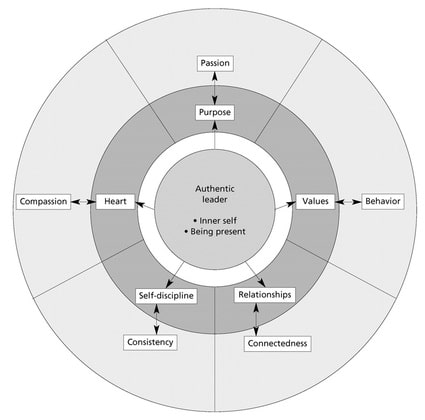
Bill George was one of the first authors to investigate the concept of Authentic Leadership in his bestselling book Authentic Leadership: Rediscovering the Secrets to Creating Lasting Value 2004. In it, he identified a wheel of authenticity, which essentially allows for the strengthening of the authenticity characteristics. At the core, however, there was no need to develop two important traits: inner self and being present.
Authentic Leadership Model by James Kelley
This model is presented in the book The Crucible’s Gift: 5 Lessons From Authentic Leaders Who Thrive In Adversity by James Kelley (Kelley, 2018).

The author has tried to focus on the different ideas behind the concept of Authentic Leadership and has distilled them into a model and a formula. At the core is the idea of a crucible moment, which links to the concept that it is the adversities that power the best leaders. Together with Self-Awareness, it characterises an Authentic Leader. However, there are some further practices that the author identifies as key to developing further a truly effective Authentic Leader.
Centered Leadership by McKinsey
The Centered Leadership Model (Barsh, Mogelof and Webb, 2010) has been developed by McKinsey in 2008, based on a theoretical framework and a 2010 survey that tried to establish the link with satisfaction (McKinsey, 2010) of leaders with their performance. Interesting to notice, that the model was developed as part of the McKinsey Leadership Project (Barsh, Cranston and Craske, 2008), aimed at helping professional women to develop and sustain their leadership profile, an interesting D&I lense.
The model is based on five broad capabilities: “finding meaning in work, converting emotions such as fear or stress into opportunity, leveraging connections and community, acting in the face of risk, and sustaining the energy that is the life force of change”. Each capability is described by a mix of competencies and traits, as they depend very much on the personal history of the leader, and their personal and professional context. The model is contextual, an element of innovation versus many static models. These capabilities when developed consistently, directly impact Presence, Resilience and the sense of Belonging to their organisations.
Charismatic Leadership
The idea of Charisma as a source of authority, and thus directly linked to Leadership, comes directly from the work of Max Weber, who had identified it as one of the possible sources together with Bureaucracy. The big idea here is that Charismatic Leaders have a big emotional impact on their followers independently of their position in an organisation. Over the last few decades, many researchers have addressed the concept of Charismatic Leadership, sometimes as a specific style or model, in other cases focusing on charisma as a critical component within transformational leadership or visionary leadership models.
Robert House, Boas Shamir and Michael B. Arthur (Shamir, House and Arthur, 1993) integrated the theories and proposed various dimensions of charismatic leadership. To summarize, charismatic leaders are
- visionary,
- arouse followers’ motives,
- are excellent role models,
- project a positive self-image and
- empower their followers.
Below is a summary of the impacts and why these make it an effective leadership model.
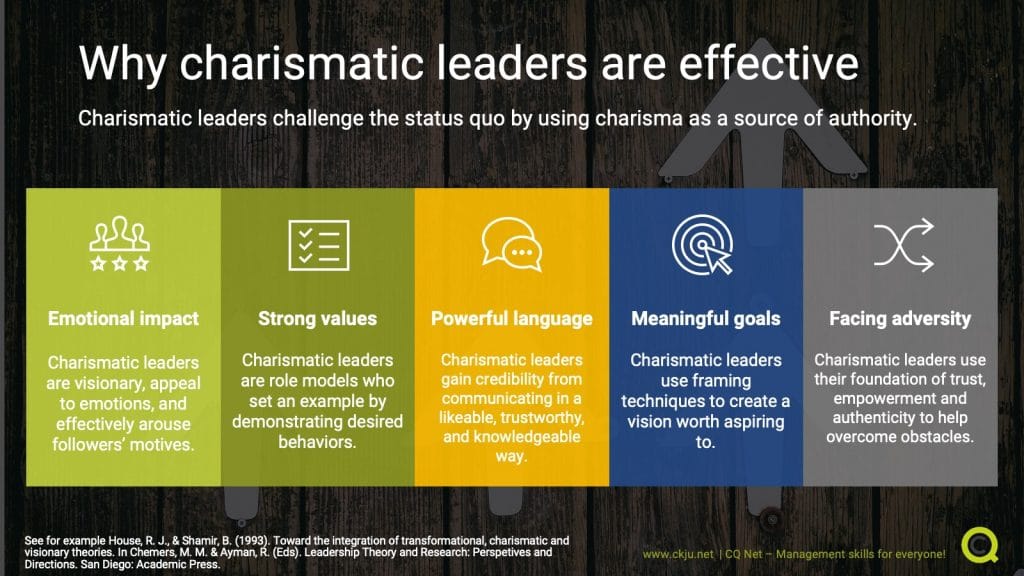
A lot of other models pointed out the fact that Charismatic Leadership is not the only model around, as often Charisma is deemed to depend solely on innate personality traits. However, this is never presented as the sole model present, but as one specific model or style, often effective.
Cognitive-Behavioral System of Leadership
This model has been introduced by academic research and looks at providing a cognitive-behavioural understanding of active and passive leadership. Building on core evaluations theory (particularly the Full Range Leadership Model) the model offers an explanation of the emergence of leadership behaviours in leaders, both active and passive. The model explains leaders’ stable behavioural tendencies by their fundamental beliefs about themselves, others, and the world (core evaluations), while their variable, momentary behaviours are explained by the leaders’ momentary appraisals of themselves, others, and the world (specific evaluations).
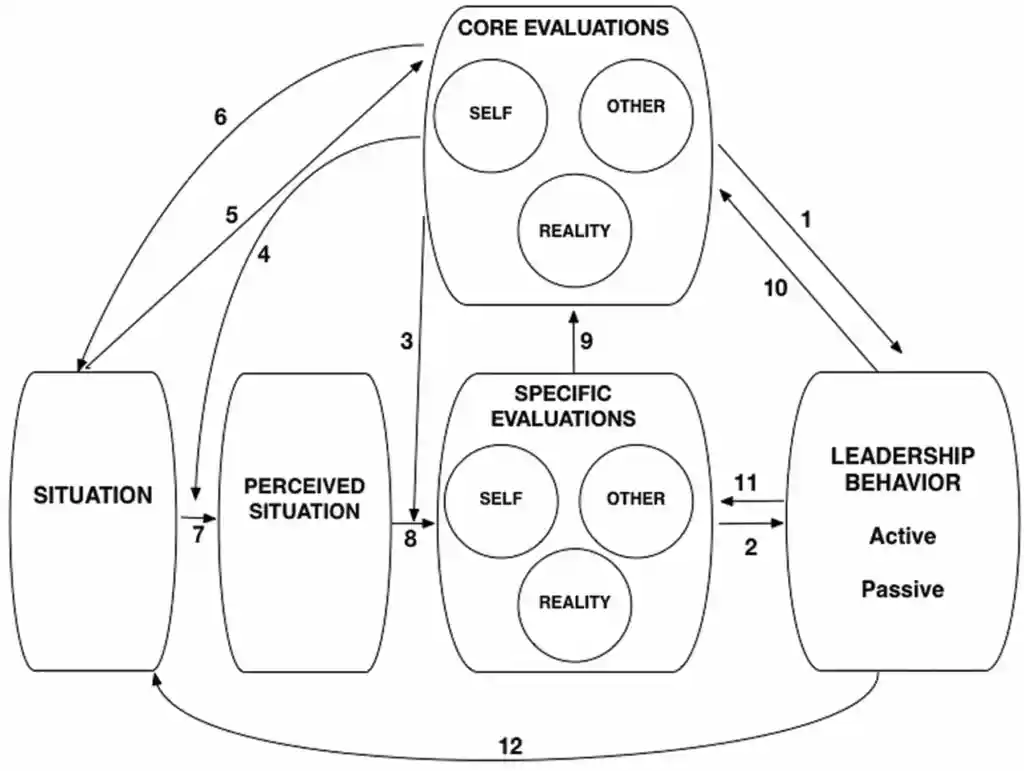
Competing Values Framework
The Competing Values Framework (CVF) was developed by Robert Quinn, Kim Cameron, and other Michigan faculty, and has been widely adopted and is often the basis of several other models.
The CVF acknowledges a fundamental paradox of leadership that is tied to two key tensions found in all organizations: teams, and individuals (Cameron and Quinn, 2005). The first is the need to foster things like collaboration, harmony, and positive relationships (yellow) on the one hand, and the competing need to drive effort, goal achievement, and results (blue) on the other. The second is the urgency with which leaders must establish stability, control, and integration (red), while at the same time aggressively pursuing innovation, change, and learning (green).
Navigating these fundamental tensions and achieving the appropriate balance is the key role of leadership. The four types crystallise several different consequences from a Cultural point of view, but also in terms of Leadership styles and Effectiveness Theory within their organisations.
In 2014 a book by the same authors addressed these more in detail: Competing Values Leadership.
Complexity Leadership
Complexity leadership theory (CLT) focuses on emergent processes within complex systems and suggests that leadership needs to operate at all levels in a process-oriented, contextual, and interactive fashion The model emphasizes the importance of social interactions within organizations yet also illustrates the key role of the leader in enabling change. The model is based on Systems Theory assumption, and is currently being and rejects the idea of Leadership as a linear process. It is based on the strong assumption of an external VUCA environment (Uhl-Bien and Arena, 2018).
The idea is that every organisation needs to practice three types of leadership: operational, enabling and entrepreneurial. Instead of focusing on the traditional way of working, which always focused on the formal side of the operational system, more effort should be put into the Adaptive and Entrepreneurial space. As such, the model clarifies that leadership needs to be diffused in the organisation, as every person can and must influence the organisation as a whole.
Conversational Leadership
The concept of Conversational Leadership was born within the practice of Knowledge Cafes. It is based on the idea of aligning a number of processes that leads internal conversations in organisations and produce collective intelligence.
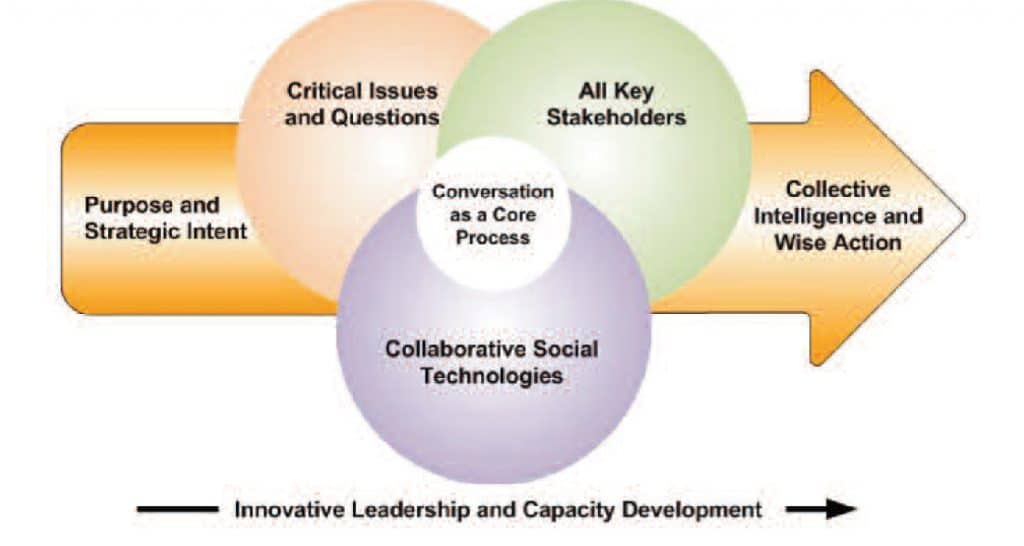
“Conversational leadership takes root when leaders see their organizations as dynamic webs of conversation and consider conversation as a core process for effecting positive systemic change. Taking a strategic approach to this core process can not only grow intellectual and social capital, but also provide a collaborative advantage in our increasingly networked world” (Hurley and Brown, 2016).
The foundation is the development of an “Architecture of Engagement”, that the leader can foster by
- Clarify purpose and strategic intent
- Explore critical issues and questions
- Engage all key stakeholders
- Skillfully use collaborative social technologies
- Guide collective intelligence toward effective action
- Foster innovative capacity development
Conversational leadership uses conversation as a core process to create tipping points for change. It invites us to complement our traditional focus on methods for business process improvement with a focus on methods for talking and thinking together effectively to simultaneously create the social process improvement needed to maximize business and social value.
Eco-Leadership
Simon Western has developed this model based on his doctoral research on how leadership models have evolved. He identified four “discourses” of leadership, that evolved over time. These four discourses form a meta-study of leadership in a social and economic context
- The Leader as a Controller: the focus is on maximising efficiency and control to increase output. It has been the dominant discourse for many decades and descends from the scientific management principles.
- The Leader as a Therapist: here the assumption is that the Leader has to work on human relations, following the slogan “happy workers are more productive”. This model emerged from the Human Relations movement, but developed traction in the 1960s, together with the development of HR departments, and the focus on self-development (especially through assessment and coaching).
- The Leader as a Messiah: this narrative developed in the 1980s following the first large economic crisis of that period. Taking some “great-man” principles, this discourse developed in parallel with those of corporate culture and vision. You needed a transformational leader to succeed. Control is achieved through “culture fit” and social surveillance, rather than through power and coercion.
- The Eco-Leader: is the newest discourse, and focuses on connectivity, inter-dependence, ethics and leadership spirit.
The new Eco-leadership discourse has three key qualities:
- Connectivity (holism): It is founded on connectivity; how we relate and interrelate with the ecologies in which we work and live.
- Eco-ethics: It is concerned with acting ethically in the human realm and with respect and responsibility for the natural environment.
- Leadership spirit: It acknowledges the human spirit, the non-rational aspects of mind, creativity, imagination and human relationships. (Western, 2012)
The approach doesn’t simply evolve to a new discourse, but encompasses the pre-existing ones, offering a way of incorporating them in the right places and contexts, as each discourse had its validity principles.
Fiedler’s Contingency Theory
Fred Fiedler was the first amongst leadership theorists to explore situational variables. According to him, the effectiveness of the leadership style depends on the situation, thus giving birth to what is defined as Contingency Theories of Leadership.
Fiedler came up with three situational variables: leader Member relations, Task Structure and Leader Position Power. The model creates a pretty complex view but recommends a style linked to a specific situation.

Fiedler argues that leaders should take a number of environmental or situational factors into account before deciding on the appropriate leadership style: task-oriented or relationship-oriented. Leaders would be very unlikely to be successful if they cannot ‘match’ their personal leadership style to the demands of the situation. With this model, Fiedler opened the path to many more Contingency or Situational based leadership models, many of which can be found in this article.
Five Levels of Leadership
Jim Collins in his Good to Great book (Collins, 2001), proposes a Leadership Model made up of five layers. This model is not particularly innovative, as it builds up a hierarchical view of Leadership. However, the book does a great job of illustrating what a level 5 leader is –“an individual who blends extreme personal humility with intense professional will.” Thus, the list becomes also aspirational, and although the level descriptions seem to highlight a positioning in the hierarchy, it also shows that there is a development opportunity in the building of greatness for an organisation.
Four Framework Approach
The Four Framework Approach has been developed in 1991 by Bolman and Deal in their book Reframing Organizations (Bolman and Deal, 2017) The model suggest that leaders display leadership behaviours in one of four types of frameworks: Structural, Human Resource, Political, or Symbolic:
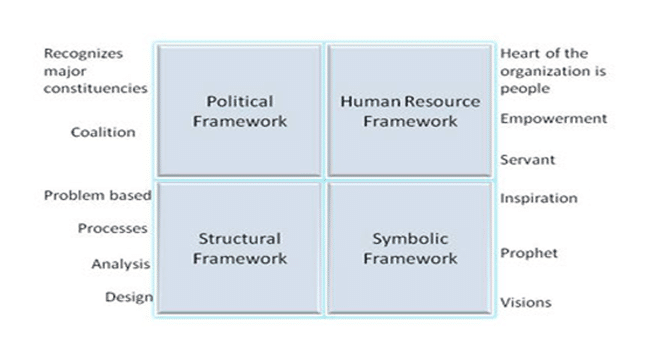
This model suggests that leaders operate in one of these four categories and there are times when one approach is more appropriate and times when it would not be. That is, any style can be effective or ineffective, depending upon the situation.
For example, during a major organisational change, a Structural leadership style may be more effective than a Symbolic leadership style; during a period when strong growth is needed, the Symbolic approach may be more appropriate. Personal preferences also play an important role, but it is important to evaluate these against the reality of the context and be able to “manage” the different frameworks consistently.
Full Range Leadership Model
The Full Range Leadership Model is a general leadership theory that focuses on the behaviours of leaders in different situations and is based on the work by Bruce Avolio (Avolio, 2011) and Bernard Bass (Avolio and Bass, 2002).
The model (which has received several adaptations afterwards) essentially paints a trajectory of different leadership styles through a schema where on one axe the level of engagement is mapped and on the other the level of effectiveness. Three broad types of leadership are identified:
- Laissez-faire Leadership. In this style, leaders don’t really intervene and tend to avoid responsibility.
- Transactional Leadership. In this style, leaders essentially tend to promote compliance by followers through both rewards and punishment. It is named transactional because the focus is the exchange of value between employee performance and the leader’s response to it. Some consider this a form of management rather than of true leadership.
- Transformational Leadership. This style follows a more long-term focus. The basic idea here is to substitute egoistic short term individual goals, with higher-level, value-based, long term goals. This paradigm change usually increases commitment, self-confidence, and employee satisfaction
As such, this model can also be seen as a “maturity model” for Leadership. Many of the models presented in this article tend to refer to one of the two latter categories of this framework, although there is a lot of focus in leadership literature aiming for transformational leadership. However, many of the competency-based models are often purely operational and focused on performance evaluation.
Goleman’s Six Leadership Styles
One of the most important classifications of leadership style, derives from the work of Goleman originally in its milestone article Leadership that Gets Results (Goleman, 2000), then in the widely acclaimed book Primal leadership (Goleman, Boyatzis and Mckee, 2013). Based on thorough research, the model does not only identify styles that are more effective, but also the conditions for the effectiveness of each one.
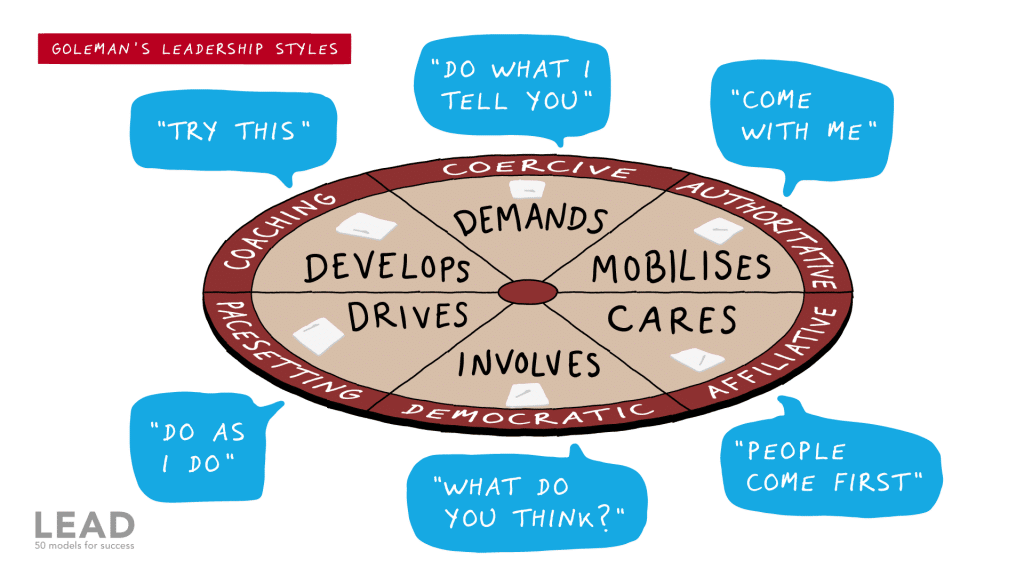
Six types of leaders are identified, even if most of them exist not in their purest form, but rather as mix of the individual styles.
- Visionary — mobilize people toward a vision.
Works best when a clear direction or change is needed.
Most positive climate. - Coaching — develop people for the future.
Works best when helping people and building long-term strength.
Positive climate. - Affiliative — create emotional bonds and harmony.
Works best to heal rifts in teams or motivate people in stressful times.
Positive climate. - Democratic — build consensus through participation.
Works best to create consensus or get input.
Positive climate. - Pacesetting — expect excellence and self-direction.
Works best to get quick results from a highly competent team.
Negative climate. - Commanding — demand immediate compliance.
Works best in crisis or with problematic people.
Negative climate.
The correlation with climate is essential, although also the more negative styles can be adopted in specific situations.
Great Man Theory
The Great man Theory has been established during the 19th century by historian Thomas Carlyle, who crystallised a view by which “prominent leaders throughout the course of history were born to lead and deserved to do so as a result of their natural abilities and talents.”
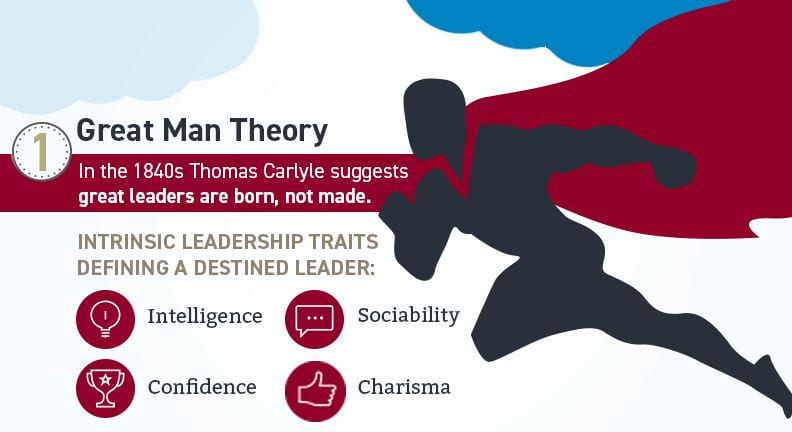
As a historian, Carlyle developed a Heroic view of history, where the major milestones in historical development were linked to great men and their actions. This approach stayed alive for many years, up to the Second World War, also thanks to the contribution of other thinkers from disparate fields of human thought (Freud and Nietzsche just to cite two). And the consequences of this thinking are still evident today. In many ways, many people still believe that “great leaders are born, not made“, a sentence that crystallises this view. This despite all the evidence that the Great Man Theory completely ignores the influence of the context.
Kurt Lewin’s Leadership Style
Probably the oldest model that reflects Leadership, is based on the research done by Kurt Lewin in the 1930s (in parallel with his investigation of Change). He identified three archetypes of leadership.
- Democratic
- Autocratic
- Laissez-faire
Although he had a personal preference for the Democratic/Participative style, Lewin challenged the idea that one style is perfect for every situation, creating the first situational concept of leadership. The ideal leader needs to master all three styles and be able to adapt them to the particular situation.
Leader-Member Exchange Theory (LMX)
The Leader-Member Exchange Theory is a relationship-based approach that focuses on the relationship between leaders and followers. Developed by multiple authors across a period that spans now over 40 years, it is a theory that basically criticizes Leadership models that are solely developed based on the Leader or on the Follower and instead focuses on the relationship between these two actors (Graen and Uhl-Bien, 1995).
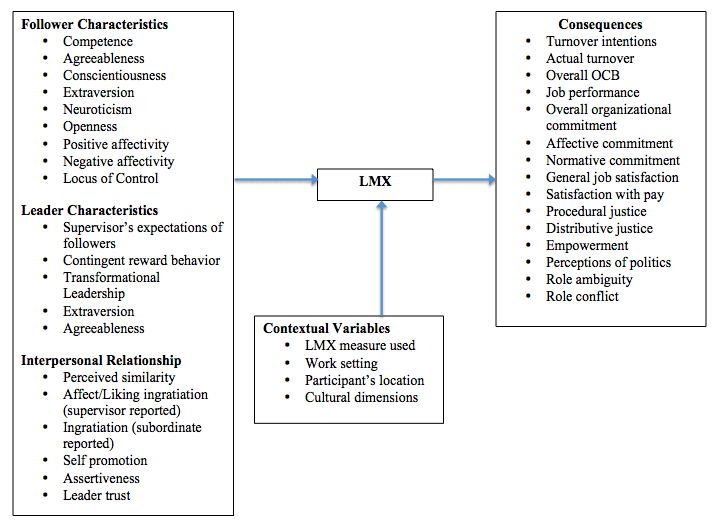
In a 2011 article, Dulebohn and others have tried to condense the 40+ years of research, into a model that looks at the characteristics of the Leaders, the characteristics of the Followers and the Characteristics of the Relationship. Each of these factors influences the other, and originates a level of LMX (which some of the authors have been consistently measuring through appropriate diagnostic tools). A number of contextual variables are taken into account. All together these determine the Consequences of the relationship, which can be measured by observing the different impacts of Leader-Member relationship.
As mentioned, the focus is on the relationship, and the LMX theory projects three stages in the relationship-building across Leader and Member.
- Role-taking. This is the very start of the relationship when both the manager and the employee are just starting to get to know each other. In this stage, the tasks of the employee will typically be simple and with little responsibility.
- Role-making. This is the stage where the relationship develops and is the most critical. Employees will be able to earn the trust of their managers or not, and thus will unconsciously start falling into two categories: “in-group” or “out-group”. This mental categorization is not just based on loyalty, and development is the influence of multiple interactions with the employees.
- Routinization. Finally, a routine is established in which the manager and employee generally know what to expect from each other. Here the attribution to the two groups becomes stable, which is where ineffectiveness in the leadership style might appear, as the people might have earned their placement based on bias rather than true performance, for example.
This is of course only one element of the theory, but is a very important one, as it essentially gives managers a sense of awareness of the relevance of the relationship in how their leadership perception is built.
Leadership for Collective Wisdom framework.
This model has been developed by John Ott and Rose Pinard and is inspired by Ken Wilber’s work on the evolution of consciousness. The model is based on three foundational concepts: Collective wisdom—a transcendent knowing that can lead to profound action—is an innate capacity of any group (Briskin et al., 2009). Leadership is the capacity of any individual or group to cultivate the conditions for collective wisdom to arise in support of effective action. In any collective effort, then, there are four dimensions of change to be mastered.
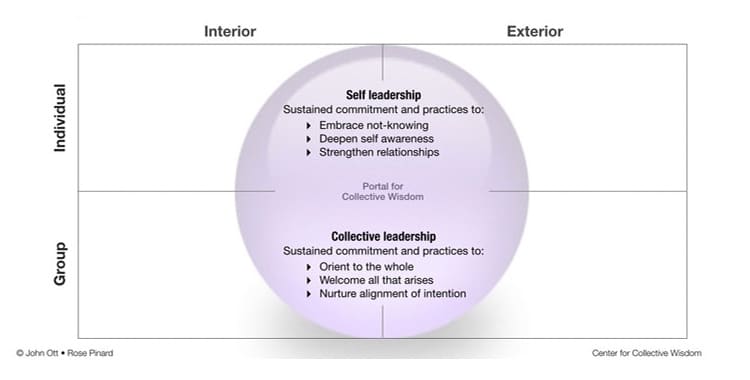
The model illustrates that in order to achieve results, two orientations are needed in terms of self-leadership and collective leadership.
Leadership or Managerial Grid
Several studies, already from the 1950s, started to identify two specific types of managerial behaviours: concern for people or concern for tasks. Although called differently in many ways, these two behaviours have been underlying leadership research for some time. Initially, the idea was that these two orientations could be positioned at the end of one continuum, but the reality was a bit more complex.
In 1977 Blake and Mouton combined the two elements into a survey and later created a matrix that put the two dimensions, “concern for people” and “Concern for Production”, in correlation. (Blake and Mouton, 1977)
The survey allowed the authors to position the individual leaders on the grid through scoring and understanding their behaviours. The model ended up with four styles, plus a “middle of the road” management style. The theory goes on by choosing a “sweet spot” style, which would be to be positioned in the Team Leadership quadrant (thus scoring a minimum of 6 in both dimensions). However, the authors also clarify that in certain situations it is possible to adopt any of the other styles, as it could be more appropriate for the specific context.
The Performance Triangle
Developed by Lukas Michel in his 2013 book by the same title, it is a consulting framework to analyse people-based leadership. In recent times it has been more and more focused on business agility.
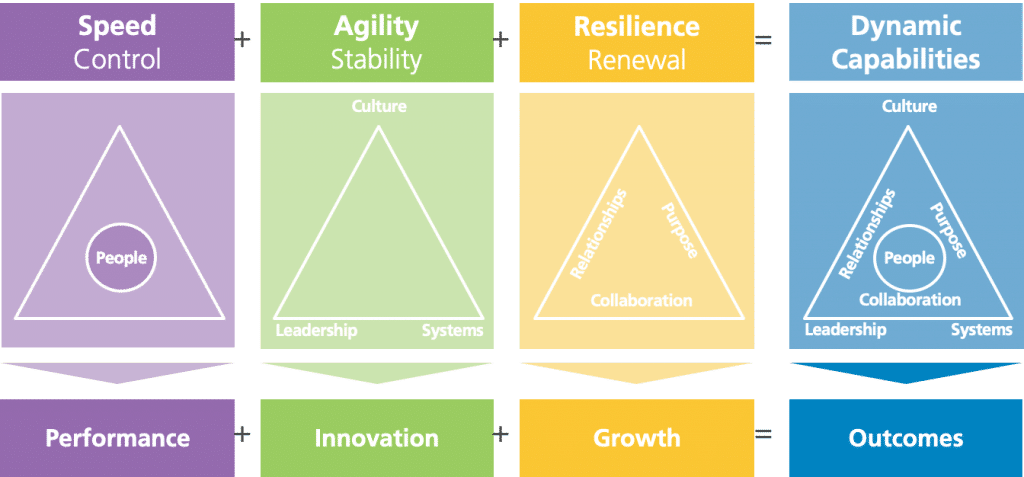
The model, which is dynamic, is based on a triangle constituted by the elements of Culture, Leadership and Systems and forms the dynamic context for people (who are at the core). There are 37 elements that have been identified and that serve as a diagnostic tool for this model, supporting the understanding of both individual and organisational performance. Rather than suggesting one specific Leadership Style, the model assumes that the concept itself of Leadership is situational and dynamic.
Result Based Leadership
This model originates from the 1999 book by Dave Ulrich under the same name. In it, the authors argue that it is not enough to assess leaders by personal traits such as character, style and values. Focusing only on Leadership Attributes is misleading, and effective leaders should be measured against the leadership results they achieve.
For this, the authors have developed what they call a “Leadership Formula”
Effective Leadership = Attributes x Results
They offer four criteria to assess if a Leader is truly focused on Results:
- Balanced — results balance the major dimensions of the organization (employees, organization, customers, investors) ignoring no one;</li>
- Strategic — results link strongly to the strategy of the firm’s and its competitive position;
- Lasting — results meet both short- and not sacrifice long-term goals; and
- Selfless — results support the whole enterprise and transcend the manager’s personal gain.
Servant Leadership
The concept of Servant Leadership was originally developed by was first coined by Robert K. Greenleaf in The Servant as Leader, an essay that he first published in 1970. In that essay, Greenleaf said: “The servant-leader is servant first… It begins with the natural feeling that one wants to serve, to serve first. Then conscious choice brings one to aspire to lead. That person is sharply different from one who is leader first…The difference manifests itself in the care taken by the servant first to make sure that other people’s highest priority needs are being served” (Greenleaf, 1970)
The concept reverts the assumption of a leader that develops based on authority and power, and rather sees it as a source of support for their teams and organisation. Today the word “servant” is sometime disputed, but the principle outlined are used in many models listed here.
The model was later elaborated with the help of Larry Spears, who has identified a number of characteristics of the Servant Leader in the book Servant Leadership. Today, the Center for Servant Leadership maintains the legacy of Greenleaf’s work and advocates for the further development of this concept across the organisation. Many other authors have added to the concept, therefore the image that I put here is somehow a very good synthesis of the themes applied to the concept.
Skills approach to Leadership
The Skills Approach is a leader-centred perspective that focuses on the competencies necessary to become a leader. Rather than looking at characteristics that are innate and fixed, what is put in focus is one’s skills and abilities can be learned and developed. The first author to illustrate this theory has been R. L. Katz. In a famous 1955 article that appeared in Harvard Business Review (reprinted in 1974), he listed the skills needed to effectively “administer” an organization.
Effective leadership depends on the three basic administrative skills: technical(things), human(people), and conceptual(ideas). While all three skills are crucial components for leaders, the relative importance of each skill varies based on management levels. As shown above, technical and human skills are more important at lower management levels, the three different skills are equally important for middle managers, and conceptual and human skills are most important at upper management levels.

A significant contribution to the Skills Theory has developed more recently, particularly by the contribution of Mumford and others (Mumford et al., 2000), as they revised a list of skills that can contribute to the development of Leadership. The authors identified a vast literature and concentrated on two broad competencies: Problem-Solving and Social Judgement.
Many models present in the Competency-Based Leadership Cluster derive from these original ideas.
Situational Leadership
Probably one of the more widely taught models of Leadership is Situational Leadership. Originally developed by Paul Hersey and Ken Blanchard at the end of the sixties s as they worked on their book Management of Organizational Behaviour (Hersey, Blanchard and Johnson, 2012) as a “life cycle theory of leadership” (Hersey and Blanchard, 1969). In the late 1970s/early 1980s, Hersey and Blanchard both developed their own slightly divergent versions of the Situational Leadership Theory: the Situational Leadership Model (Hersey) and the Situational Leadership II Model (Blanchard).
The theory describes four different leadership styles and four levels of individual or team maturity or readiness. It then combines these to suggest which style of leadership best suits which level of maturity.
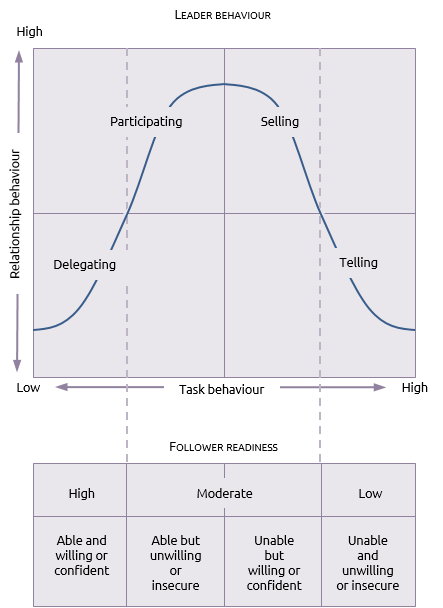
The leaders’ styles or behaviours, should match the “follower readiness” in terms of their skills and developmental readiness. Four levels are traced back to these models. Therefore, there is not one ideal style, but the style needs to be adapted to the situation.
Both authors have continued to evolve the model, and are still expanding it. In the below figure, for example, you can track the current namings used by the SLII model. However the broad philosophy stays valid, and as it is easily understandable, it is widely used in training and learning contexts.
Tannenbaum and Schmidt Leadership Continuum
Robert Tannenbaum and Warren Schmidt first published their views on leadership styles in 1958 and updated their model in 1973 in two articles in Harvard Business Review.
The model focuses on the delegation of authority from a manager to the team. The model is shown below and while the language of ‘subordinates’ and ‘superiors’ reflects its age, the principles still hold true over time.
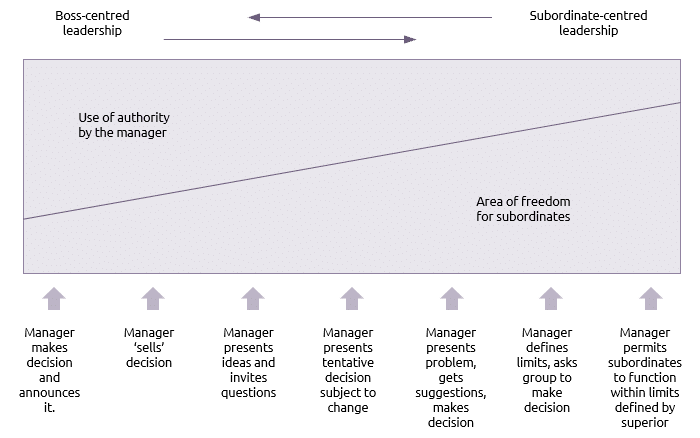
It shows a continuum starting from a situation where the manager holds on to all authority, dictates what tasks need to be done and when. This approach progresses through various phases of increased consultation and delegation to one where the manager delegates most of the authority invested in them to the team.
Is this management or leadership? This can probably be debated, as the concept of delegation is an interesting aspect to consider. But it offers a still contemporary outlook on how people act.
Trait Theory
Trait Theory developed as a consequence of the Great Man Theory, whereby several authors tried to identify the innate traits of successful leaders. The psychologist Ralph Stogdill challenged the idea of some innate traits, and in 1948 wrote a paper analysing over 100 articles on the topic, essentially casting doubt that innate traits can be identified. Out of his analysis, 27 different areas were identified:
- Age
- Dominance
- Height
- Initiative, persistence, ambition, desire to excel
- Weight
- Physique, energy, health
- Responsibility
- Appearance
- Integrity and conviction
- Fluency of speech
- Self-confidence
- Intelligence
- Happiness, sense of humour
- Academic results
- Emotional stability and control
- Knowledge
- Social and economic status
- Judgement and decision (US-English, judgment)
- Social activity and mobility
- Insight (self, others, wider environment)
- Energy, daring and adventurousness
- Originality
- Social skills (sociability, tact)
- Adaptability
- Popularity, prestige
- Introversion-Extraversion
- Cooperation
This showed that there wasn’t much agreement on the key traits. Indeed, it was clear that if all the findings were combined, the list became too long to be useful as a guide for selecting future leaders. He, therefore, suggested that leadership is the result of the interaction between the individual and the social situation and not merely the result of a predefined set of traits. Thus Personal traits alone are not indicators of effective leadership and need to be complemented by specific abilities and motivators.
This opened the road to the development of the broader set of contingency theories. However, a lot of models still refer today to “personality traits” as the basis of the leadership, and tend to “mix” their impact on success.
Transpersonal Leadership
The concept of Transpersonal leadership derives from the work of LeaderShape global and particularly of John Knight. The core idea is that today, “successful leaders recognise that leadership has moved on from being authoritative, hierarchical and pace-setting to becoming a distributed leadership underpinned by an ethical, caring, sustainable and performance-enhancing culture. Only Transpersonal Leaders who are themselves emotionally intelligent, ethical, caring, authentic and lead beyond their ego can enable and maintain this kind of culture.” The concept is particularly analysed in the book Leading beyond the ego. How to Become a Transpersonal Leader (Knights, Grant and Young, 2018), which goes in-depth in illustrating the model.
The model is about balancing three different types of intelligence (and thus individual capabilities). Rational, Spiritual and Emotional. The sweet spot of Transpersonal Leadership means that the Leader is at the same capable of enhancing performance, ethical, but also caring and thinking in sustainable terms.
Visionary Leadership
Defined as “Inspirational” or “Visionary Leadership”, this model focuses on the individual qualities of the leader. There are different points of view on how Visionary Leadership can be defined: “visionary leadership is unidimensional or bi-dimensional, focusing on individual qualities and/or institutional capabilities” (Taylor and Machado-Taylor, 2010). The focus idea of a Visionary leadership is that the Leader provides a “vision” for the future of the organisation, and through this attracts the followers into its realisation.
This model suggests that the interactions between personal, institutional and external variables must be viewed collectively and in relation to one another in order to grasp the true dimensions of visionary leadership.
One author that has stressed the importance of Visionary Leadership is Burt Nanus. He has identified four roles that a Leader can take when experimenting with an organisation’s Vision:
Each role gives a different “flavour” on how a Leader can effectively involve followers and be effective in the implementation of the organisation’s vision.
Vroom-Yetton-Yago Decision-Making Model
In 1973 Victor Vroom and Philip Yetton published a book titled “Leadership and Decision Making“, where they suggested a model identifying the best decision-making approach and leadership style to take based on the situation experienced. The model had the advantage of linking, for the first time, Leadership and Decision Making in an organised way. Unfortunately, the model itself was flawed by a structure that was too rigid.
Vroom and Arthur Jago addressed these weaknesses and amended the original model in their 1988 book, “The New Leadership” (Vroom and Jago, 1988). The newer model is more complex and includes several additional questions, which allow users to take other constraints, such as geographic location, into account when making their decision. It also uses a mathematical formula to help people to pinpoint the optimum decision-making process for their situation.
The model still suggests that leadership style varies on the basis of the decision-making ability of the leaders in different situations. Leadership style was merely based on the degree of employee’s contribution and activeness in the decision-making process, and five styled were identified.
- Autocratic (AI): The leader solely decides with the available information.
- Autocratic (AII): This is stringic autocratic leadership style where the leader takes the opinion of group members to gather more information but may or may not share the final decision with the group members.
- Consultative (CI): The leaders consult with the group members to explore opinions but solely takes the decision.
- Consultative (CII): The leaders consult with the group members to explore opinions and also invites suggestions but solely takes the decision.
- Collaborative (GII): The leader allows the group to take their own decisions collectively and plays a supportive role in the process.
B. Competency-Based Leadership Models
These models are identified as a list of competencies (intended in the broader sense of the term) that should support an effective leadership style. Often driven by consulting companies in their work, and supported by some form of assessment, this cluster of models is still generic enough to be applied to multiple contexts. The origins of competency-based models can probably be drawn from the work of Boyatzis (1982), which I will present first.
Boyatzis Management Competence Model
Introduced in his 1982 book The Competent Manager: A Model for Effective Performance, the model identified a total of 19 competencies directly linked, according to his research, to Leadership performance. He grouped them into four clusters and also draw relationships across them.
The model itself is complex, but there are many elements that are still relevant today. What is particularly interesting is the fact that for the author there was no opposition between “manager” and “leader”, as a successful manager needed to master Leadership Cluster skills.
4R Model of Transformational Leadership
A complex holistic model developed by prof. McCloskey (McCloskey, 2014) and then adapted by consulting firm Work Effects. The model depicts “the interplay of critical variables in the process of transformational leadership”. It also focuses on showing some of the key characteristics of Transactional and Transformational Leadership.
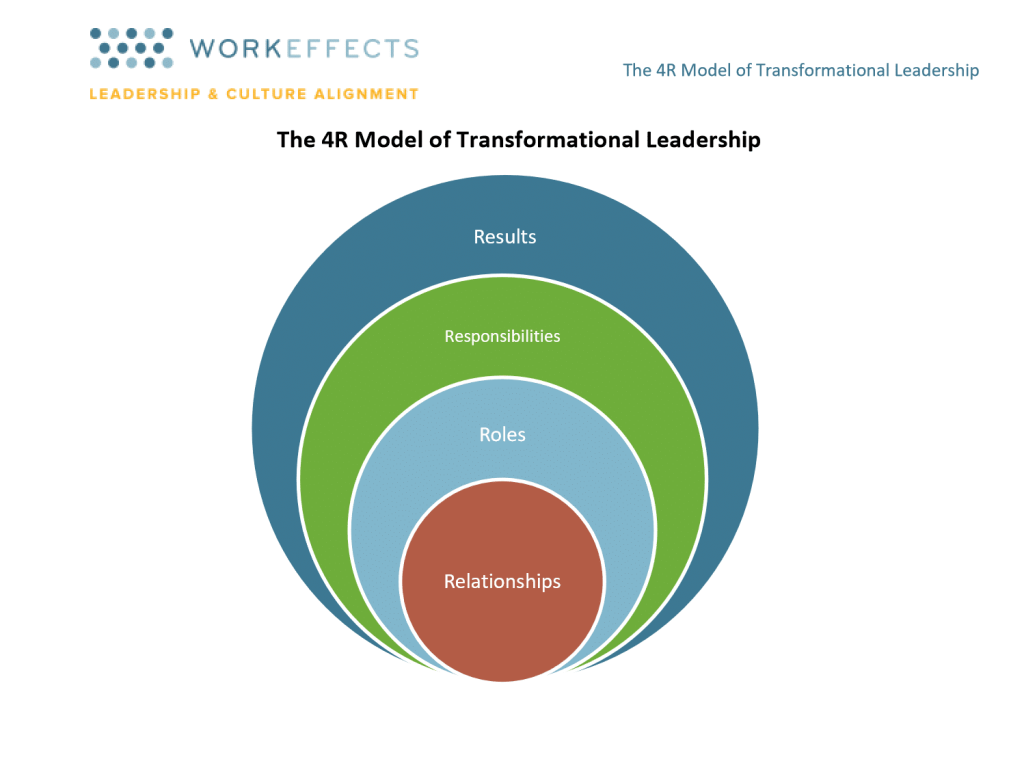
While both styles of leadership are useful in certain environments, Transformational Leadership is necessary when addressing dilemmas. Transformational leader gains the trust of their followers and clients based on a shared interest in the future of the organization. They create and communicate a unifying vision and mission for a better future, and empower and engage followers in the attainment of that vision.
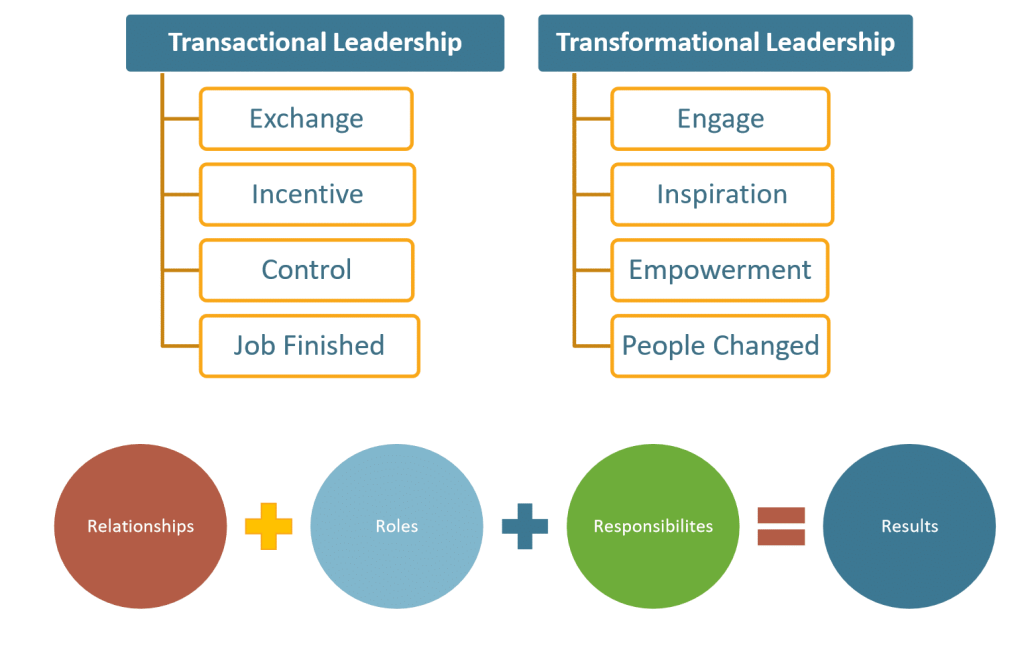
Such leaders serve as a catalyst, helping followers recognize their innate assets and apply them to enhance the success of the organization. Transformational leaders embody the values and vision they promote and sustain healthy organizations as they inspire and motivate others to achieve the desired results.
Bandelli Leadership Competency Model.
Developed by US-based consulting Bandelli Associates, the model “outlines the ten universal and indisputable competencies of leadership effectiveness”.
Boyden Leadership Model
Developed by Executive Search and Leadership Consulting Firm Boyden, the model is based on nine core leadership competencies grouped into three areas of intelligence:
- Cognitive – leading the organisation
- Social – leading people
- Emotional – leading yourself
Self-Leadership measurement is seen as a differentiator for this model, which can be used as an assessment tool.
Canada Government Leadership Competencies
The Government of Canada has developed, in 2015, a Leadership Model based on six key competencies, which are expected from Canada’s Public Service leaders. These are used for the selection, development, performance and talent management of Canada’s executives.
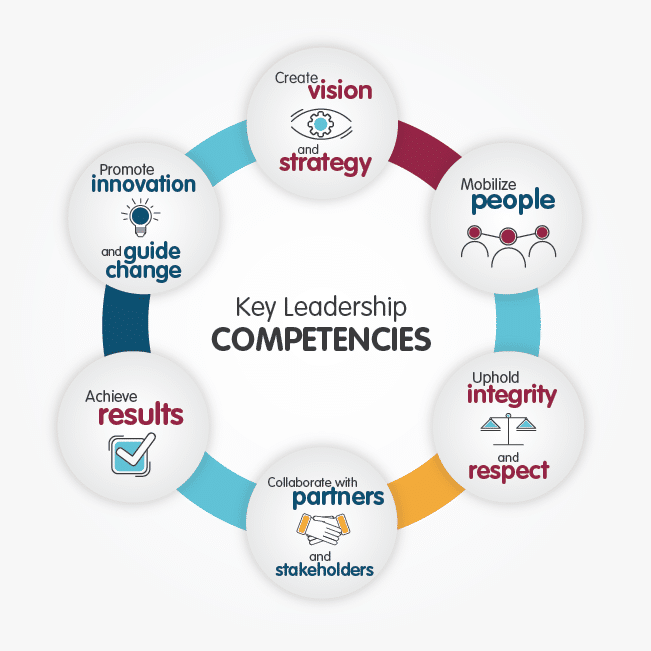
Each competency is described in detail with examples of effective and ineffective behaviours, with examples for specific leadership roles Deputy Minister, Assistant Deputy Minister, Director General and Director.
CIGIE Training Institute Six-Dimension Leadership Model
This model has been developed by the US Council of Inspectors Generals and is applied to its training programs. It focuses on six core dimensions, each built on a number of underlying capabilities.
CFO Leadership Council Competency Framework
This model has been introduced by the CFO Leadership Council in 2018 (Gimpert, 2018) and has been developed with the intention of providing a “readily available, multi-dimensional framework that can be easily applied to guide their own and their leadership team’s growth”. The model is based on a set of seven guiding principles.
- Leaders have a defined sense of purpose and are mission-driven;
- Leadership is on-going journey, not a destination;
- Leadership begins with objective recognition of one’s strengths and development needs and reconciling them to the environment one is immersed within;
- Sustained practice, seeking of objective feedback, and on-going refinement is required;
- Leadership extends beyond leading others; it is also about leading oneself; how one works across the organization and how one delivers performance;
- The benefits of effective leadership is best realized when one’s abilities are extended through the teams one leads;
- Understand the organization one is immersed in and adopt a style that balances who you are with what fits and is an observable model of the organization’s culture (or one that is desired).
It is then organised into four distinguished interdependent dimensions.
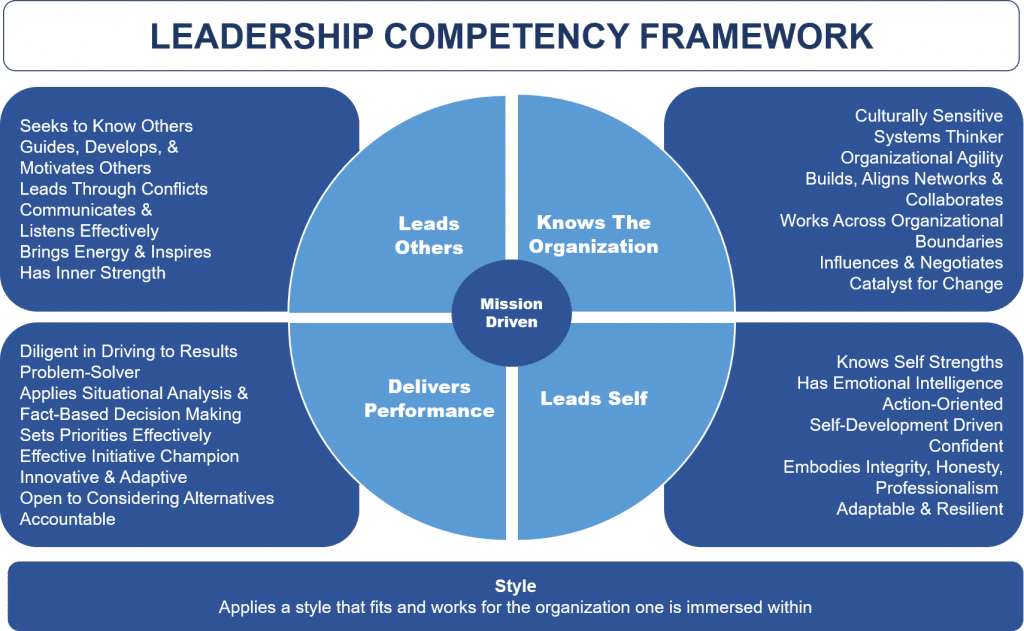
Each dimension is organised in a number of supporting attributes, which are essentially a mix of competencies and personality traits, that should be developed coherently to ensure the mission-driven development of a CFO.
Digital leadership “DQ”
Developed by the digital learning company Runway Digital, this model is essentially a list of competencies and skills that underline the development of digital leadership. The authors propose a model that is based on three foundational elements (mindset + knowledge + agility), but the framework becomes a very technical tool based on several skills, echoing its focus as an assessment methodology.

Harris Whitesell Leadership Model
Harris Whitesell is a US Based consulting company. Their model is based on the identification of ten Leadership Competencies, and five Leadership Assessment areas. The model is supported by a Quiz that allows an initial evaluation of Leadership Effectiveness.
High Impact Leadership Model
Developed by GILD, this model was presented at their 2014 conference and looks at a number of competencies and skills to succeed.
Humanistic Leadership Model
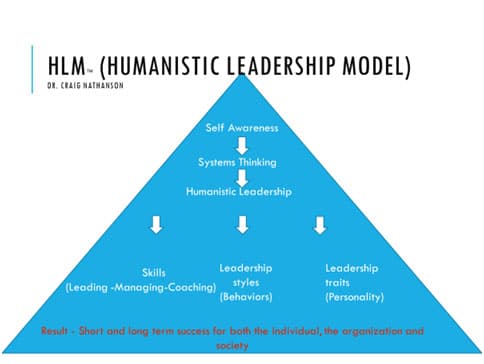
The Humanistic Leadership Model has been designed by Craig Nathanson and illustrates a number o skills, personality traits and behaviours that, according to the author, drive positive leadership results.
Two foundational elements allow the development of a Humanistic Leadership: System Thinking and Self-Awareness, according to the author. (Nathanson, 2017)
Intelligent Leadership
The concept of Intelligent Leadership has been developed by John Mattone in his book Intelligent Leadership (Mattone, 2013). As with other models, it tries to identify the components of leadership success through an inventory of competencies.
The inner core consists of the intrapersonal (i.e., self-concept, character, values, references, beliefs, thoughts, emotions) and interpersonal elements (i.e., behavioural tendencies) that strongly impact how effectively you acquire and cultivate the nine outer-core leadership competencies. Predictive relationships exist between your inner and outer core. His model also envisions a maturity cycle, with 9 different types of leadership styles.
Leadership Strataplex Model
The Leadership strataplex model is a multi-level model that includes skill requirements that are layered (strata) and segmented (plex), leading to the name of strataplex (Mumford, Campion, & Morgeson, 2007).
The model consists of the following leadership skill requirements:
- Cognitive skills include the ability to communicate well both verbally and in writing, and the ability to learn and adapt.
- Interpersonal skills involve effective social interactions and the ability to influence others.
- Business skills involved operations analysis and the management of material resources (Mumford et al., 2007).
- Leadership positions at higher levels of the organization required strategic skills that are most important for organizational effectiveness. According to the model, strategic skills are required at a higher level because leaders need to understand the complexity and deal with ambiguity to foster change and innovation.
This model does not define specific competencies but rather proposes itself as a model to define an organisation-specific competency model for Leadership Development.
Leadership USA 3T Leadership Competency Model
Leadership USA is a Colorado-based organisation that provides leadership training for its associates. They have developed a competency-based model denominated 3T, as they put at the Core Team, “Think” and “Tactics. Competencies are organised on three levels corresponding to the three levels of leadership defined by the model.
Mikael Jensen Leadership Competency Model
Mikael Jensen (Jensen, 2019) has proposed a self-developed Leadership Model based on competencies. The article is very extended in his evaluation of the competency levels.
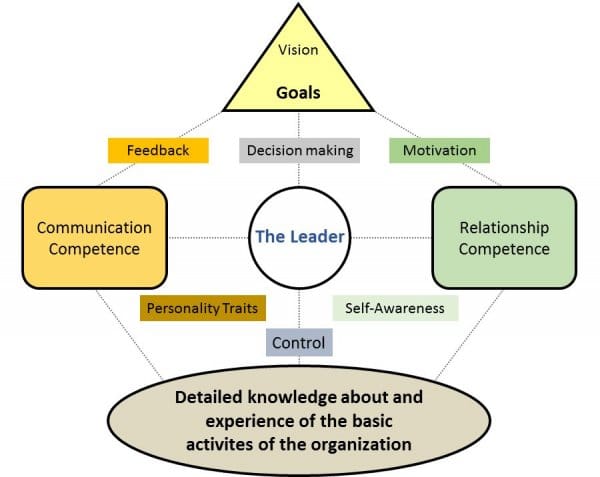
The Net Model of Social Leadership
The concept of Social Leadership has been largely examined by Julian Stodd, who has created a competency-based model defined as the “Net Model of Social Leadership“. Details can be found in his The Social Leadership Handbook. NET is the acronym for the core components of the model: Narrative, Engagement and Technology.
New Zealand Educational Leadership Model
This model was developed by the New Zealand ministry of education and is meant to “set out the qualities, knowledge, and skills principals need to lead 21st century schools”.

Radiant Leadership
Developed by consulting firm Bartell & Bartell, it is a holistic model inspired by the Competing Values Framework and that lists a number of competencies and skills to be developed.
Resilient Leadership by Deloitte
In the wake of the Covid-19 Pandemic, the concept of Resilience has emerged as a key attribute for organisations and Leadership. Deloitte has published a point of view in march 2020 that looks at the characteristics of Resilience Leadership in a lot of detail. They identified a three action sequence (Respond, Recover and Thrive), with a lot of detailed actions per each business area affecting continuity.
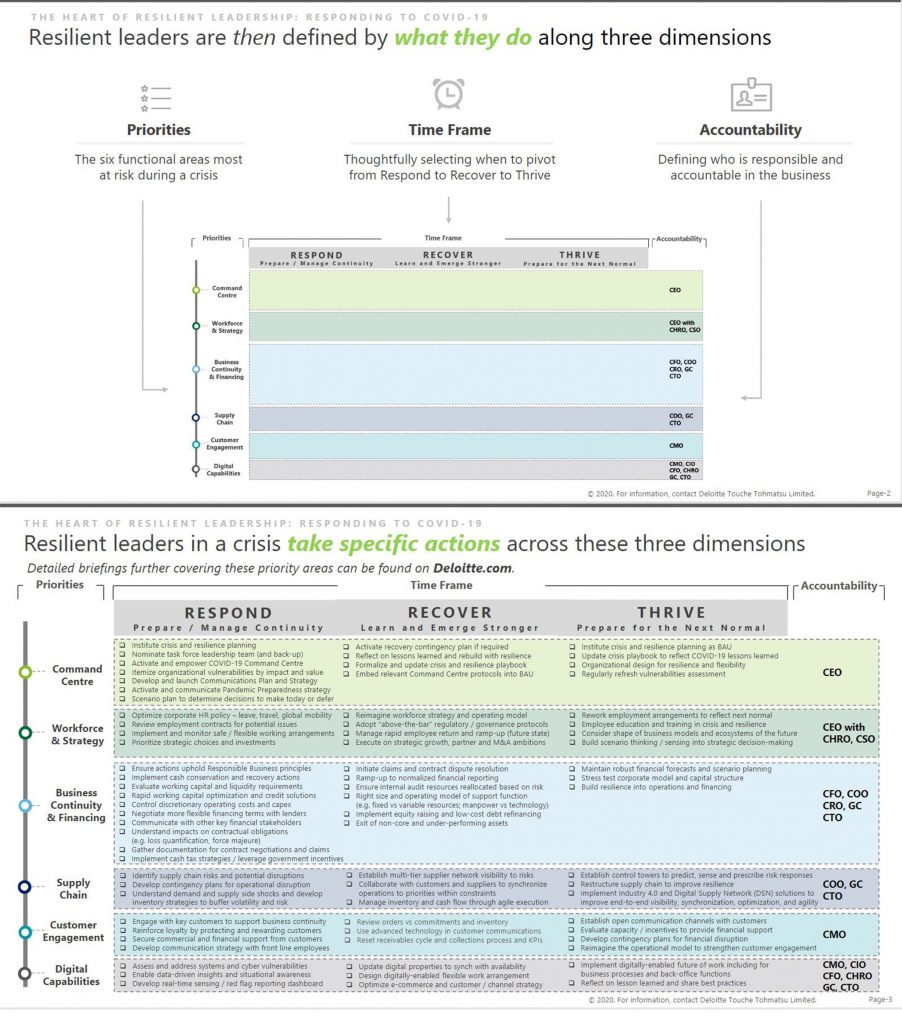
Resilience Spiral
Developed by Sven Hansen of the Resilience Insititute, the concept of the Resilience Spiral is a diagnostic and development framework for resilience at both individual and organisational levels.
With the COVID-19 challenge, the institute has been challenged to link the Spiral more thoroughly to Leadership, creating a model that looks at Deep Inputs and Deep Impacts.
Result Based Leadership Framework
Developed by Sattar Bawany from the Singapore based Center for Executive Education, it is a progressive model based on competency development, covering different performance areas in which the leader needs to act.
Self-Determination Theory of Leadership
A recent model of leadership competencies (Towler, 2020) has been derived from well-established scientific principles because it incorporates self-determination theory into the model (Fowler, 2018). The model posits that leaders need to nurture their subordinates’ basic psychological needs including autonomy, relatedness, and competence (Deci and Ryan, 2004).
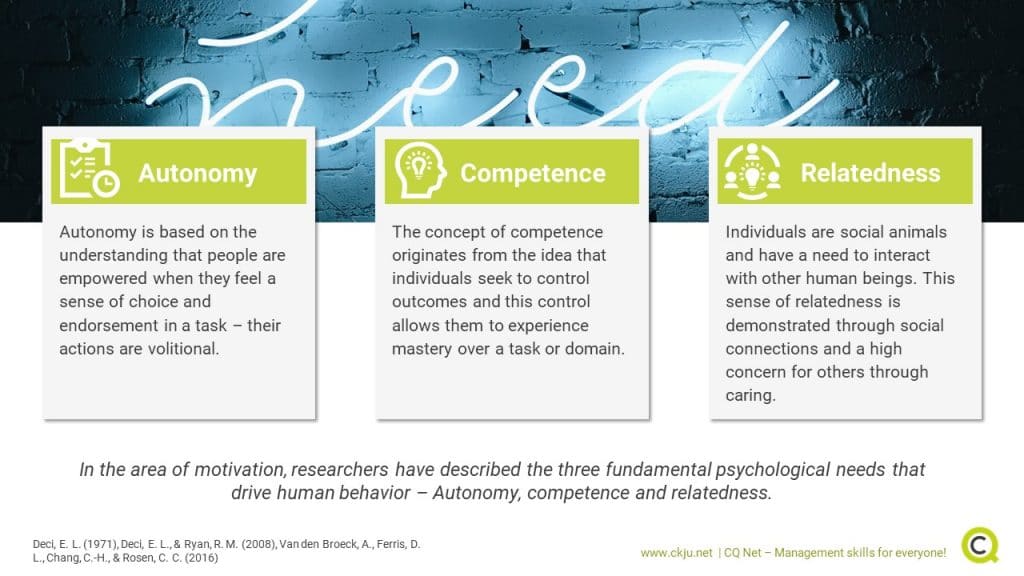
Leaders show competence in autonomy when they encourage their subordinates to realize that they have choices and their behaviour is under their own control. Leaders who allow autonomy are less likely to demand accountability or apply pressure. When leaders show relatedness, they show their subordinates that they care about their contribution to the team and sustain connectedness. Effective leaders also make their employees feel competent by encouraging them to demonstrate their skills and allowing them to grow and flourish.
Servant Leadership Institute Model
Developed by the Servant Leadership Insitute, this model is based on the Servant Leadership concept of “inverting the pyramid”. Instead of focusing on power, the Leader should focus on the inspiration of their people, and play a “servant” role.
Seven Levels of Leadership Consciousness
The Seven Levels of Leadership Consciousness were developed by Richard Barrett, the founder of the management consultancy firm The Barrett Values Centre, at the end of the Nineties. the model is a modern interpretation of Maslow’s Hierarchy of Needs, adapted into two pyramids (Barrett, 1998). These are geared toward the goal of self-actualisation in Leaders.
By using this model, Leaders can establish how much they can develop themselves and adapt in order to have the greatest possible impact on their organisations and teams.
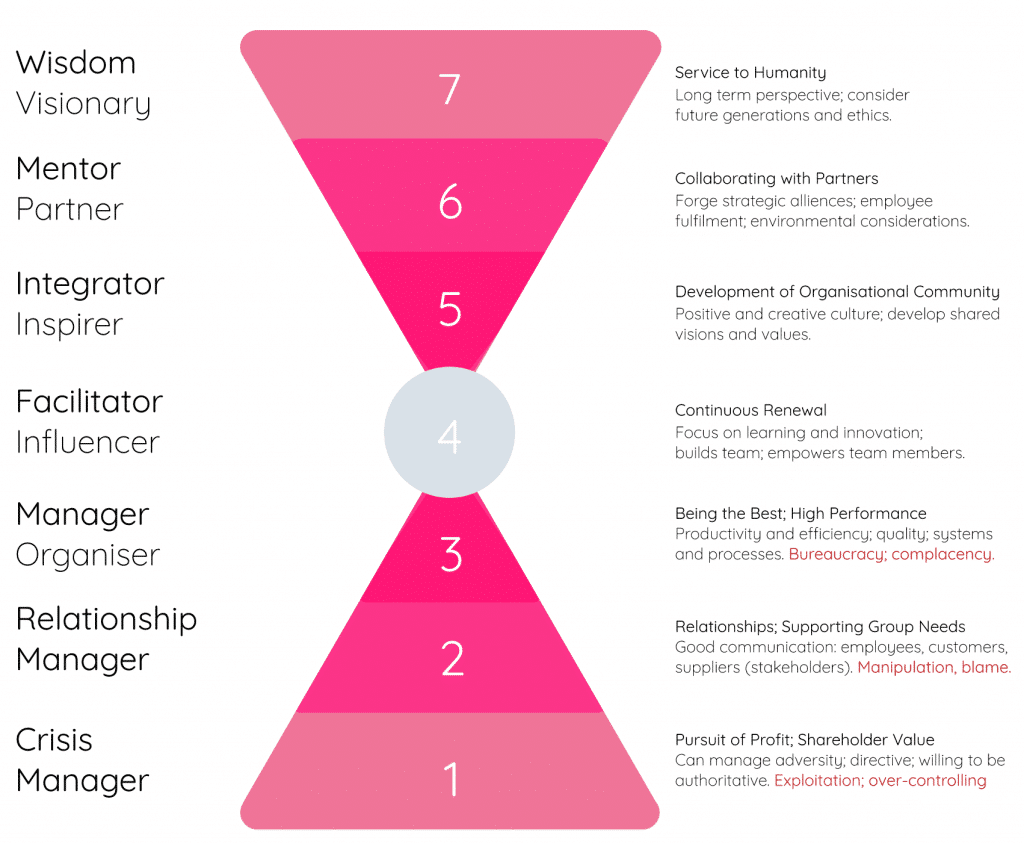
The model illustrates a number of “steps” that can be taken from merely being a “crisis manager”, to becoming a “Visionary” leader, which would be the top possibility.
STAR Leadership Model
The STAR model is a leadership theory that clarifies what leaders need to do in order to perform well. It offers practical tips to help leaders focus their activities. There are three key strengths to the model:
- Integration – It is centered on the need for leaders to align key elements so that individual, team and organisational outcomes are achieved.
- Strengths-based – It emphasises the emerging area of strength-based leadership
- Outside factors – it recognises what is often missing from some leadership models; that leaders need to be as adept at managing outside their team as they do within the team
Student Leadership Competencies
The SLCs are 60 leadership competencies derived from analyzing standards, models, and theories of leadership as well as the outcomes of all accredited academic programs in higher education. A book by the same name contains the entire investigation of this toolkit used by many universities to build their curricula.
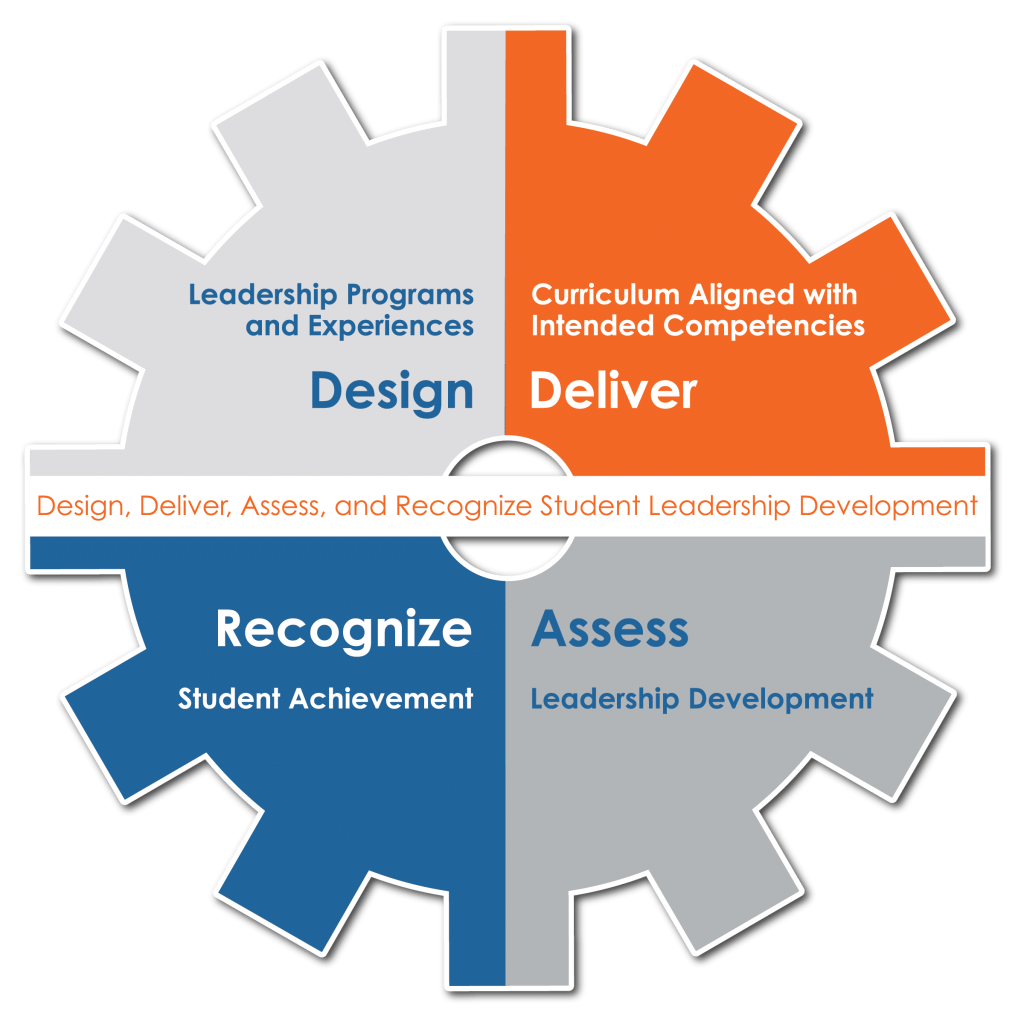
Competency Domains
The original competency dimensions from 2013 included Knowledge, Value, Ability, and Behavior, but those dimensions have been updated to domains and include the following:
Level 1
- Significance: Value of utilizing the competency
- Motivation: Motivation to utilize the competency
- Efficacy: Belief in one’s own ability to utilize the competency
Level 2
- Cognition: Understanding of the competency
- Proficiency: Skills to utilize the competency
Level 3
- Performance: Utilizing the competency
Soul of Business Leadership Model
Soul of Business is a US-based consulting firm. They developed a competency-based model which is value-driven, and is organised into three domains: Self, Relationship and Culture.
Well-Rounded Leader Model
Developed by the Australian consulting firm Leadership Mastery, the model assumes that all leadership development beyond innate abilities starts with self-awareness.
The idea of this model is that leaders need to balance their skills development across all areas: Technical, Business and People skills.
World Economic Forum New Model of Leadership
In 2012 the World Economic Forum established a Global Agenda Council on New Models of Leadership. This council, which included several distinguished academics from all corners of the world, produced a report that identified key trends in Leadership, and suggested the necessary steps to achieve a new “model”.
The report analyses the new context (particularly referring to the VUCA characteristics), and suggests to look at four pillar components. A sense of Purpose, then Social, Intellectual and Emotional competencies, and lists also the key elements of the journey for developing leadership.
C. Values-based Leadership Models.
These models tend to be based on Values and Behaviours rather than solely on competencies. Sometime the definitions may vary, which is why I have sometime associated to this cluster models where there is a clear directionality of the behaviours suggested, even if these are suggested as competencies.
Amazon Leadership Principles

The Amazon Model is based on its famous 14 principles, which allow it to achieve Leadership in the domain it works.
Deloitte Inclusive Leadership
In 2016 Deloitte has produced research focused on the different elements of Diversity in an organisation, and how Leadership is relevant to increase the Diversity Quotient (Bourke and Dillon, 2016). They looked at diversity across different axes: Markets, Customers, Ideas, Talent. And they identified six traits of successful inclusive Leaders.

Inclusive Leadership has been defined to include some basic pillars:
- Treating people and groups fairly—that is, based on their unique characteristics, rather than on stereotypes
- Personalizing individuals—that is, understanding and valuing the uniqueness of diverse others while also accepting them as members of the group
- Leveraging the thinking of diverse groups for smarter ideation and decision making that reduces the risk of being blindsided
Through the research, they identified six traits defined in terms of what they think about and what they do—that are reinforcing and interrelated.
I have listed this model here because the identified traits are not simple competencies, but rather behaviours rooted in values that appreciate diversity.
FIUT Leadership Model
FIUT is a non-profit based at the University of Washington, that promotes international cooperation. They have developed a framework consisting of a number of value-based competencies, underlying 4 key area of interventions: building community, working with others, exploring identiy and changing the world.
I’ve listed this model under this section for the evident linkage of all listed competencies to a positive value statement that underlines the work of this organisation.
Hyde School Inner Leadership Model
Hyde School is a Maine bases US Education institution, with a history of helping students discover their unique potential. Their model tells that, in order to become the best possible self, a person must develop
- an understanding of themselves
- the presence to speak, and
- the grit and confidence to go the distance when the going gets tough.
This is what the School calls Inner Leadership. Students are asked to move past their comfort zones and contribute.
The model lists a number of competencies to be developed, a value system and a support community to achieve its goal.
L’Arche Canada Servant Leadership Model.
L’Arche Canada is a network of charities focused on multiple support actions across Canada. It has identified a model of Servant Leadership based on its core values.
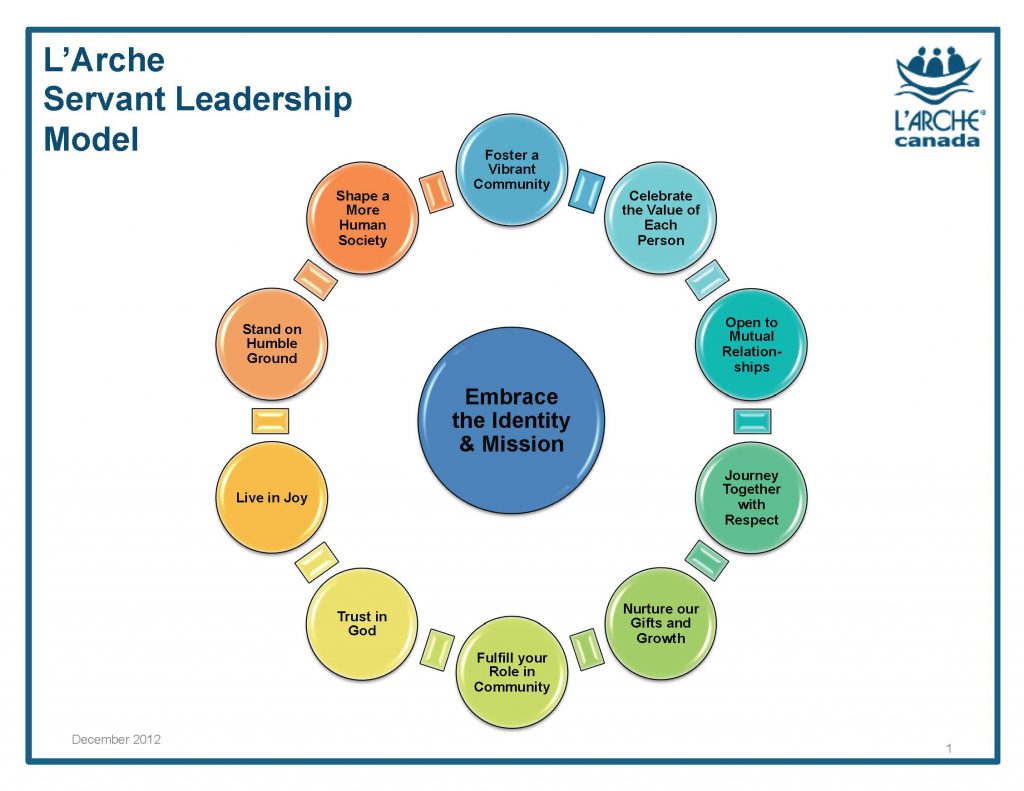
LRN Leadership Framework
LRN is a Knowledge Provider based in the US. It has developed a complex Leadership Model deeply rooted in a set of values. The model includes then a set of skills and behaviours, and a set of “non-leadership” attributes.
The LRN Leadership Framework is an interconnected, mutually reinforcing set of principles that reflects the multi-faceted quality of ethical leadership. It is a living constitution that brings our core values to life, guiding our everyday business decisions and actions, and allowing us to consider our conduct in a broader, more-reflective context that which supports evolution and journey as an organization. The model is extensively derived from Dov Seidman book How.
Spiritual Leadership Model
Developed by the International Institute of Spiritual leadership, “is an emerging paradigm within the broader context of workplace spirituality designed to create an intrinsically motivated, learning organization. Spiritual leadership comprises the values, attitudes, and behaviors necessary to intrinsically motivate one’s self and satisfy fundamental needs for spiritual well-being through calling and membership, which positively influences employee well-being, sustainability and corporate social responsibility, and financial performance – the Triple Bottom Line.”
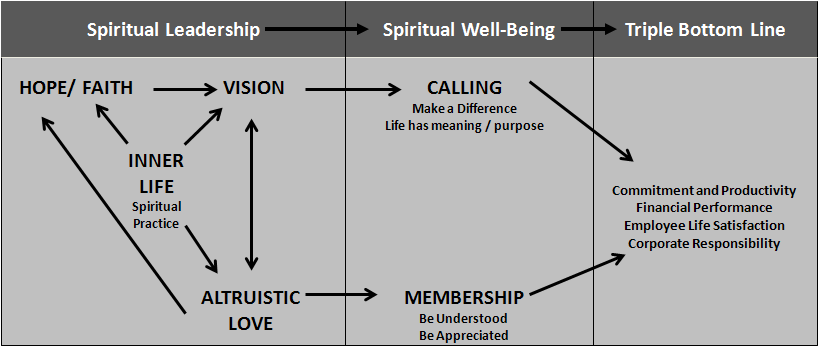
According to the model, the source of spiritual leadership is “an inner life or spiritual practice, such as spending time in nature, prayer, religious practice, meditation, reading, yoga, or writing in a journal”. As such the model does not assume one specific faith or is an expression of a religious stance. However, I decided to list this under the Value-Based category exactly for its reference to this faith dimension.
The 3 Pillars of Authentic Leadership
The 3 Pillars of Authentic leadership model emerged from the U.K. PhD research that Dr. Fiona Beddoes-Jones conducted with senior Royal Air Force officers and U.K. business leaders to explore what Authentic Leadership actually consists of (Beddoes-Jones & Swailes, 2015). Prior to the emergence of the 3 Pillars model, there were a lot of overlapping ideas and theories about Authentic Leadership which were largely based on opinion rather than researched evidence. The 3 Pillars model simplifies and clarifies what Authentic Leadership actually is in practice and what it consists of. Authentic Leadership is shown as sitting under the roof of Relationships and on a bedrock of Trust. The model is explored in-depth in the author’s book: Divided by Gender, United by Chocolate: Differences in the Boardroom.
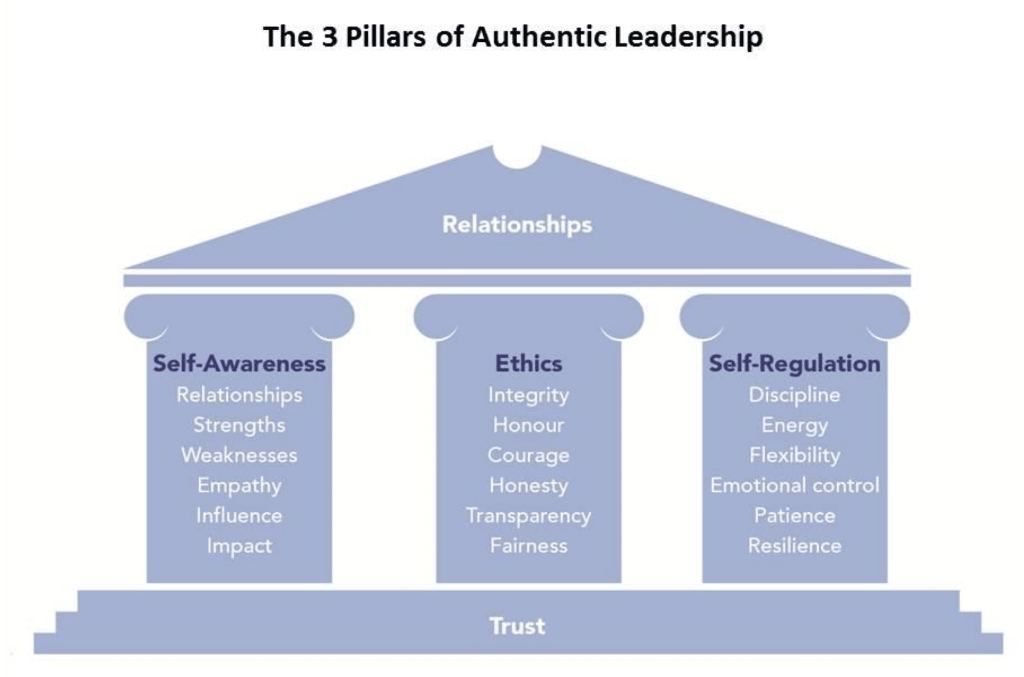
Value-Based Leadership Algorithm
The Value-Based Leadership Algorithm is an attempt to provide a framework for global leadership based on the Value Journey chart elaborated by Robinson in 1998, and integrating several different theories (from Spiral dynamics, thus the use of colours, to Maslow’s Hierarchy of Needs, to Piaget and Egan).
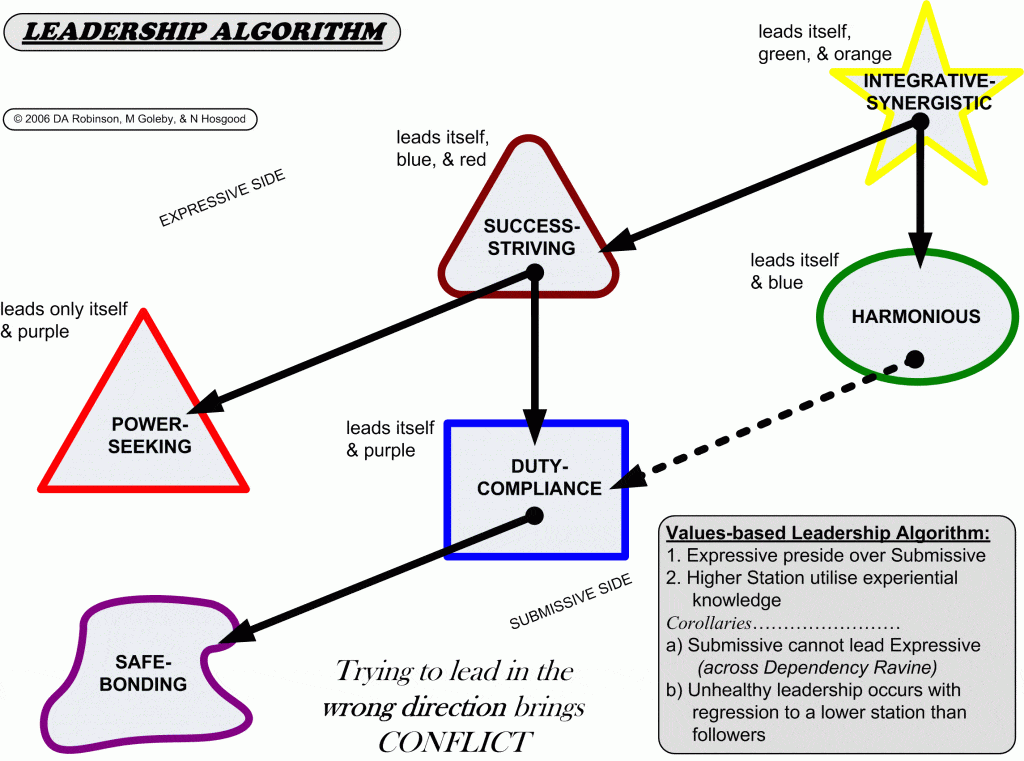
The model proposed (Robinson and Harvey, 2008) integrates psycho-social elements of leadership
and organizational effectiveness, such as conditioning, power, duty, dependence, and ethics. As the Values of an organisation can be plotted on “identifiable values stations” (following the theory of the Values Journey), it is possible to follow the effectiveness of the different Leadership Styles based on the steps, and the ability of followers to adapt. As people move around the different “steps” illustrated by the colours, different Leadership styles might be more adaptable.
Although the authors do not specifically allocate one existing theory to each step, based on the description of their characteristics, it is possible to associate one Leadership theory with each of the steps:
- Power-Seeking becomes Dictatorial Leadership style
- Safe-bonding becomes Charismatic Leadership style
- Duty-Compliance becomes Authoritarian Leadership style
- Success-Striving becomes Transactional Leadership style
- Harmonious becomes Servant Leadership style
- Integrative becomes Transformational Leadership style.
Note that this, however, is only a loose coupling (Goleby, 2018), that marks the idea of the VBLA as a holistic theory.
D. Effectiveness-Based Leadership Models
These models tend to have a much more variegated view of the components that establish Leadership, but they all, however, suggest a level of ideal or “good” leadership be achieved. This is why I have tried to list them as effectiveness-based because they try to identify a style, a set of attitudes or behaviours that is more effective in a particular organisation or situation. They all suggest that there is one positive model of leadership to be sought.
3P Model
Developed by James Scouller this is an ‘integrated psychological’ leadership approach, by definition of the same author. The 3P Model (also known as the Three Levels of Leadership) builds on Scouller’s idea that the leader must ensure there is leadership across four dimensions:
- Motivating future or purpose
- Task and results
- Upholding group spirit and standards
- Attention to individuals (for example, motivation, confidence, selection, feelings of inclusion)
Scouller’s main idea is that for leaders to be effective in all four dimensions, a leader must work on three specific levels.

- Public Leadership: an outer or behavioural level. It covers dimensions 1, 2 and 3 (Purpose, Task, Group Unity).
- Private Leadership: another outer or behavioural level. It covers dimensions 2 and 4 (individual aspects of Task , attention to Individual).
- Personal Leadership: an inner level. It covers all four dimensions (Purpose, Task, Group Unity, Individuals), although less directly than the two outer levels.
Personal Leadership affects all four dimensions because it is the source of the effectiveness of a leader, as it encompasses its presence, know-how, skills, attitudes and self-mastery.
By joining the four dimensions of leadership (elements that we see also in other models) to the different layers, Scouller proposes a truly interesting model, which integrates different points of view. particularly his emphasis on the psychological traits developed at the personal, interpersonal and organizational level, is a noticeable advancement.
4-V digital transformation leadership framework
Developed from the research of prof. Stijn Viaene (Viaene, 2018) the model explores different leadership styles related to the support of Digital Transformation challenges. It looks at a four-quadrant model organised on two axes. “The vertical axis describes leadership as connecting the dots for your organization; ideas on the one hand, people on the other. The horizontal axis represents the ability to routinely explore and exploit opportunities faster than your rivals; that is, being organizationally agile”. (Viaene, 2018)
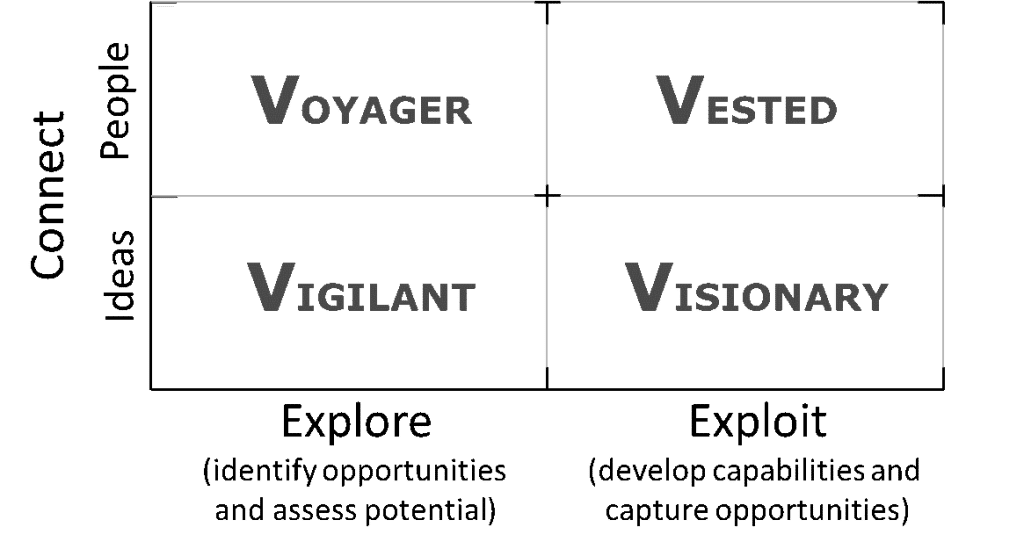
The assumption is that to make a Digital Transformation work, you need all four styles of leadership presented.
- Vigilant leaders make sense of the digital turbulence outside. They constantly scout ideas and opportunity signals beyond the boundaries of your organization or industry.
- Voyager leaders bundle together people’s creativity to quickly show digital opportunities at work, turning abstract opportunities into something tangible.
- Visionary leaders develop an engaging aspirational picture of the organization as it succeeds in the digital age. They bring a sense of purpose and shared goals to the organization.
- Vested leaders go beyond vision and experimentation. They put the complete organization on a roadmap for successful digital transformation, turning it into productive, yet flexible, organizational machinery.
Conceptually the model is not related to specific positions in the organisation, nor to specific personality styles, but rather to specific types of behaviours which guarantee elevated levels of effectiveness in the framework of a Digital Transformation initiative.
ABC’s Of Cognitive Leadership Model
The ABCs of Cognitive Leadership Behavior framework, A + B + C = Success, is a model based on the work of Dr. Albert Ellis (Ellis, 1958). The framework (Harris Whitesell Consulting, 2019) is designed to help people understand the meaning of their own reactions to adversity and stress.
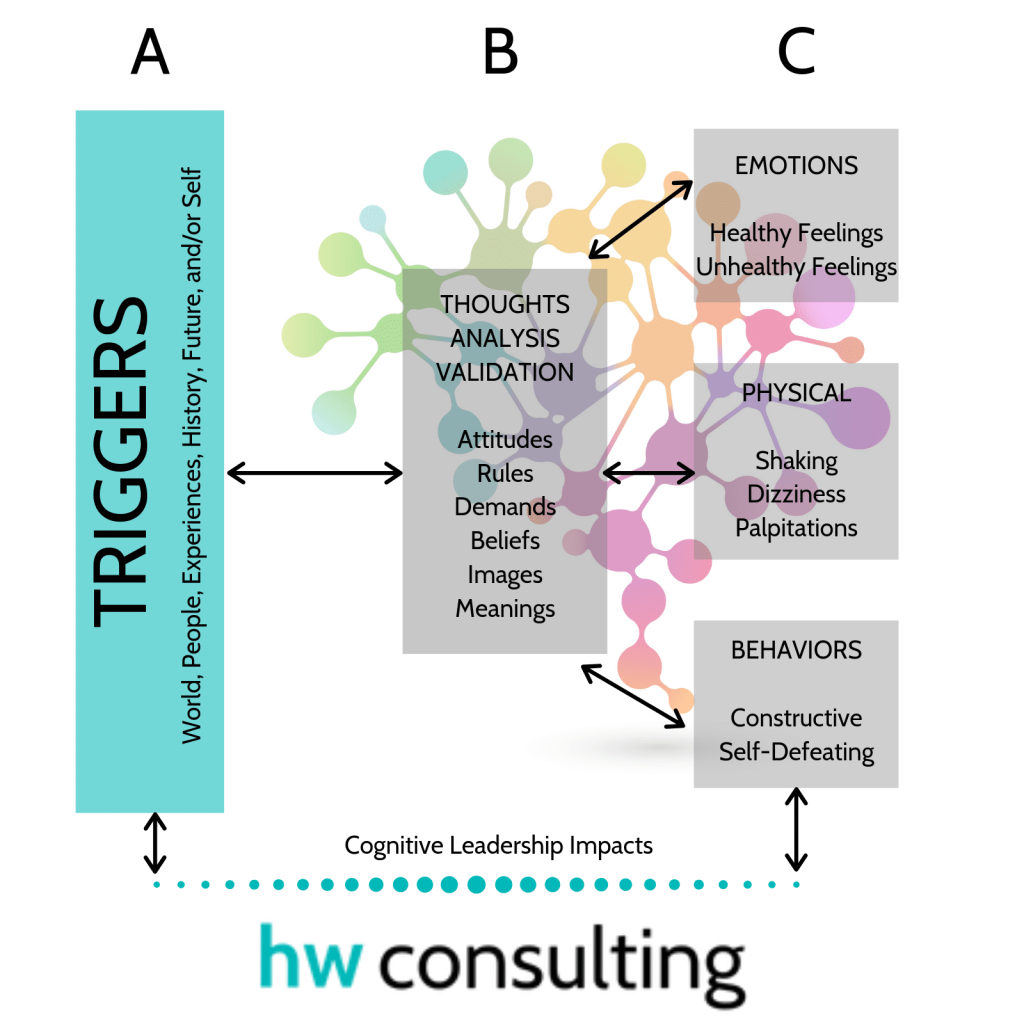
A = Activating and triggering events that create or cause potential stress in an individual.
B = Belief, Thoughts, Analysis and Validation for attitudes, rules, demands, beliefs, images and applied to mean. This is the stage where leaders need to naturally want to stop, pause and take a look to make sure the decision is a good decision that will create value. When this phase of cognition is skipped, bypassed or forgotten, mostly due to bad habits, is where there are the greatest costs and negative impacts and outcomes.
C = These are the consequences, emotions (fear, anxiety, worry, anger, frustration, irritability, sadness, stress, and being alone), physical sensation (dizziness, shortness of breath, headaches, and shaking), and behaviour outcomes that are realized as a result of one’s beliefs, distortions, perceptions, and self-talk (life experiences) in response to the triggers.
The ABCs of the Cognitive Leadership Framework is foundational to executive, leadership, and professional development. Within the roots of this framework is the opportunity for people, who strive to be successful, to understand, apply, and master a natural thought process that is deeply rooted in the mechanics of humanity – at its best. We often overlook this framework because we have been conditioned that most of the terminology is feared or shamed. Beyond this framework are proven assessment and coaching processes to identify and create measurable and lasting change in key behaviours that are either stopping you or keeping you from desired outcomes and success.
Agile Leadership by Accenture | SolutionsIQ

This model looks at two axes: Drivers of Agile Leadership and Horizons intended as impact areas, and effectively identifies nine domains that should be mastered to allow for what the authors identified as truly Agile Leadership.
Agile Leadership and the GRIP Framework
Developed by Dutch consulting firm Prowareness, it also focuses on a view of Agile Leadership, also embedded in Peter Koning’s book Agile Leadership Toolkit. It essentially identifies four dimensions that would allow a leader to thrive in an agile environment.
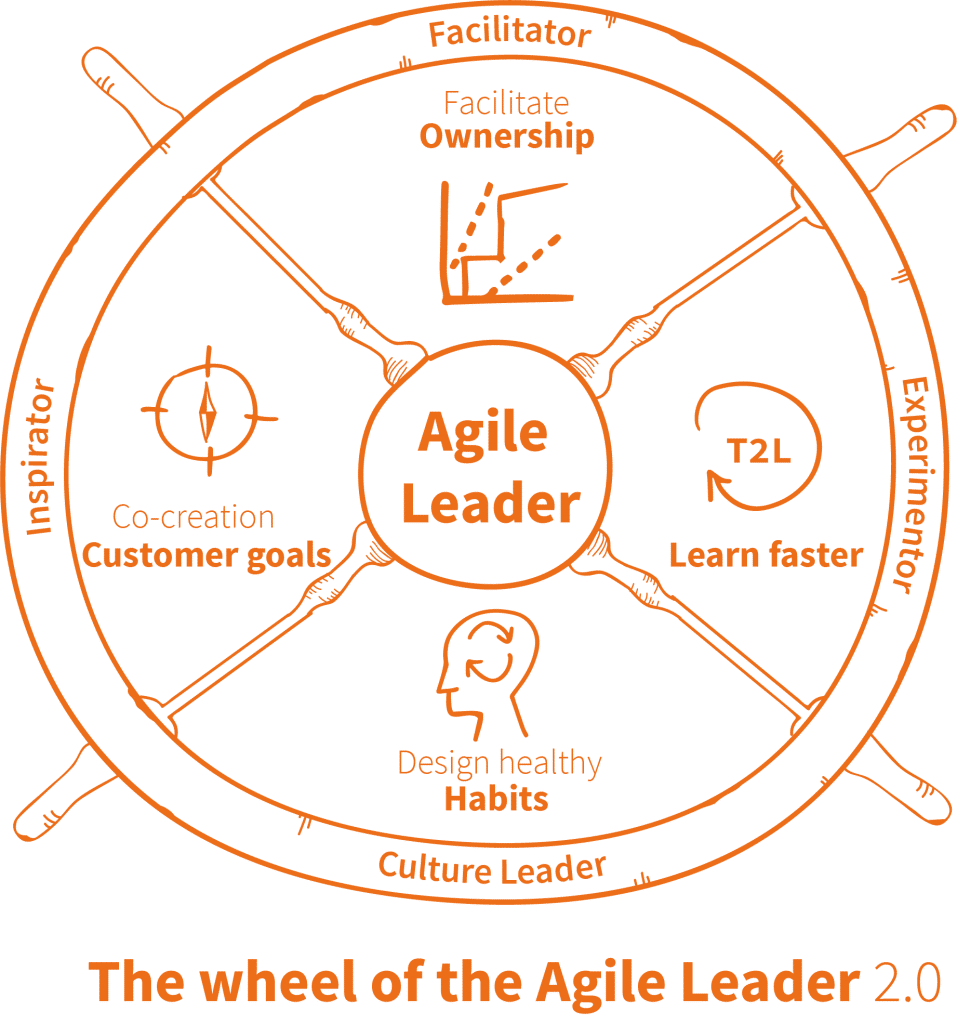
Agile leadership ensures that teams have more freedom, and at the same time clarity about what needs to be achieved. When implementing Agile leadership within Agile organizations, not only ownership and self-management increase, teams also work more towards quality, sustainability and effectiveness. More time can be used to continuously improve and to eventually establish a Responsive Enterprise.
The Anatomy of a Leader by Think & Grow Business
This framework has been developed by the Australian based consulting firm Think & Grow Business. The model breaks down leadership into three “simple messages” that cover what they define as “the leadership equation”.
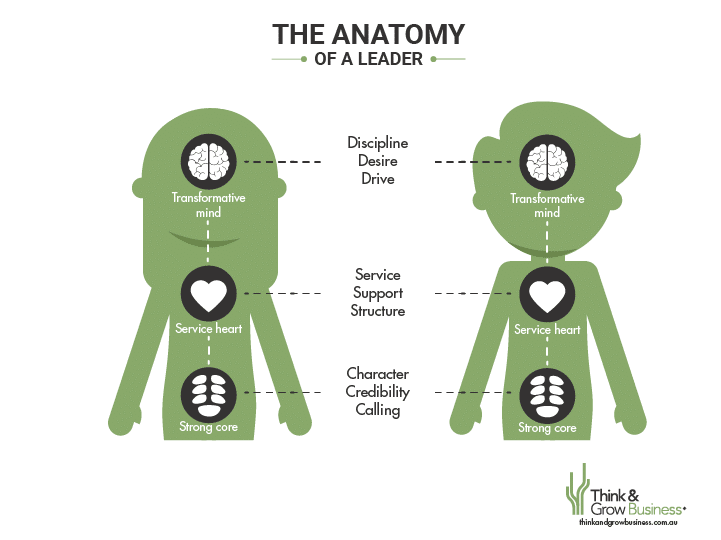
These are identified as Transformative Mind, Service Heart and Strong Core. For every three characteristics are chosen to identify the key traits supporting an effective leader. Note: This framework can be used, according to the authors, to define specific company based Leadership Models.
Apple Discretionary Leadership Model
The Apple Discretionary Leadership Model is described in a long article that appeared in Harvard Business Review about Apple’s capacity to innovate.
It looks at a number of adaptations that Apple’s operating model underwent to support both its growth and capability to innovate. These adaptations have been codified in the discretionary leadership model, which is incorporated into a new educational program for Apple’s VPs and directors. Its purpose is to address the challenge of getting this leadership approach to drive innovation in all areas of the company, not just product development, at an ever-greater scale.
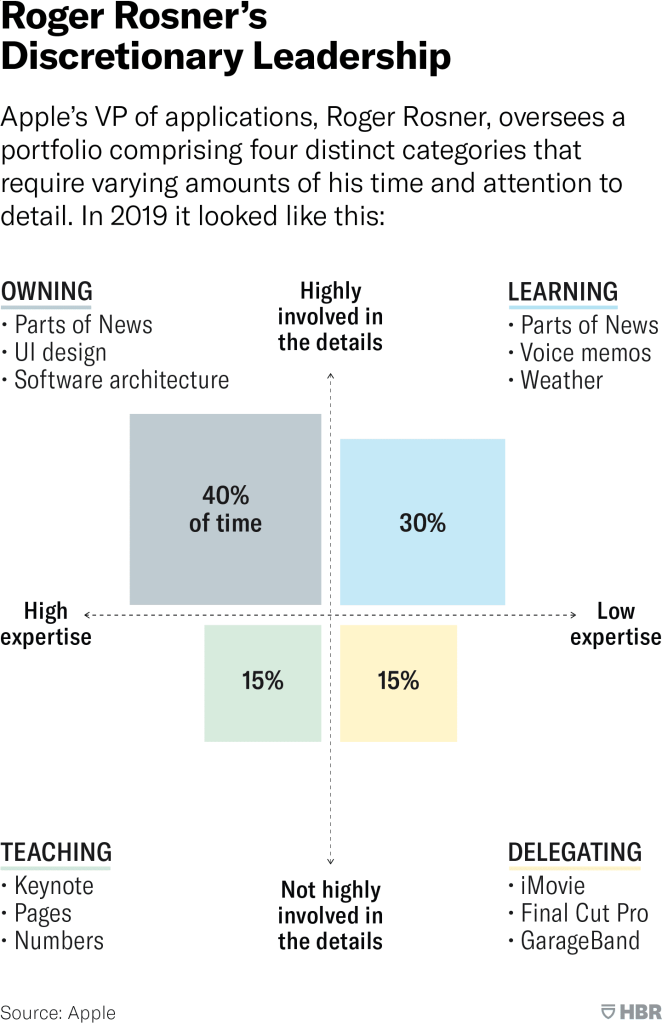
…they now need to exercise greater discretion regarding where and how they spend their time and efforts. They must decide which activities demand their full attention to detail because those activities create the most value for Apple. Some of those will fall within their existing core expertise (what they still need to own), and some will require them to learn new areas of expertise. Activities that require less attention from the leader can be pushed down to others (and the leaders will either teach others or delegate in cases where they aren’t experts).
The discretionary leadership model preserves the fundamental principle of an effective functional organization at scale—aligning expertise and decision rights. Apple can effectively move into new areas when leaders like Rosner take on new responsibilities outside their original expertise, and teams can grow in size when leaders teach others their craft and delegate work. We believe that Apple will continue to innovate and prosper by being organized this way.
Authentic Leadership in Virtual Organisations
In the wake of the Covid-19 pandemic, CapGemini has pushed forward the idea of a specific leadership to sustain organisations that become virtual during the lockdown. This is based on research developed by Capgemini Research Institute in March 2020 (Capgemini Research Institute, 2020) that looked at the necessary elements to sustain a virtual organisation.
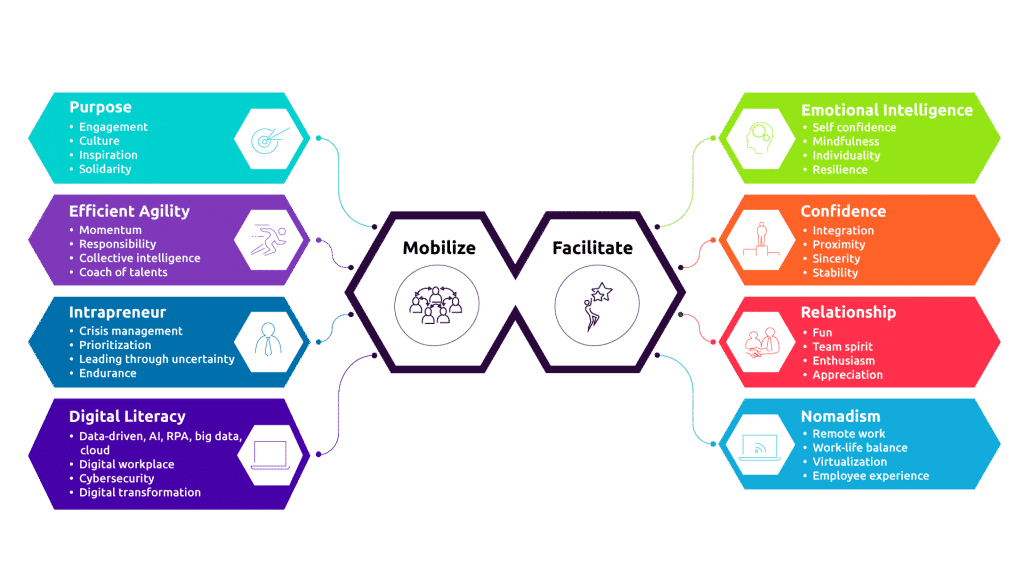
The suggested model looks at two focus capability areas: Mobilisation and Facilitation. These are very much related to digital skills that can support a Virtual and Remote Organisation Maturity, but also overall help in a specific situation such as the lockdown moment.
BCG’s Leading in the new Reality
BCG has developed some ad-hoc research related to the new Covid-19 situation, and have suggested a new framework of reference that also includes Leadership.
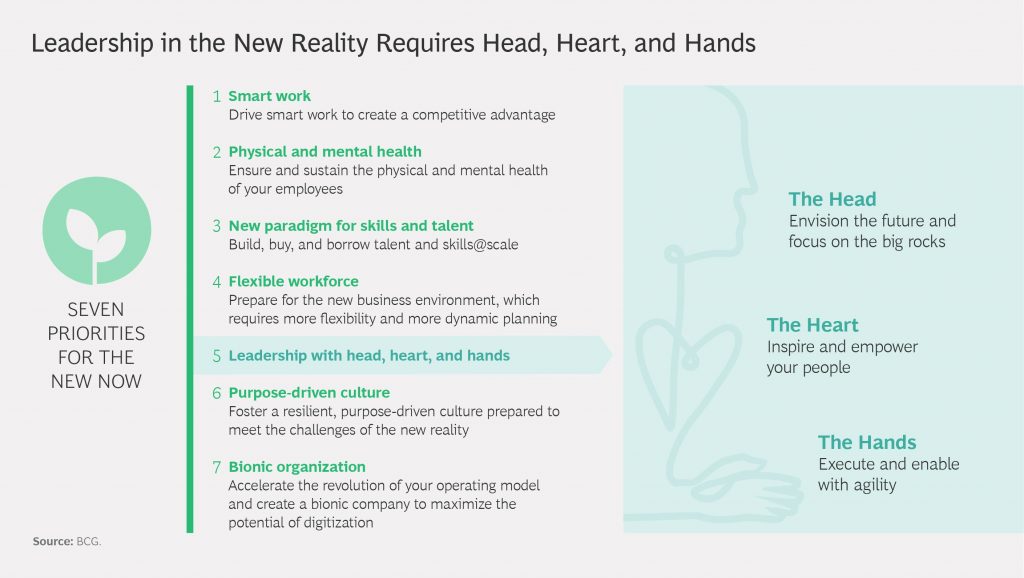
This framework, beside giving a contextual evidence of where things are changing, looks at three domains that leadership need to master: Head, Heart and Hands.
ConantLeadership Flywheel
Developed by Doug Conant, this framework illustrates eight practices that the author identifies as foundational to establish a Leadership that Works.
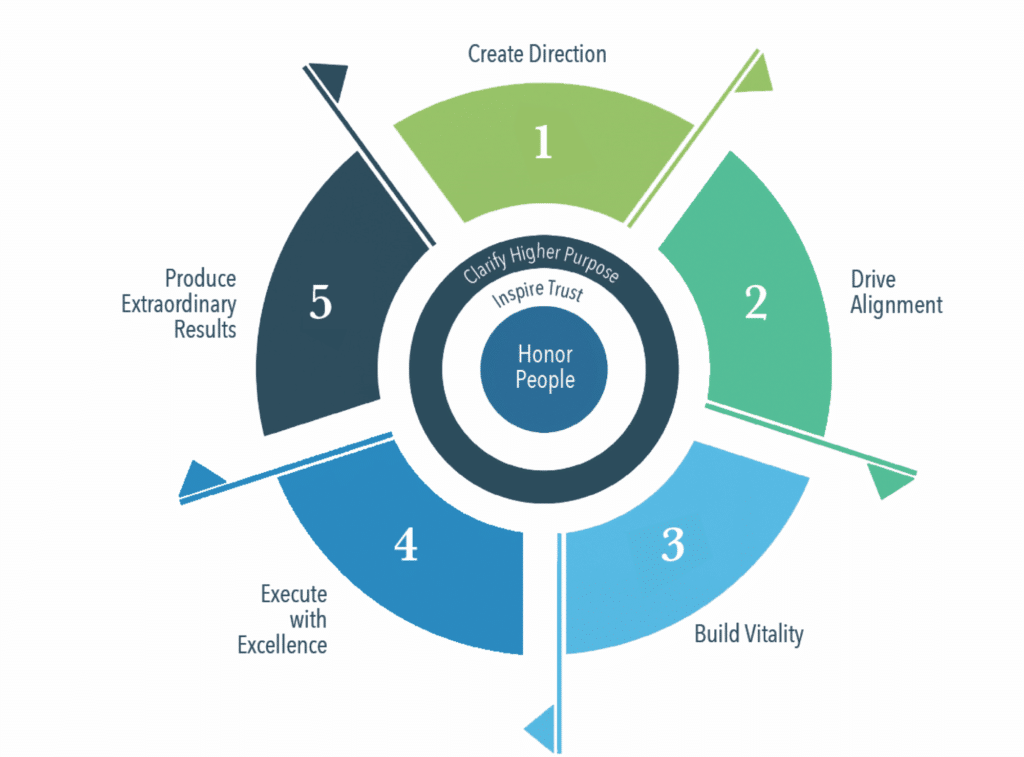
The idea is that every person can develop its own Leadership Model, based on an harmonic development of these practices. This is an interesting thesis developed in Conant’s latest book, The Blueprint: 6 Practical Steps to Lift Your Leadership to New Heights where he illustrates several individual as well as organisational models as examples of integrated approaches that still establish their foundation in the Flywheel practices.
Also note that the flywheel is constructed on three practices that are core for all the others: Honor People, Inspire Trust and Clarify a Higher Purpose, while the other five sort of create a “leadership sequence” that improves the effectiveness of a leadership style. Underlying these there are of course specific competencies that can be developed according to the model.
Connectional Leadership Model
The concept of Connectional Leadership has been developed in the framework of various Christian communities in the US. This version of the model is interesting as it illustrates the connection between Instrumental Leadership (a style that sees others as instruments to achieve a goal), Individualized Leadership and Relational leadership. These clusters nine total leadership expressions, which even if not practiced by everyone, need to drive aweareness especially when leading a community.
Discretionary Effort Leadership Model
Developed by Doug Ross and Karla Brandau, the model substantially reflects the elements of Marlow’s Pyramid and assigns to them an effort that each Leader should play. The goal? Get employees to deliver what is named as “discretionary effort”, i.e. that element of going beyond standard performance, and boosting team productivity. This is illustrated in the book How to Earn The Gift of Discretionary Effort: 21st Century Leadership (Brandau and Ross, 2018)
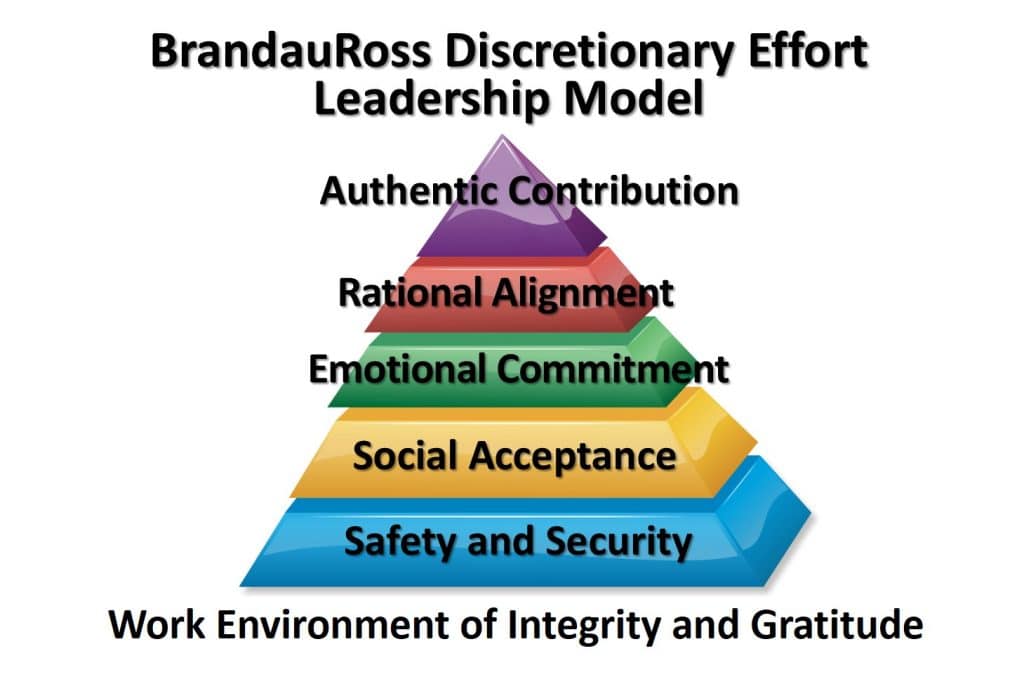
Distributed Leadership Model
Developed as part of a project on Distributed Leadership in the education sector by a number of Australian universities, this model is based on four foundational dimensions of distributed leadership:
- A Context of trust. Distributed leadership is based on trust in the expertise of individuals rather than reliant on regulation that has been the traditional source of managerial authority. While distributed leadership does not preclude regulation or formal positional leadership, this is tempered by broader engagement of many people. Distributed leadership is thus a means to build institutional leadership capacity.
- A Culture of autonomy. Distributed leadership is based in a culture of autonomy rather than control. Individuals are respected for their knowledge that is the source of new approaches to ambiguity.
- Acceptance of Change. Distributed leadership accepts the need for change in the process of decision-making and implementation that enables top-down, bottom-up and middle-out decision making and implementation. Distributed leadership is thus a more participative approach to change in which individuals feel safe and facilitated.
- Collaborative relationship. Distributed leadership places a central focus on the development of collaborative relationships that encourage, nurture and develop leadership capabilities in many people. culture for the introduction of distributed leadership. (Jones et al., 2012)
The model, represented as an umbrella, looks at 6 different activities: Engage, Enable, Enact, Encourage, Evaluate and Emergent. And a programme of continuous improvement through Plan, Act, Observe and Reflect cycle.
Dynamics of Leadership Development
Rather than being a specific model of Leadership, this contribution represents a possible framework for how Leadership is developed. Built against the background of Servant Leadership, Raymond Wheeler has tried to represent different development paths.
It offers “a snapshot that allows a leader to see development opportunities that may be missed and to also realize that development occurs serendipitously as well as intentionally in daily life”.
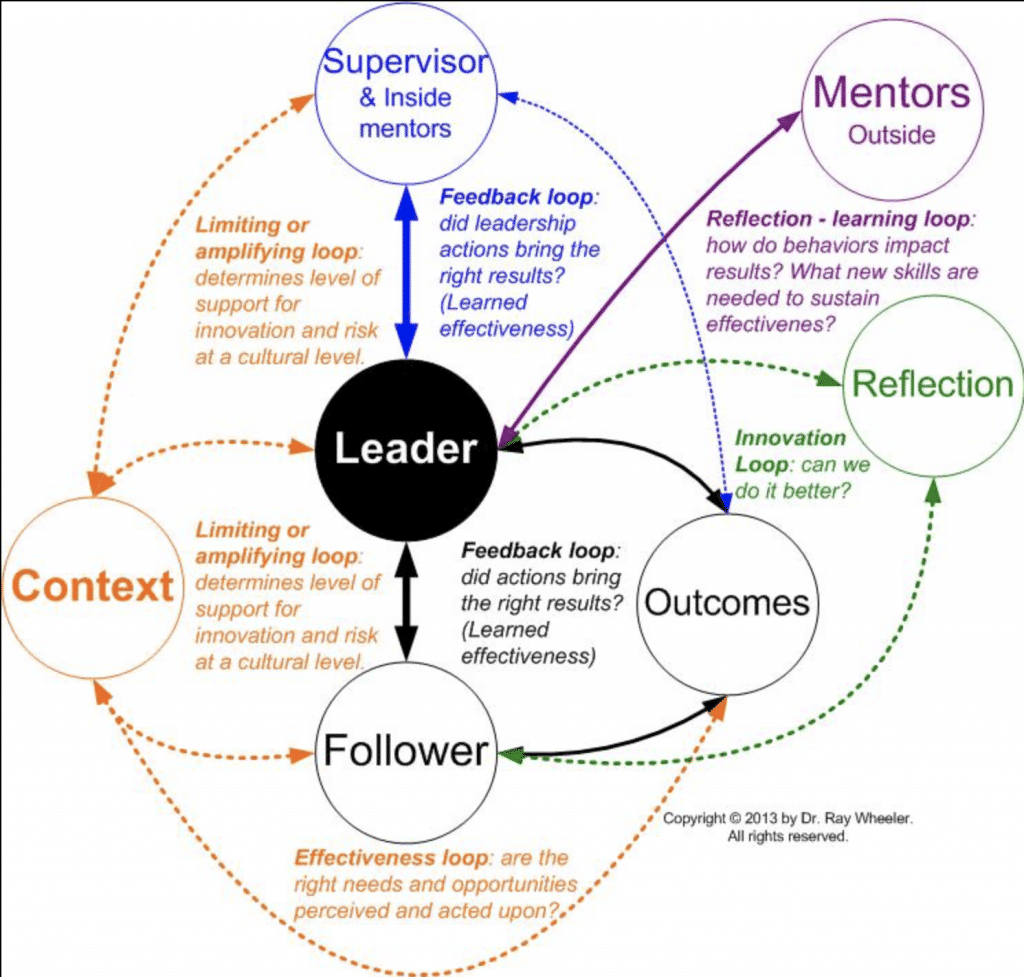
“The figure visualizes the various dynamics that help shape how a leader thinks and how they act. The arrows indicate feedback loops that alert the leader to the effectiveness or ineffectiveness of their actions. Feedback alerts a leader to the need for altering behaviours or actions, increasing resources or reflection that challenges the leader’s prevailing mental model about how to define reality and causation. If the leader’s mental model is left unchallenged then incomplete correlations between causation and outcome lead to frustration and increased activity that has little bearing on effecting altering outcomes.”
Elastic Leadership
This model represents a methodology developed by Roy Osherove to grow self-organising teams. Based on the book by the same title, the methodology looks at three steps that teams can find themselves into, and three specific leadership styles that best fit each stage.
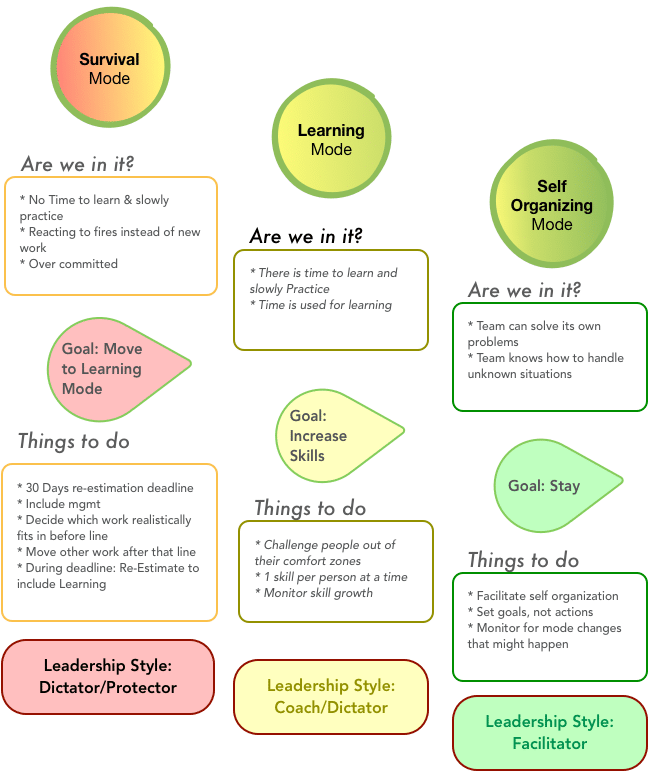
The foundational concept is that team can be grown, and therefore these stages might be all relevant in the life-cycle of a team. It is important to recognise the patterns for each and especially insist on the self-organisation only when the team is capable to undertake such an strategy.
Exemplary Leadership
This model has been developed in the book The Leadership Challenge by James Kouzes and Barry Posner in 1987, and has developed a large practice of adoption across the world. The concept is based on Five Practices identified in the research, and that the authors claim are still valid more than thirty years after the original study.
Behind each of the five practices there is a set of established behaviours, that the authors linked to the individual feelings of people when they felt at their best. The model is calling in directly the concept of leading by example, articulating this into practices that establish effective leadership.
EXO Leadership Model
Developed by Jaroslav Dokoupil as a way to support the concept of Exponential Organisation, the model is described as a “new paradigm of leadership which is essential for humanity to steer towards a positive version of the future which fully benefits from the available opportunities while avoiding dangers, challenges and overcoming limitations of our past.”
Exponential Leadership Framework
Developed by Lisa Kay Solomon for the Singularity University (Solomon, 2018), the Exponential Leadership Framework looks at four types of leadership that are particularly effective into the current VUCA environment. Each model is made of a Mindset and a number of Skills. The underlying concept is that we need a network of Exponential Leaders to be able to create new futures (Solomon, 2017).
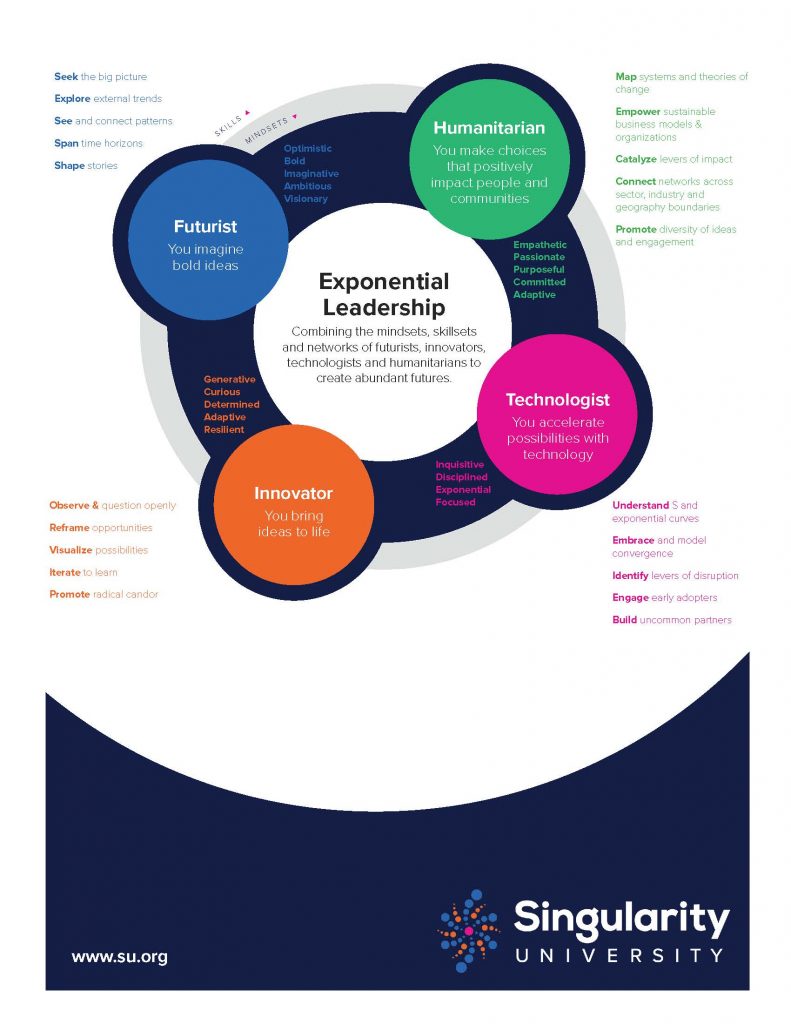
The model is very captivating in terms of its references, but also in its mix of underlying concepts, linked not just to technological advancement, but also to the capability of envisioning the future. A central element in the mission of Singularity University.
Gaurav Gargate Leadership Model to keep me sane
The discussion around Leadership Models is not only limited to academic circles or consulting firms. As people enter management roles, they very often have to face the complexity of trying to understand what Leadership truly is.
Gaurav Gargate has questioned exactly this. “Leadership expectations will stretch you thin and make you crave for a thirty-hour day!” (Gargate, 2018). So, he put for himself a model that is essentially a prioritization matrix for his own actions as a leader.
For each of the layer, he identifies the key skills, competencies and behaviours that are required to succeed as a leader. A simple yet powerful framework of reference.
Herbig – Wiederwohl Leadership Model
The Herbig – Wiederwohl Leadership Model has been developed by Shawn Herbig from IQS Research and Mary Ellen Wiederwohl. This model is built on the assumption that a pyramid of behaviours can build Positive Leadership, and looks at Love as a guiding philosophy for success.
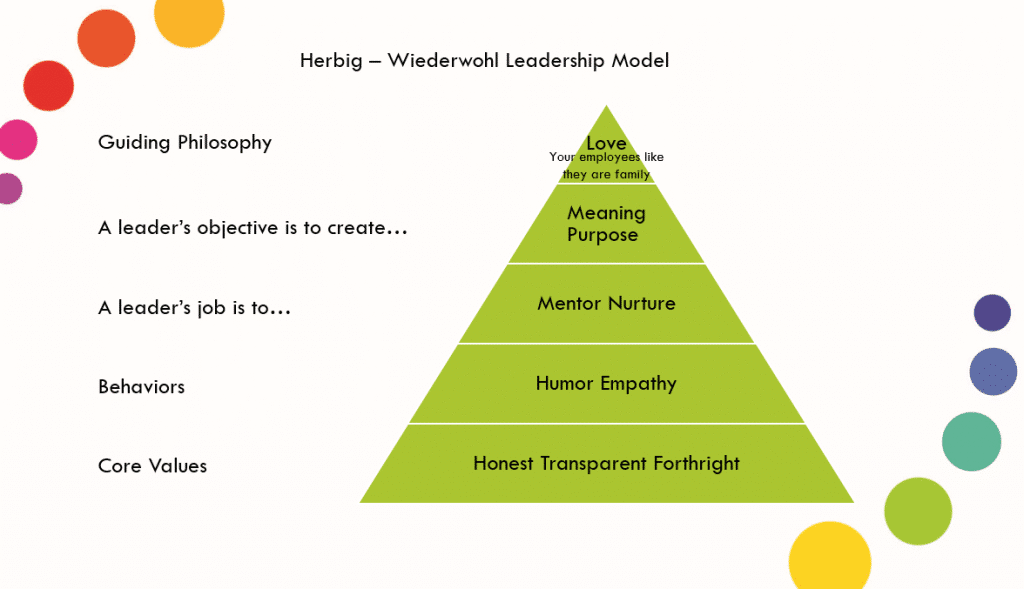
Hudson Leadership Model
Developed by global HR Consulting company Hudson, the Hudson’s Leadership Model has been developed in Europe and is also predicated on Hudson’s British Psychological Society-accredited Business Attitudes Questionnaire.
The context of the organisation is evaluated to understand the degree to which each leadership element is critical to an organisation achieving its strategic objectives.
The model focuses on five key elements of leadership – Vision, Action, Impact, Connection and Drive – each brought to life in specific behaviours. Performance, potential and derailers can all be looked at through this leadership model to deliver actionable insights.
Highly focused on the tools and assessments the company developed, the model allows for a situational understanding of Leadership drivers in different contexts.
Integral Leadership & Management Framework
This model has been developed by Ron Cacioppe of Integral Business Leadership Group, a consulting company heavily influenced by the work of Ken Wilber and its Integral Model. In it, we can however also see the influence of Robert Quinn’s Competing Values Framework.
The four quadrants translate into the four ‘functions’ of leadership & management:
- people leadership,
- transformational/visionary leadership,
- task/performance management, and
- strategic goal management.
According to this model, the functions of leadership & management incorporate the skills and behaviours of individuals, teams and organisations.
Incremental growth leadership Model
Proposed by Trev de Vroome as part of his analysis of Agile Organisations, and the required different Leadership paradigm, the model is based on the idea of development of a “Conversation Canvas”, capable to overcome the limitations of the Team Canvas tool, that the leaders uses to interact with the team and derive results.
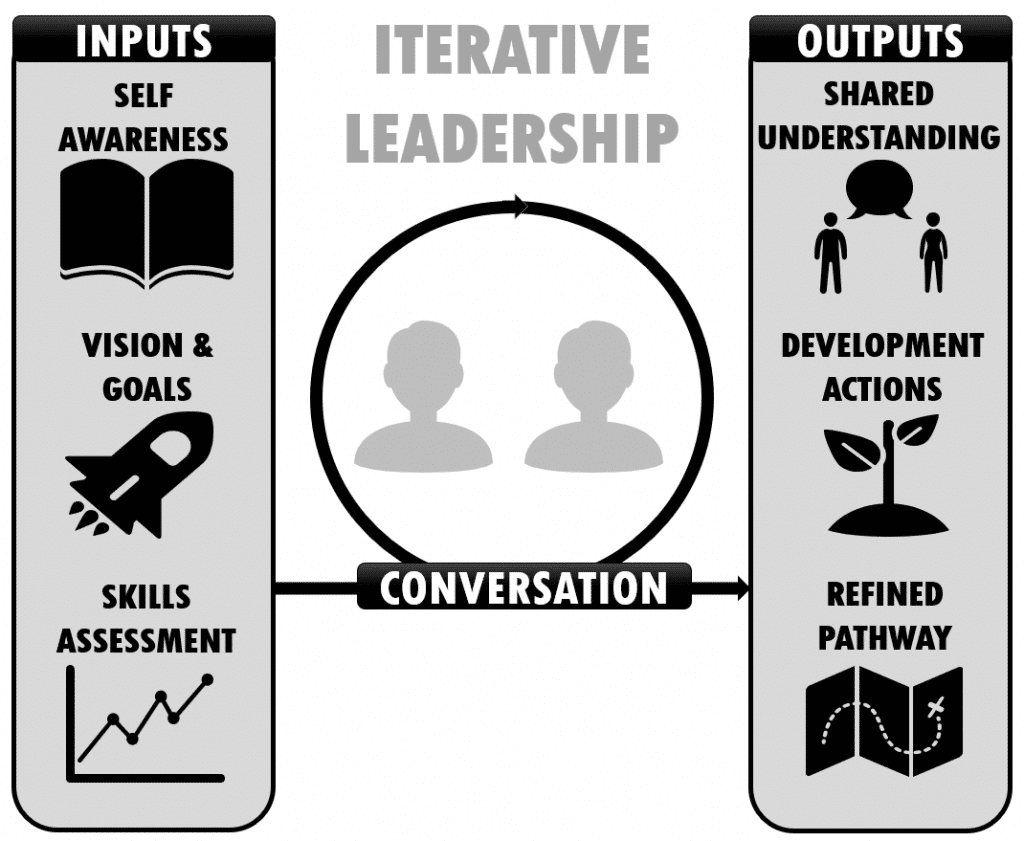
“The Iterative Leadership model is a regular, time-boxed conversation between leaders and individuals to create a shared understanding — while proving a regular mechanism to inspect and adapt the development of talented individuals towards their learning and career goals.” (Vroome, 2019)
The model is based on a number of Inputs founded on Self-Awareness, and a number of outputs that relate to shared understanding, development actions and refined pathways. Developed based on the context of Agile, I see some very interesting value also in generally managing and leading a team, not necessarily structured as a scrum.
Leadership in a VUCA World
Developed in 2016 by Tanmay Vora, this is an inventory of necessary Leadership Skills needed to succeed in a VUCA world.
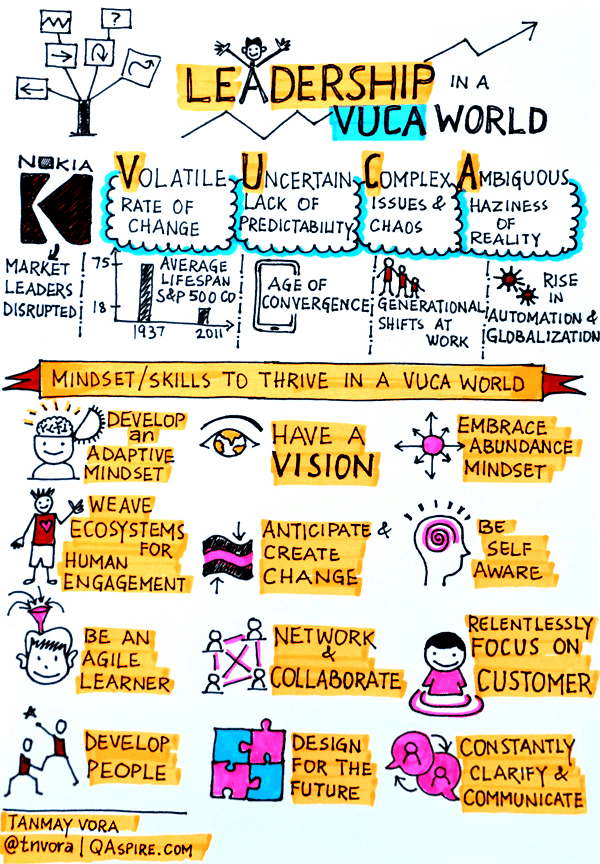
The Leadership System
Developed by consulting firm Full Circle Group, and based on the work by Bill and Cindy Adams in their 1999 book The Whole Systems Approach, the model detail six interlocking systems that must be tended to during major organizational change. Ensuring that these six systems are aligned and functioning well is the responsibility of the organization’s leadership, which is itself a system to be continually improved.

The model has been developed in several interconnected learning tools, as well more generically, in a systemic approach.
The Leadership Tent
John Zenger and Joseph Folkman (2009) in their book The Extraordinary Leader: Turning Good Managers Into Great Leaders, propose a simple visualization model of leadership.
Imagine a standard tent held up by five tent poles (or clusters of leadership competencies and behaviours). The centre pole is called Character. It includes integrity, ethics, and humility. The four poles that support the tent sides are Personal Capability (technical/professional expertise and cognitive ability), Focus on Results, Interpersonal Skills (including communicating, inspiring, connecting, developing) and Leading Organizational Change (the highest expression of leadership, according to the authors).
These “poles” are made up of clusters of competencies—sixteen in all—that, according to the authors’ research, differentiate the most effective 20% of leaders from the rest. Extending the metaphor, “leadership effectiveness” equates to the total cubic volume under the tent canvas. So, when you heighten the length of the poles—i.e. enhance competencies—overall effectiveness will increase.
Leadership becomes a “balancing act” of these clusters, and no one pattern or configuration of competencies exists that works for all leaders or in all organizations. According to the model, there is, emphatically, no one way to lead.
Lean Leadership Development Model
Developed by Jeffrey Liker in his book Developing lean Leaders (Liker and Trachilis, 2014), is a model that tries to integrate various Lean practices derived especially from the Toyota experience, into a model of Leadership Development.
Michigan Model of Leadership
Developed by Michigan University, it is a framework which provides a lens to understand which leadership skills learners have already polished and which skills need improvement. The Michigan Model of Leadership is based on empirical research and real-world practice. It simplifies enormous complexity by utilizing the Competing Values Framework (CVF), which was developed by Robert Quinn, Kim Cameron, and other Michigan faculty, and has been widely adopted.
The model is built on three level of analysis that explode the competencies chosen for each of the 4 quadrants of the CVF framework.
- Mastering & Developing Yourself
- Empowering Peers & Employees
- Building Teams & Organizations
NHS Healthcare Leadership Model
This model has been developed by the NHS Leadership Academy in 2013 in the UK, and “describes the things you can see leaders doing at work and demonstrates how you can develop as a leader”. The model is organised around a number of nine leadership dimensions that are considered relevant for people at any level in the organisation. For each dimension, leadership behaviours are shown on a four-part scale which range from ‘essential’ through ‘proficient’ and ‘strong’ to ‘exemplary’. Behaviours are presented as questions.
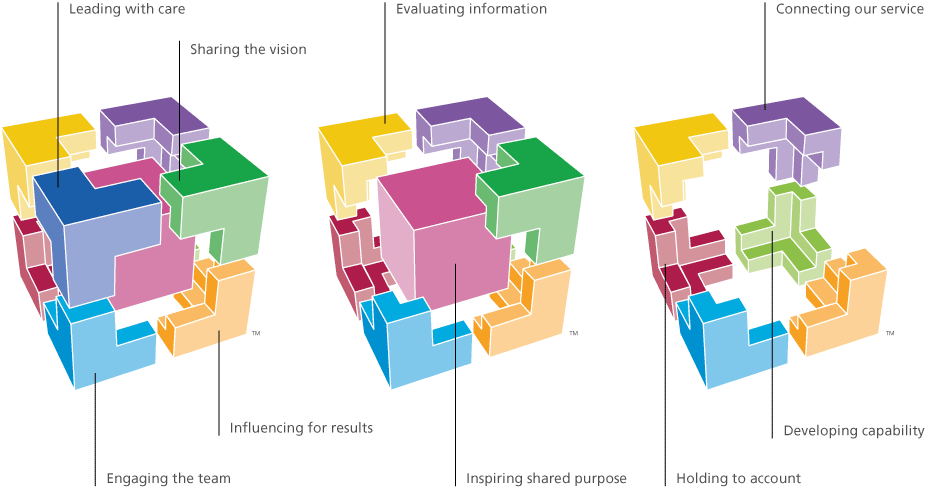
The model includes self-assessment tools as well as a 360′ tool, which are accessible to everybody. Moreover, a section focuses on individual qualities, and how they impact the effectiveness as a leader.
Primary Colours® Model of Leadership
The Primary Colours® Model is Edgecumbe’s proprietary model of leadership. “The model provides a common language and set of criteria for assessing and developing leadership at all levels for individuals, teams and whole organisations. Its focus on tasks makes it easy to translate business challenges into leadership challenges and to define what we need to do as leaders to meet our specific challenges.”
Safety Leadership at Work – Queensland Government
Developed by the Queensland Government (Australia) Health & Safety regulator, it is an interesting take on leadership applied to a specific sector. Safety becomes a cultural attribute for organisations of various size, for which a distinctive leadership is required.
Self-Action Leadership Model
This model has a strong behavioral lense, as it is based on Self-Action Leadership therapy.
Tribal Leadership
The concept of tribal leadership has been introduced by David Logan in his book Tribal Leadership: Leveraging Natural Groups to Build a Thriving Organization in 2008. A tribe is a self-assembling group of 5-150 people who have something in common. This could be your business, your club, your colleagues, or your church group, for example. But they are not always what you assume they would be. They are groups or groups within groups where people find a shared camaraderie and interest.
The author has identified five stages of maturity and performance for the tribes. And leadership needs to evolve accordingly, developing tribes to move up the maturity scale. The themes identified are a simple way to relate to the leadership challenge of each tribe stage.
E. Leadership as Purpose
These models give to Leadership a broader definition, looking at the impact the Leader has on stakeholders, the external environment and society in general. Here the role of Purpose, not just of the Leader, but of the organisation in general, give a further sense of direction that I wanted to highlight through a separate cluster.
The Bridging Leadership Framework
Developed by the Asian Institute of Management, this framework is utilized as part of the Bridging Leadership Fellows Program. It is a framework that addresses the needs of a developing country (in this case the Philippines), and looks at developing leaders that can support a multi-stakeholder environment essentially from a public perspective.
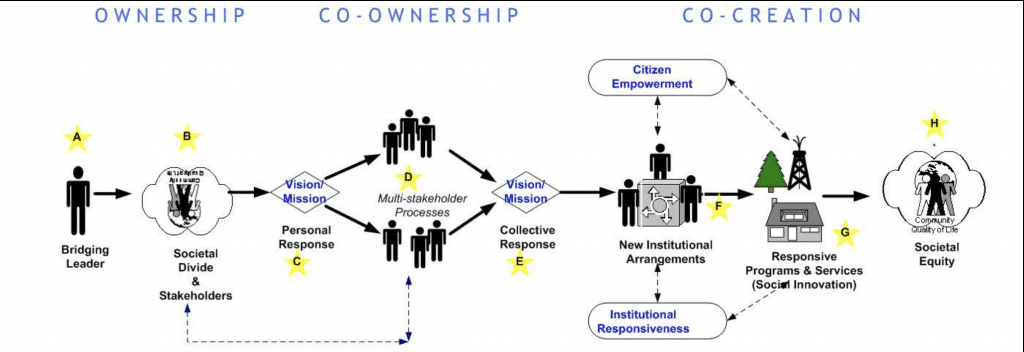
Cambridge Impact Leadership Model
The Cambridge Impact Leadership Model, developed by the Cambridge Institute for Sustainability Leadership, frames the quest for a Leadership capable of “delivering value for business, society and the environment”. The idea is a Leadership that is strongly guided by a purpose, to align business success with the delivery of positive outcomes for society and the environment.

The Collective Leadership Compass
Developed by Petra Kuenkel, Executive Director of the Collective Leadership Institute, this model is a “guiding structure that helps navigate complex settings collaboratively and implement more outcome-oriented and constructive co-creation on a day-to-day basis – for individuals, teams, an entire organisation, and cross-sector co-operation initiatives” (Kuenkel, 2013).
The compass suggests six competency areas (or rather impact areas) that as leaders we need to attend to and develop further in the way we lead collaboration and the way we contribute to collective action. For each of the six competencies to come to life there are three elements requiring attention. They all contribute to strengthening the individual capacity for navigating the challenges and help a group of leaders stay on track in complex multi-actor settings.
I’ve listed this model here rather than in the category of competency-based models, because the way this model is defined is directional in the way it aims at developing sustainability through collaboration. However, as with many models here, its classification can be overlapping more than one category.
Equity Leadership Model
This model, designed in the US by Kitty Gogins, aims at providing leaders with “a framework for creating a learning environment where students, across their many differences, engage deeply and achieve at higher levels while staying true to who they are”. I am listing it under the purpose-led category, because of its strong aim at impacting systemic racism.
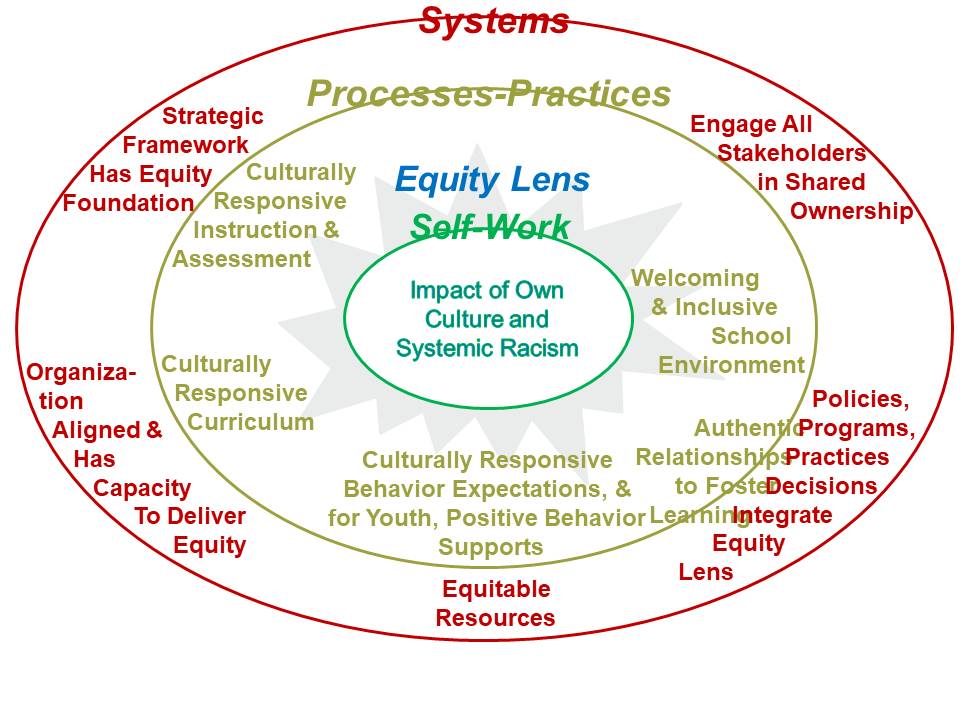
The model lists a number of resources, skills and practices that are essential, looking at how education leaders can foster better integration through multiple process lenses, starting however from self-work on awareness.
Leipizig Leadership Model
Developed by the Leipzig Graduate School of Management, the Leipzig Leadership Model is a purpose focused leadership model that includes an effectiveness aspect to it. The model is based on four foundational dimensions: purpose, entrepreneurial spirit, responsibility and effectiveness. Its core idea is to “motivates active reflection of the opportunities and fields of tension in the dimensions described” (Kirchgeorg et al., 2017).
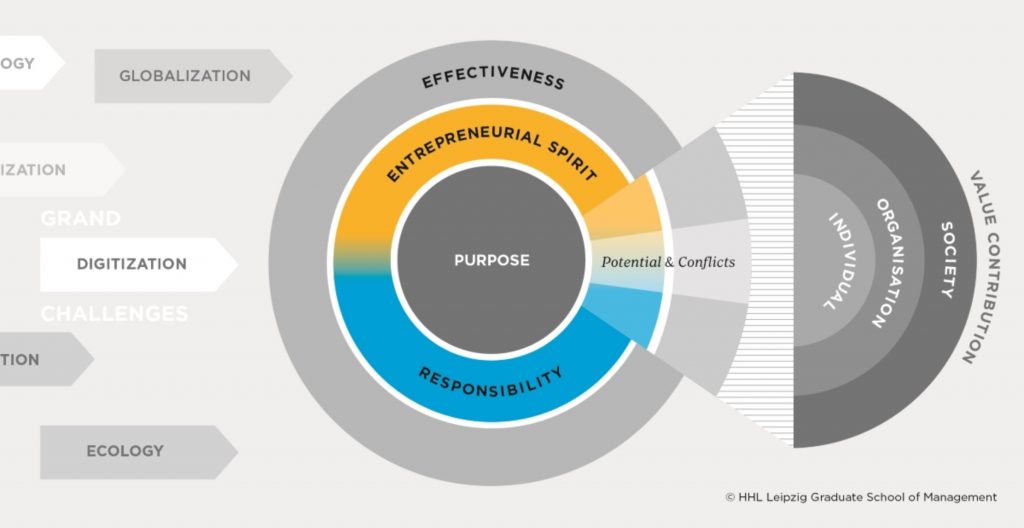
This essentially creates a situation of Potential and Conflict across the elements:
- purpose and responsibility
- responsibility and effectiveness
- effectiveness and entrepreneurial spirit
- entrepreneurial spirit and responsibility.
Purposeful Leadership Model
The Purposeful Leadership Model developed by Linkage, highlights the five Commitments leaders need to practice and achieve breakthrough results and serves as the foundation for the consulting leadership solutions.
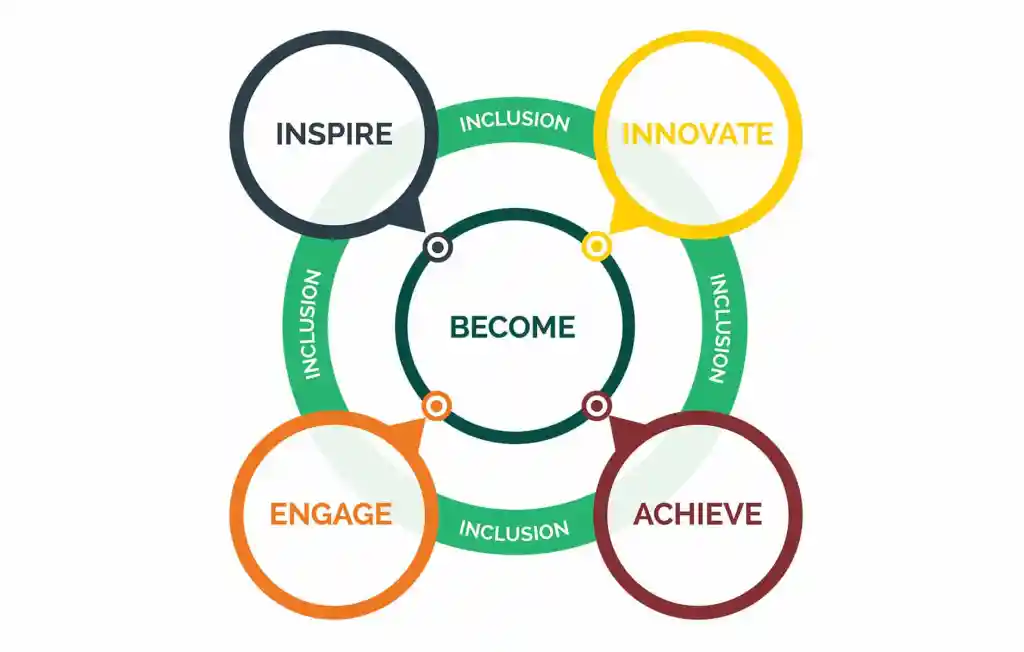
The model, highly focused on Inclusion, lists five components:
INSPIRE: Provides hope and inspiration for the future, and directs energy toward a bold vision.
ENGAGE: Identifies and offers opportunities to engage, contribute and thrive at work.
INNOVATE: Drives new thinking and creative freedom, and reimagines realities for competitive differentiation and success.
ACHIEVE: Accomplishes successful outcomes and delivers excellence by creating appropriate structure and clarity.
BECOME: Grows with determination, compassion, self-awareness and courage.
The concept of Shared Leadership has evolved, in recent years, as an alternative to the majority view whereby a leader is typical “alone in command”. It occurs whenever two members of a team, for example, engage in leadership activities jointly. The notion that leadership arises from group cognitions, interactions and behaviours rather than through a formally appointed leader has attracted attention from scholars and professionals. Along with this attention, a variety of terms has been utilized to describe the process. (Towler, 2019) Sometimes the concept of Shared and Distributed Leadership are used interchangeably, however, there is not a full overlap.
Even if we consider the many different authors that have been proposing such a model, it is difficult to establish one sole approach to Shared Leadership. The slide below, however, offers a view on the main dimensions that constitute this approach. ando also explain the reason why I have classified it here, as purpose is a critical element in the idea.

Sustainability Leadership Relational Model
Developed by the Sustainability Leadership Institute, this model “illustrates the interrelationship of behavioural themes practised by effective sustainability leaders.”

Each behavioral theme is explored in details with additional resources and related practices. The orientation for sustainability makes this a good example of a purpose oriented model.
System Leadership
This model has been created by Harvard Kennedy School in the framework of an initiative aimed at defining a Leadership Model integrated with the UN’s Sustainable Development Goals. “Transforming a complex system – such as the energy, health or food system – is a monumental task requiring coordinated action by people with very different viewpoints. Systems-change initiatives often engage hundreds of organizations – governments, companies, civil society organizations, worker associations, research institutions and others – combining their capacities to achieve a shared goal.
These large-scale initiatives are often driven and supported by people who fit a certain profile – those who are able to catalyze and empower collective action among others, rather than controlling or directing the action themselves. These people are increasingly described as systems leaders.” (Dreier, Nabarro and Nelson, 2019b)
The model integrates three lenses: System, Community and the Individual. And is developed upon many successful stories, especially deriving from NGOs and their successful actions. It is for this reason that I am listing this model under the Purpose oriented category, as there is a strong sense of direction needed to succeed in becoming System Leader.
“Systems leaders apply an unusual combination of skills and attributes to mobilize large-scale action for systems change. Like many leaders, they tend to be smart, ambitious visionaries with strong skills in management and execution. Unlike traditional leaders, they are often humble, good listeners, and skilled facilitators who can successfully engage stakeholders with highly divergent priorities and perspectives. Systems leaders see their role as catalyzing, enabling and supporting widespread action – rather than occupying the spotlight themselves”. (Dreier, Nabarro and Nelson, 2019b)
Vital Voices Leadership Model
Vital Voices is “a global movement that invests in women leaders who are solving the world’s greatest challenges”. The Vital Voices Leadership Model is a set of practices learned from the women leaders in our network. They have observed five common traits that together constitute a new model of leadership. This style is collaborative and innovative, and even though it is learned from women, its significance extends to all people. They built a truly aspirational model based on five pillars.
F. Applicative Leadership Models.
These models are specific for one organisation, and they often refer to any of the models presented above. Sometimes they also mix different model types and styles, often offering value-based behaviours and a choice of style. This cluster is the one that I would like to enlarge more, as I find it interesting how concretely, an organisation set their leadership style in action. However, this is often in confidential documentation. All listed models are publicly available.
AIESEC Leadership Development Model
AIESEC is a global student’s organization, present across the entire globe. It always focused, as part of its mission, in trying to build “future leaders”, and has developed a Leadership Development Model based on the idea of establishing World Citizens.

The model develops not just a vision in terms of what we identify as value-led behaviours, but also a way to build these. Two journeys are identified to make the maximum impact, an inner and an outside journey.

American Nurse Transformational Leadership

In this case, the model is derived from the American Nurse Association Nursing Administration: Scope and Standards of Nursing Practice which lists the characteristics of transformational leaders as open communication, inspiration, enthusiasm, supporting positive change, and empowering others through shared decision-making. The model identifies five practices that are now part of the ANA credentials system, and has a link also to self-assessment through the Leadership Practices Inventory-Self (LPI-S) Assessment..
AT&T Extraordinary Leader Model
The below model has been shared in 2011 on a SlideShare presentation. It is interesting to list it here because it shows how a competency-based model structure is implemented to align local team missions with the corporate model, which was named “Extraordinary leader”.
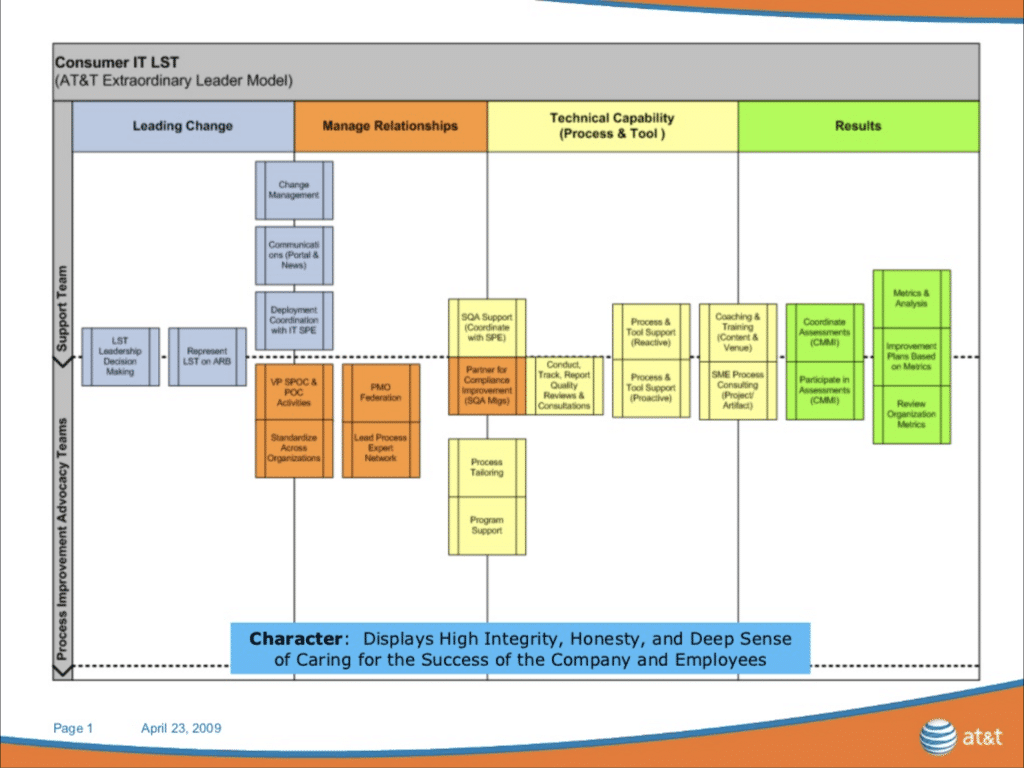
The model was implemented with the support from BTS and a case study is available.
Dräger Leadership Model- “WeLEAD”
Dräger is a pharma technology company based out of Germany. Its leadership model, WeLEAD, captures the guiding principles for leadership and collaboration. “The WeLEAD model was developed with the employee in mind. At the core of the model is “I build trust”. At Dräger, we treat each other with respect. Trust is given, and remains as we consistently do what we say. WeLEAD summarizes the expectations of our managers and allows us to collaborate more successfully by enabling each other to deliver results which create value for our customers, all while embracing our diversity”.
The model is based on a strong value for the organisation (trust) and a number of performance areas that can be evaluated for each leader within the organisation.
DSM Leadership Model
Royal DSM is a dutch-based chemical company active in health, nutrition and materials. The DSM Leadership Model specifies the behaviour DSM expects from its leaders and people managers. The model provides a common vision and language for leadership at DSM.
Developed in 2012, the model has a dedicated section in its annual report in terms of application within the organisation.
Healthcare Leadership College Leadership Model
Singapore’s Healthcare Leadership College has developed a competency-based model of Leadership to support government-led challenges of healthcare development. The result is the One Healthcare Leadership Model, which adopts a wheel representation with Values at the core, personal qualities as a second circle and a number of competencies organised in three focus areas (referred to by the ONE acronym).
IHI High-Impact Leadership Framework
The Institute for Healthcare Improvement developed a work focused on both Behaviors and a Framework for High Impact Leadership.
High-Impact Leadership Behaviors describe how effective leaders behave; while the framework suggests where effective leaders focus their efforts. It provides a visual map of the critical domains in which leaders of care delivery organizations, departments, and microsystems must focus their efforts and resources to drive improvement and innovation to achieve Triple Aim results for the populations they serve.
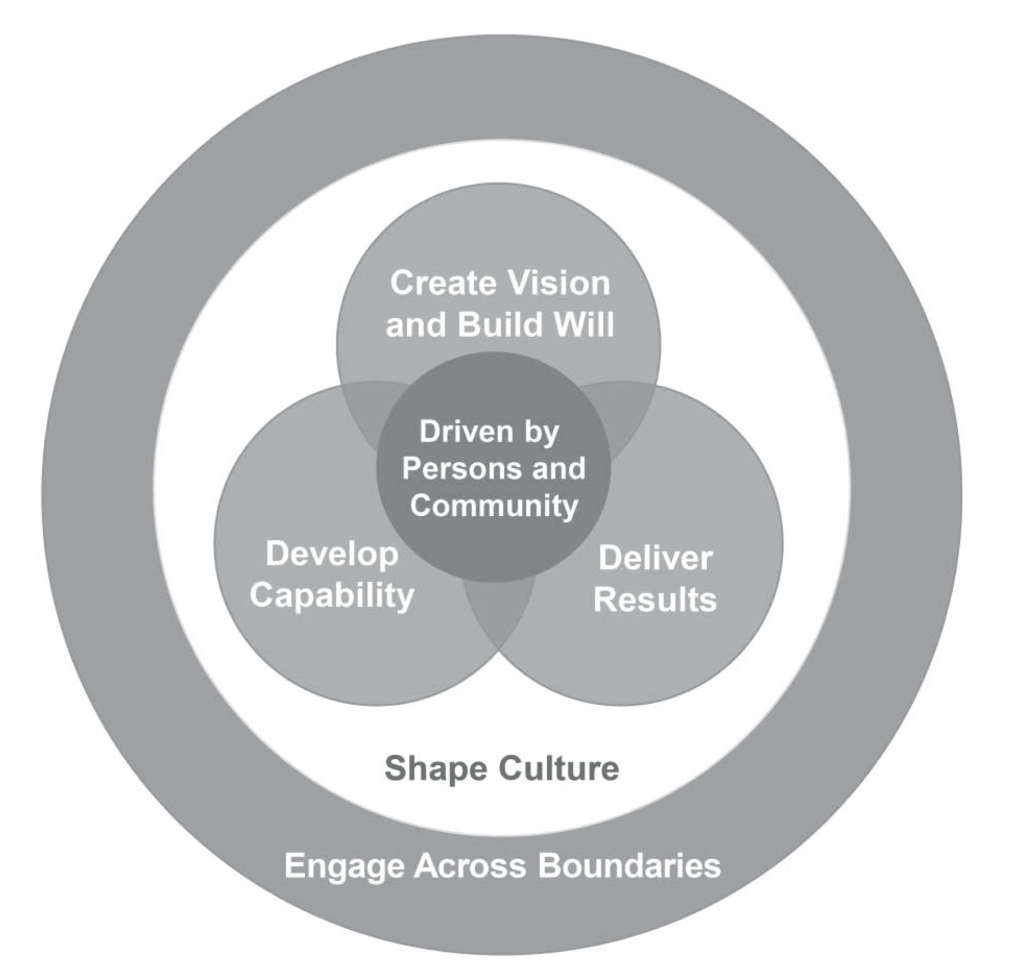
The framework is a practical method of focusing and organizing leadership efforts for leading improvement and innovation. It is built on social science leadership research and the collective learning of IHI.
Merck Good Leadership Model
Merck, the life science and chemical giant, has developed a Leadership Model based on a number of selected competencies focused on “Good Leadership“. This model has been rolled out up until 2018 in an effort to reskill the executive population of the group.
Purdue University Polytechnic Leadership Competencies
Clearly rooted in the T-Shaped Competency Model, this Leadership Model looks at competencies required for students to succeed in a changing environment, thought in terms of breadth, depths and required methodologies.
SAIPEM Leadership Model
SAIPEM is an Italian engineering company active in the petrol industry. It has developed a competency-based Leadership Model, partly linked to its core values.
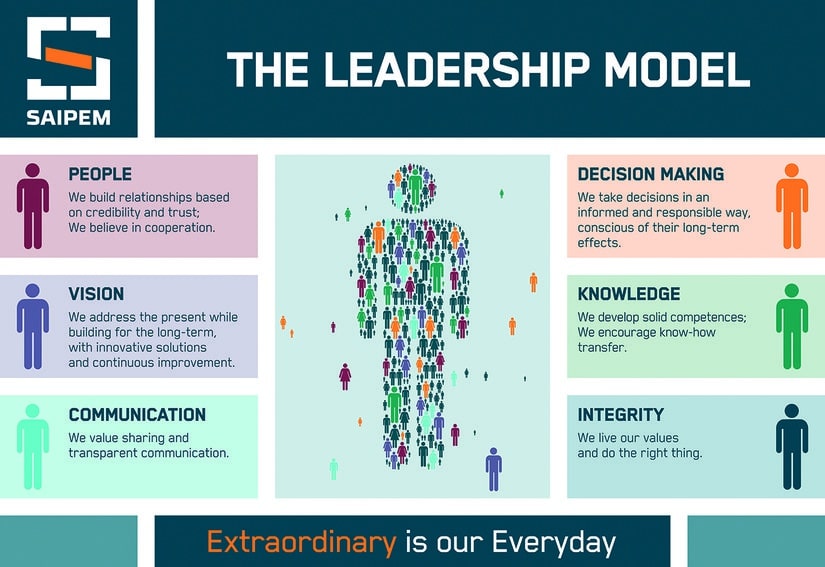
SingHealth Leadership Competencies
The SingHealth Group is a medical group based in Singapore. They have developed a Leadership Competency Model as part of their academy.
The model is based on three broad categories: Self Leadership, Team Leadership and Organisational Leadership. Each staff level has assigned different levels across the competencies.
(SOMC) Cognitive Behavioral Leadership (CBL)
The Southern Ohio Medical Center (SOMC) Cognitive Behavioral Leadership (CBL) model has been developed and implemented in a community hospital in a challenging rural environment. This model is based on the research from cognitive science as well as behavioural economics and evidence-based cognitive therapies (Stewart, 2012).
The model looks at replacing destructive feelings with constructive behaviours, also examining the current beliefs of leaders.
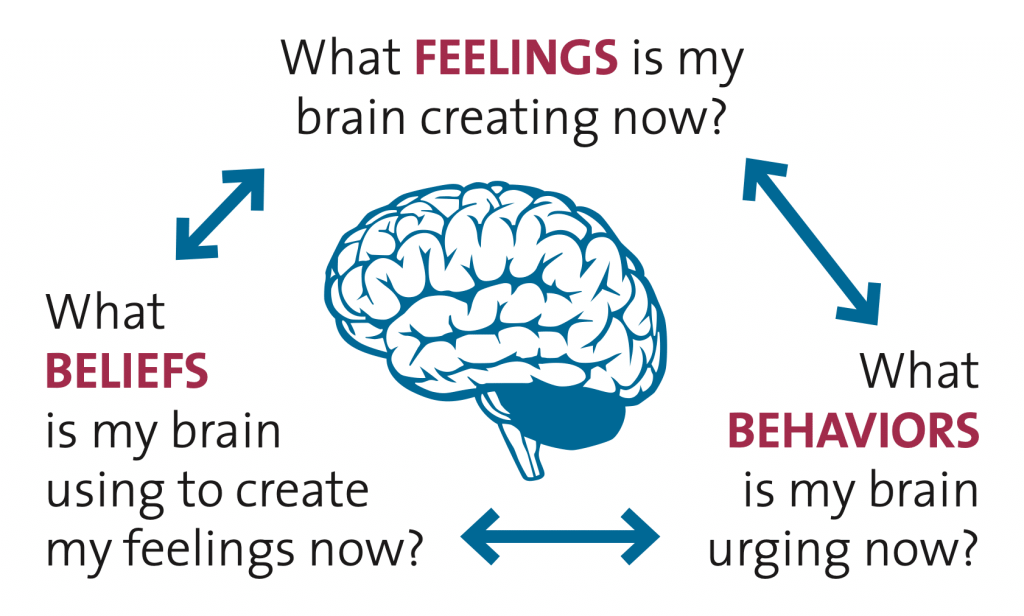
Trinity Western University Leadership Competency Model
This Canada based university has developed a Leadership Competency Model in the framework of its MA in Leadership. At the core of the leadership competency model is transformational servant leadership as a first-dimension competency of importance – coupled with leadership values. A second interesting dimension is the Higher Ordered Thinking & Analysis which is put around the core. Then nine specific competencies are listed that intersect and enable enhanced leadership capability.
University of Florida Leadership Competency Model
Also the University of Florida has built a wheel-like Leadership Model based on competencies, together with a whole set of resources that support development.
University of Minnesota Extension Leadership Model
This model is built as part of the University of Minnesota Extension Leadership Development Program. It is built on competencies identified as those that “leaders need to be effective in their communities”.
The one core assumption of the model is that leadership is about something beyond the leader themselves. Leadership creates public value and common good.
US Coast Guard Leadership Model
The US Coast Guard Leadership Model is based on 28 competencies, organised into fourc categories: Leading self, Leading others, Leading performance and change, and Leading the Coast Guard.
YMCA Cause-Driven Leadership
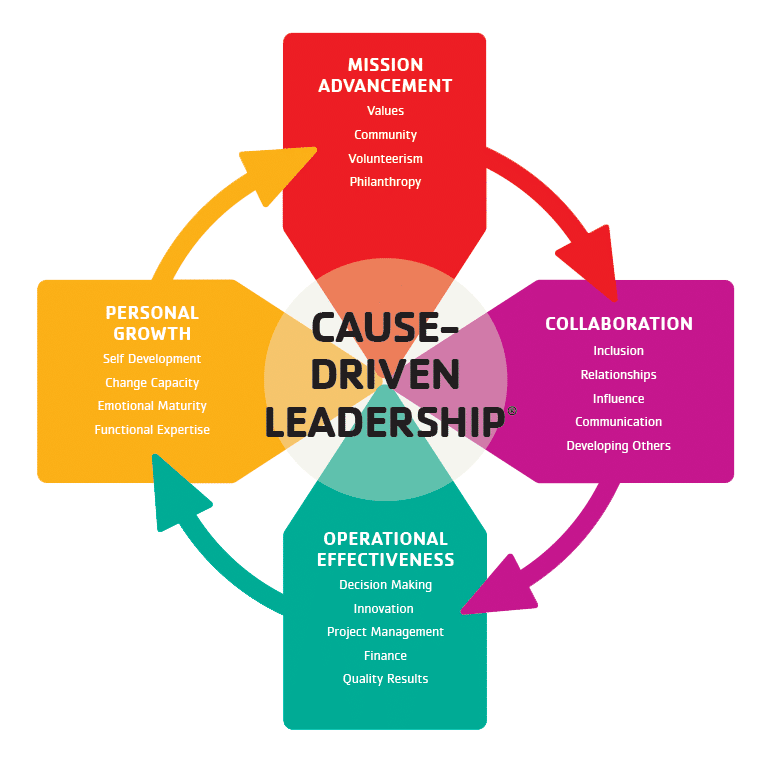
YMCA is a US non-profit network organisation and has developed a competency-based model of Cause-Driven Leadership. The model comprises 18 leadership competencies (leadership knowledge, skills, and behaviours required for success in the Y) and is organized by four disciplines of leadership: a) Mission Advancement. b) Collaboration. c) Operational Effectiveness. d) Personal Growth. The model is further organised by level of leadership within the organisation, thus also reflecting the role structure identified by the organisation. Although the title of the model seems to reflect a Purpose-linked Leadership Framework, the model itself is strongly competency-based, even if some of the competencies reflect the broader Cause the YMCA stands for (especially under the Mission Advancement discipline).
Summing Up
If you got here you already deserve a reward. But I hope you enjoyed the variety and complexity of these models, both in terms of content and visuals. As mentioned in the introduction, it is useless to try to find a general definition of leadership that applies to every context and every organisation.
The one element that, however, I want to stress out, is that to be (or become) a leader, there is an element of intentionality that is required. You can only be a leader if you want to be a leader. Then, every context and situation might require different skills, behaviours, competencies, attitudes and styles. These can help you be more effective as a leader. But won’t change the assumption of intentionality, which is the idea that I tried to explore in my concept of intentional organisation. This same element drives also a second conclusion: if being a leader is a personal choice, none can impede you to be a leader. Which means that leadership can be diffused in an organisation and is not linked to rank in a hierarchical structure.
In the next posts, I will address Culture and Purpose. It is not really possible to understand Leadership without the intersection with those two elements. So I expect frequent edits of this article as well.
Leadership within the Organisation Evolution Framework
I’ve recently introduced a Visual Framework that allows visualising all essential building blocks of Organisation Design. Leadership is the fifth building block of the Model. One of the objectives of Leadership is to create the needed Consistency among the different components of the model, in a dynamic and integrated way.
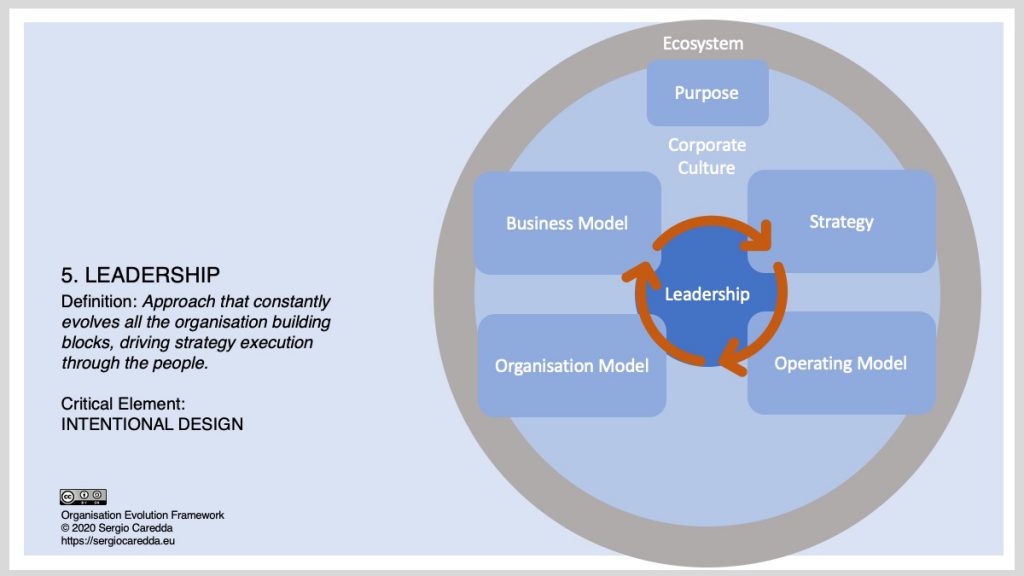
My working definition of Leadership is approach that constantly evolves all the organisation building blocks, driving strategy execution through the people.
It’s evident from the content of this long post that this is a very partial definition. But it highlights the keye elements that I wanted to portray:
- I don’t think there exists a “best” leadership style, as it is context-dependent.
- The focus of Leadership is on the Organization
- Leadership happens through the people.
- Intentional Design is what distinguishes a purposeful leadership that meets the needs of both the organisation and the people that belong to it.
There are probably many more elements, and I will try to look at these in a future research.
Introducing the Organisation Evolution Framework
Visual representation of Organisation Design building blocks and their dynamic relationships.
Now released in Version 1, open for feedback.
Again, feel free to give feedback, and suggest any model that I might be missing in this article, using the comment section below. Thank you!

Reference List
Cover Photo by Brooke Lark on Unsplash

